
Autumn 2024 | www.accpa.asn.au The official magazine of Why the voice of providers will be important this year IN THIS ISSUE Government and industry working in partnership Gain a competitive advantage with retirement living accreditation Take a trip to France with a SAGE study tour The right food and exercise driving better health in aged care residents How AI is transforming workforce hiring Tech priorities for aged care providers in 2024 MAKING HISTORY WITH SWEEPING REFORMS SUPPORTING VETERANS ON ANZAC DAY AND EVERY DAY




For residents living with type 1 or type 2 diabetes

Check glucose levels anytime, anywhere, with zero finger pricks.*
Real-time glucose readings sent straight to residents’ and carers’ phones.^
Clinically proven to lower HbA1c.1±
Subsidised for Australians with type 1 diabetes and Veterans (eligibility criteria applies). Trial now for $15.†

This product is indicated for measuring interstitial fluid glucose levels in people (age 4 and older) with insulin-requiring diabetes.
*Glucose readings are automatically displayed in the FreeStyle LibreLink app when the sensor has been started with the app, and the smartphone and sensor are connected and in range. Finger pricks are required if glucose readings and alarms do not match symptoms or expectations. ^The FreeStyle LibreLink app is only compatible with certain mobile devices and operating systems. Please check www.freestylelibre.com.au/compatibility for more information about device compatibility before using the app. Use of FreeStyle LibreLink requires registration with LibreView ± At HbA1c ~7% or higher. †The FreeStyle Libre 2 ‘$15 Trial Offer’ is a special offer and is only valid in Australia for a limited time. Limit of one $15 sensor per customer. Only available to new FreeStyle Libre 2 customers. Users must be registered and logged into their FreeStyleLibre.com.au account. For full T&Cs, visit www.freestylelibre.com.au/freestylelibre2-trial-terms-and-conditions.
1. Evans M. et al. Diabetes Ther. 2022; 13(6): 1175-85. The sensor housing, FreeStyle, Libre, and related brand marks are marks of Abbott. Information contained herein is for distribution outside of the USA only. Abbott Australasia Pty. Ltd., Abbott Diabetes Care, 666 Doncaster Road, Doncaster, Victoria 3108, Australia. ABN 95 000 180 389. ADC-89084 V1.0 ALWAYS FOLLOW THE DIRECTIONS FOR USE. READ THE WARNINGS BEFORE PURCHASE. Find out more at FreeStyleLibre.com.au LEARN MORE at FreeStyleLibre.com.au/How-To-Access
EDITOR’S NOTE
Welcome to our autumn 2024 issue of AgedCareToday – the official magazine of the Aged & Community Care Providers Association (ACCPA).
It’s a truly exciting year for aged care, one of the busiest for the aged services industry to date, as we forge ahead with implementation of numerous reforms. The industry has welcomed the Albanese Government’s invitation to work in partnership to deliver a better aged care system for Australia, including the vital issue of financial sustainability.
We’re delighted to put a spotlight on some of the tremendous work being done in aged care, through our carefully curated selection of articles.
And we’re grateful to our contributors – including many of our valued ACCPA partners and members – for taking the time to share the fantastic initiatives, innovations and ideas that are helping to move our industry forward.
Linda Baraciolli, Editor

5 EDITOR Linda Baraciolli ACCPA T: 1300 222 721 E: editor@accpa.asn.au HEAD OF COMMUNICATIONS & MARKETING Simon Page ACCPA T: 0424 604 447 E: simon.page@accpa.asn.au ACCPA ADDRESS The Aged & Community Care Providers Association (ACCPA) Suite 2, Level 2, 176 Wellington Parade East Melbourne VIC 3002 Australia ADBOURNE PUBLISHING PO Box 735, Belgrave, VIC 3160 ADVERTISING Neil Muir (03) 9725 9866 Robert Spowart 0488 390 039 Production: Sonya Murphy 0411 856 362 Administration: Tarnia Hiosan 0419 301 062 DISCLAIMER Aged Care Today is the regular publication of Aged & Community Care Providers Association (ACCPA). Unsolicited contributions are welcome but ACCPA reserves the right to edit, abridge, alter or reject material. Opinions expressed in Aged Care Today are not necessarily those of ACCPA and no responsibility is accepted by the Association for statements of fact or opinions expressed in signed contributions. Aged Care Today may be copied in whole or distributed among an organisation’s staff. No part of Aged Care Today may be reproduced in any other form without written permission from the article’s author. OPINION Charting a course through legislative reform 7 A year of reform 9 A milestone year for aged care 11 Lifting the governance capability of the aged care sector 13 Supporting veterans on Anzac Day and every day 15 NATIONAL UPDATE Are you ready for the strengthened Aged Care Quality Standards? 16 Sexual harassment legislation changes 19 Facing up to corporate data security 21 Why aged care training is so important for nurses 23 Retirement living accreditation 25 Leaders thinking, and going, outside the box 27 Intergenerational play takes off 29 HEALTH & WELLBEING The value of exercise and on-site gyms 33 Award-winning menus 35 Good nutrition starts at home 37 Developing behaviour support plans for people with dementia 39 Living well through the dementia journey at home 41 Commitment to positive ageing at Lifeview 43 Support for substitute decision-makers 44 Identifying the early signs of Parkinson’s disease 47 Double wave COVID-19 outbreak highlights need for vigilance 49 CULTURE & DIVERSITY Serving those who served 51 VMCH supporting marginalised older men 53 More than words 55 Achieving great outcomes for NDIS participants in aged care 57 Fostering the wellbeing of older people and their pets with pet care support 58 WORKFORCE
TRAINING The issues with substitute decision-making 61 Essential training in aged care rights 63 Empower your workforce for the best dementia care 65 How BlueCare has accelerated high-touch hiring with AI 67 Scheduling optimisation in home and community care 68 Uncover the power of employee offboarding 70 Shedding light on common cultural misunderstandings 73 Lifting leadership capacity for strategic change 74 GOVERNANCE & FINANCE Analysis of AN-ACC rate increase and industry trends 77 Making regulatory change easier in 2024 79 Aged care insurance outlook for 2024 81 Positioning for Support at Home program changes 82 Sustainable finance in aged care 84 Investing in the future of aged care 86 Financial risk in home care reform 88 The importance of finance governance in home care 89 The top five trends for aged care facility managers in 2024 91 Why should I choose your agency? 92 How to maximise supplier cost savings 93 Contents INNOVATION & TECHNOLOGY Technology and data for enhanced organisational governance 95 Tech priorities in 2024 97 Unlocking organisational agility with the 7 Cs 98 The digital revolution aged care has been waiting for 99 The secret to effective hiring 100 SilVR Adventures transforming aged care 101 Consumer attitudes to technology 102 BUILT ENVIRONMENT & DESIGN Excellence in joinery and custom furniture 103 Creating exceptional living environments 104 The science behind dementia-friendly design 105 Investing in tomorrow 107 Now is the time for age-friendly communities 109 WHAT’S NEW What’s new 110
&
The official magazine of Why the voice of providers will be important this year IN THIS ISSUE retirement living accreditation Take trip France with SAGE study tour How AI is transforming workforce hiring Tech priorities for aged care providers MAKING HISTORY WITH SWEEPING REFORMS SUPPORTING VETERANS ON ANZAC DAY AND EVERY DAY
Cover shot: Veteran Max Streeter at Spur Ranch, Picton, colocated at RSL LifeCare’s John Goodlet Manor. (See story on page 15.)

Discover DREAM
DEMENTIA RESPITE EDUCATION AND MENTORING
DREAM aims to boost the capacity of the aged care workforce to deliver quality dementia respite care, by delivering a program of online learning, a community of practice and faceto-face coaching for the aged care workforce.
Coaching – tailored support from one of our eight dementia support coaches who are located nationwide
Education – short modules with curated resources addressing key learning needs in dementia respite care
Community of Practice – an online forum for the exchange of ideas where you can learn from, and share insights with your peers
The DREAM Project has been created by the Wicking Dementia Research and Education Centre in collaboration with Dementia Support Australia.
DREAM is funded by the Department of Health and Aged Care.
For additional information contact us via email DREAM@utas.edu.au or scan below to visit our website dream.utas.edu.au


Charting a course through legislative reform
The voice of aged care providers is vital
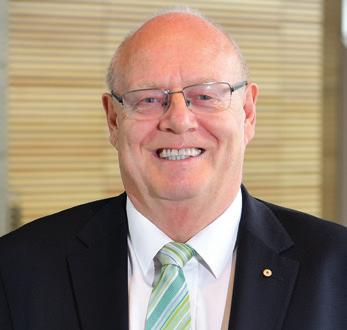
This year has begun as an immensely busy period for our sector and for Aged & Community Care Providers Association (ACCPA). In the coming months we will once again be tested as we navigate the impacts of major aged care legislative change.
At an organisational level, the ACCPA Board is also undergoing some change.
I’d like to congratulate the new Deputy Chairperson of ACCPA, Geraldine Lannon, who was elected by the directors at the ACCPA Board meeting on 13 February. She is the Chief Executive Officer of Baptcare and I am looking forward to working with her over the coming months.
The board has also begun the recruitment process to find my new successor and ensure a smooth transition.
As a sector, we are now reaching a pivotal time in the process of legislative transformation.
In response to the 2021 Royal Commission into Aged Care Quality and Safety, the Australian Government committed to developing and introducing a new, rights-based Aged Care Act to replace the existing Act which dates back more than a quarter of a century to 1997.
For the whole ACCPA team, and especially those in policy and advocacy, the start of 2024 has been a time of intense activity as we’ve reached out to members to hear their views and concerns.
The consultation period opened in December 2023 and the Government extended it by three weeks to 8 March 2024, allowing more time for review.
The details and practical implementation of the new Act will continue to dominate the sector’s thoughts for some time yet.
We want members’ voices to be heard as we all work towards the common goal: to elevate the standards of care for older Australians while also ensuring long-term sector-wide sustainability.
ACCPA will continue to play a key role in extensive consultations, working towards the target date set by the Australian Government of 1 July 2024.
The landscape of aged care has been evolving rapidly, driven by three imperatives: to address the needs of our ageing population, the economic realities this presents, and the evolving expectations of older Australians for aged care services (including in their home).
Despite some uncertainty and delay, we are hopeful that this process will ultimately provide the surety required to move forward with confidence and plan for a successful transition.
That’s why we have been encouraging members to be involved.
Throughout January, we distributed member surveys about the sequencing of reforms, to support opportunities to advocate on transition timeframes – a key area of advocacy.
ACCPA’s Policy and Advocacy team has held a number of member engagement workshops on the exposure draft of the new Aged Care Act. These were extremely well attended, provided excellent information and opportunities for members to share viewpoints and concerns.
I encourage and invite members to continue to share their examples and experiences. This data will help inform policy that is more likely to result in better outcomes for the transformation of the sector to meet Australia’s long-term aged care needs.
I’d also like to congratulate all ACCPA staff members, and the leadership team, who have been working above and beyond in these unprecedented times, responding to members’ concerns and the not insignificant amount of work required.
With the new Act presenting an opportunity for transformation and improvement, our sector is at the cusp of enormous change.
Close collaboration with providers is needed to establish realistic transition timeframes, which demand careful planning and consideration, informed by your insights.
If realistic transition timeframes underpin the process, then we can all emerge from this period of change into an enhanced Australian aged care era that is fit for the future.
Dr Graeme Blackman AO FTSE FAICD, Chairman, Aged & Community Care Providers Association
www.accpa.asn.au
7 OPINION









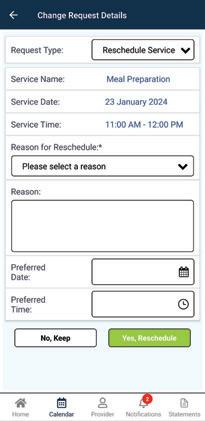












A year of reform
Getting funding right is critical for long-term
success
2024 will go down in history as the year of great reform in Australian aged care. Such significant reform will always be accompanied by challenges, but we must hold sight of the immense and exciting opportunities on the horizon.
With an ageing population in Australia, the aged care sector should be thriving. It should be vibrant, growing, and offering high-quality care for older Australians when and where they need it.
Financial reform is one of the critical building blocks to help us achieve that vision.
Aged & Community Care Providers Association (ACCPA) has been at the forefront of that conversation, even before the government’s Aged Cared Taskforce was formed.
We got the ball rolling when we hosted an Aged Care Sustainability Summit at Old Parliament House in June last year, bringing together 43 organisations representing consumers, aged care providers, unions, experts and government bodies.
From the summit, we produced an issues paper, which sparked a national conversation about co-contributions.
We keenly welcomed the release of the Taskforce report on 12 March, and I’m confident that the solutions presented will not only sustain the aged care sector but allow it to build and grow.
We will keep working hard with our members and the Australian Government to shape our collective efforts into meaningful, successful financial reform.
Another vital building block for the success of our sector is the new Aged Care Act. As a fundamental recommendation of the Royal Commission into Aged Care Quality and Safety, we welcome the new Act as a ‘once in a generation’ opportunity to reform and revitalise the sector.
Of course, this must be underpinned by sufficient consultation timelines and extensive engagement with the sector.

We’ve been holding workshops with members to go through the proposed legislation, and will continue to raise member concerns, suggestions and solutions to the government.
Recognising that the draft Act is not yet complete, we are also calling for ample time for consultation on the remaining sections and the final, full draft. This is a must, if the sector and the community is to have confidence in the process and the resulting Act.
Finally, our dedicated aged care workforce is the foundation on which we build a successful sector.
Further reform and government support is needed to build an aged care workforce that can meet the current and future needs of older Australians.
Members are unlikely to be shocked that a cumulative shortfall of 110,000 direct care workers is predicted by 2030. Most members are feeling the effects of workforce shortages right now.
That’s why we continue to advocate for flexible solutions that will help to bolster the aged care workforce in the short, medium and long term.
This includes better access to education, improved access to housing for care staff, particularly in rural areas, easier migration routes for overseas workers, and direct funding of targeted aged care workforce programs.
Never before has the Australian aged care sector faced such a significant suite of reforms. We know this brings complexity, but it also offers hope.
Hope that we can build a sector all Australians can be proud of. Hope that we improve the lives of our most cherished loved ones.
It might even be the year we get our mojo back.
Tom Symondson Chief Executive Officer
Aged
&
Community Care Providers Association
9 OPINION
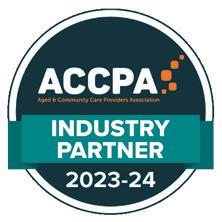

AGED CARE ADVISORY SERVICE HAS A RANGE OF SKILLS AND EXPERTISE TO SUPPORT APPROVED PROVIDERS WHEN THEY NEED IT MOST
ADVISORY SERVICES
• Our experienced Advisory Team has been appointed to multiple aged care providers.
• Extensive experience in consulting and senior operational roles ensures we are well positioned to support residential aged care providers who are required (often at short notice) to appoint an Eligible Advisor and/or Administrator.
• Together with resolving Sanctions and Notices to Agree, we have resolved some of the largest COVID-19 outbreaks in Australia.

• All consultants are experienced and insured as appropriate, are resident focussed, and experienced in mitigating serious risk.
• Consultants and Assessors experienced in both Residential and Home and Community services, can provide Independent Audits against the Aged Care Quality Standards for Residential and Community Care providers.
• Our service is inclusive of upskilling your existing team to create sustainability and develop skills across the team from the board room to the floor.
INTERIM MANAGEMENT – CLINICAL, OPERATIONAL AND SENIOR ROLES
• Aged Care Advisory Service can support aged care providers with unforeseen vacancies. Vacancies often cause significant disruption to business, leaving your home vulnerable to compliance issues, increased unresolved issues including funding gaps, complaints and human resource issues.
• Our interim management and clinical management services provides a solution that allows providers to focus on recruitment without pressure to “fill a role”.
• Care Planning and Assessment services can provide you with experienced RN resources to rectify identified gaps, whilst transferring sustainable skills and processes to your team.
• Additionally, these services can be used to provide coaching, and mentoring should you identify a team member who needs support to step into a more senior role, or who has skills gained in a non-aged care setting.


www.agedcareadvisoryservice.com.au
A milestone year for aged care Government
and industry working in partnership to deliver the benefits we all need

2024 is already a milestone year for aged care and I want to thank the sector for working so hard to provide greater care for older Australians and their loved ones.
On average, there is now a nurse onsite 98 per cent of the time, or 23 and a half hours a day in aged care homes across the country.
Thank you for responding so well to our 24/7 nursing initiative and boosting care.
In the past year there has been a reduction in the number of pressure injuries, physical restraints, significant unplanned weight loss, falls, polypharmacy and the use of anti-psychotics in aged care.
That’s what 24/7 nursing has always been about. Fewer falls. Fewer pressure injuries. Fewer avoidable hospital admissions.
We need to have more older people feeling safe and respected in aged care and that’s what we are seeing.
We’re also seeing improvements in the star ratings data, with fewer 1- and 2-star ratings and more 4- and 5-star ratings.
This is important as we address the findings in the Taskforce Report, which the Albanese Government released on March 12.
I want to thank the Aged & Community Care Providers Association CEO Tom Symondson for his excellent work throughout the Taskforce’s deliberations.
The Taskforce’s mission was simple: how can we get greater funding into a system crying out for it?
A significant demographic shift is upon us, and we must be innovative to address this challenge.
In the next 40 years, the number of Australians aged 65 and over will more than double and the number aged 85 and over will more than triple.
The number of centenarians is expected to increase six-fold.
Over the next four decades, Australia’s population aged 80 and over will grow to 3.5 million people.
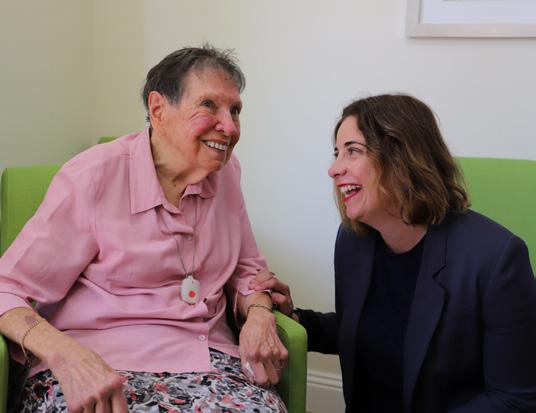
Our workforce is also under pressure, with people aged 15 to 64 years predicted to decline as a proportion of total population.
The Taskforce Report is the next step in our mission to deliver dignity to older Australians.
While it is not a Government report, the Government can confirm it will not impose any increased taxes or a new levy to fund aged care costs or change to means testing treatment of the family home for aged care.
We’re currently working through the Taskforce Report, engaging constructively with our parliamentary colleagues to deliver long-lasting, meaningful reforms.
The principles that guide the Albanese Government’s response to the Taskforce Report are to deliver benefits not just those in and entering the system now, but Australians who rely on the system as they age in decades to come.
We need to do that in partnership with you and so again, I want to thank all of you for the progress being made.
The Hon Anika Wells MP Minister for Aged Care
11 OPINION
Minister Wells shares a special moment with a resident during a recent visit to Uniting Arrunga Aged Care in Parramatta, Sydney.






INDUSTRY LEADING SCHEDULING
Sandwai’s schedule generation considers all parameters including client preferences and employee qualifications while ensuring compliance is met at every turn.
AUTOMATED AND STREAMLINED COMMUNICATIONS
Seamless and real-time flow of information between all three apps, taking end to end communications to the next level.
HIGHLY SCALABLE
Since implementing Sandwai, due to the scalability of the software, our customers have grown on average 45% year on year. With many of our customers having grown over 75% year on year since moving to Sandwai.
REPORTING, CLAIMING AND COMPLIANCE
Sandwai supports HCP, CHSP, NDIS, HACC, DVA, VHC, Brokerage, Private, Community Transport, state funding with reporting to relevant bodies, and automated claiming functionalities.
AUTOMATED TIMESHEET AND AWARD INTERPRETATION
Automated timesheet processes and highly configurable award interpretation to help organisations create faster and accurate payrolls
REDESIGNED EFFICIENT WORKFLOWS
Sandwai has many intelligent workflows that help you gain efficiency, quickly manage changes, and make accurate and informed decisions.
And much more.... Sandwai is the result of over 10 years of continuous development to cater specifically to the unique needs of Australian home and disability care providers.

sales@sandwai.com.au | 1300 795 133 | www.sandwai.c
Call us to learn more and to book a demo

The reports enable both the Commission and providers to identify the areas requiring uplift and gain insights into the
There is other help available for providers on this journey. Our workshops, suite of tools and online learning modules

Commission’s Governing for Reform in Aged Care Program.
Governing for Reform in Aged available to all people involved in or interested
There are many ways that you can participate in the Program. your ideas, ask questions and seek suggestions directly from
We also have podcasts for your commute and flip sheets for those who are time-challenged. And of course, we have an extensive online library of learning modules, templates and
If you have not already done so, I encourage you to consider the program for yourself, your management, future leaders
13 OPINION
Are you struggling with:
RN 24/7 & Care Minutes?
Experienced Quality & Care Managers / Coordinators?
Skills & Resources Shortages?
Workforce Shortages & Leave Cover?
We can provide Expert Clinicians / Registered Nurses to fill short or long term gaps - whether you have a hard-to-fill role, need leave coverage or have fallen behind in a certain area, we can:
Support and lead your clinical team and collaborate with your multidisciplinary team
Provide continuity of care including covering workforce gaps for critical roles within facilities to support clinical governance, compliance and outcomes for consumers
Complete care plan reviews, assessments and documentation
Support onsite operations of your facility in a variety of capacities
Complete technical clinical tasks such as wounds, oxygen, catheter changes, diabetic management, pain management etc
Manage the clinical needs of the resident including referrals and intervention implementation
team@providerassist.com.au providerassist.com.au 1300 419 119
Supporting veterans on Anzac Day and every day
Dedicated help based on understanding

Anzac Day is a poignant reminder of the sacrifices our veterans have made for our freedom – both past and present.
At RSL LifeCare, we are immensely proud of the work we have done and continue to do in supporting veterans since our inception in 1911, when we assisted homeless and destitute veterans who came home after defending the British Empire. Today our services have expanded to include caring for veterans and seniors across NSW, the ACT and southern Queensland through our retirement living, residential care and home care solutions – offering support based on a deep understanding of their complex and varied needs.
What many don’t realise is that RSL LifeCare’s purpose (to enrich the lives of veterans and seniors) has remained unchanged since those heritage days back in 1911. We are still committed to assisting veterans in a variety of ways, having more than 450 veterans for example who call one of our retirement living villages home.
Our dedicated RSL LifeCare Veteran Services team help veterans with thousands of Department of Veteran Affairs (DVA) claims, advocacy, employment and financial assistance, including some who are transitioning from military to civilian life.
This transition remains a challenge for many. Research that we conducted late last year found that 43 per cent of Australians believe more needs to be done to provide adequate support for veterans, including mental and physical health care and financial assistance. These findings emphasise why it’s important for us to reflect on the support our veterans need, not just on Anzac Day, but every day.
I am enormously proud of the work our RSL LifeCare Veteran Services team do to support our veterans. In 2023, more than 3,600 were assisted through our four Veteran Wellbeing Centres in NSW with over $682,516 provided in financial assistance, 220 provided with employment support, and 4,460 claims lodged with the DVA.
At the heart of our RSL LifeCare Veteran Services is the development of Veteran Wellbeing Centres (also referred to as Veterans’ and Families’ Hubs), currently operational in the Nowra, Riverina, Northern Beaches and Hunter regions. These centres offer a comprehensive range of services, aligning with the DVA Veterans’ and Families’ Hub model
which consists of the seven key elements of wellbeing: health; education and skills; housing; social support; employment; income and finance; and recognition and respect.
Our centres operate on a holistic model, with activities such as art therapy and yoga to promote physical and mental wellbeing as well as providing assistance with employment through our partnership with the RSL Queensland Employment Program, homelessness, housing support, DVA claims and advocacy and more.
I’m thrilled that we are working closely with the DVA to meet the needs of a much larger number of veterans and their families in the future, made possible through the Federal Government’s $46.7 million commitment to deliver 10 new Veterans’ and Families’ Hubs across Australia.
We have already expanded our Veteran Wellbeing Centre network with two new locations approved to go ahead in the Hawksbury and Central Coast regions, and we value the support of RSL NSW and the RSL sub-branches in these important projects.
These new hubs will enable RSL LifeCare to expand on our existing ‘hub and spoke’ model, developed in consultation with the local communities and other ex-service organisations, and through the network of local RSL sub-branches.
Additionally, our Spur Ranch Equine Program located in Picton enables veterans to learn new skills and foster new social connections in a safe space through horse handling courses and multi-day rides.
This program has had a positive impact on 84 veterans who participated in 2023 with one commenting that “I didn’t want to keep talking about my trauma and stressors, I needed something that lifted me. The horses are what help me.”
Each of the veterans that we assist through our centres and programs leaves a mark. Seeking support is deeply personal and can be hard, but incredibly rewarding and often life changing.
As we strive to make a difference for even more of our veterans and their families, let Anzac Day be a reminder of their service and the importance of maintaining support all year round. Lest we forget.
Janet Muir, CEO, RSL LifeCare www.rsllifecare.org.au/veteran-services
15 OPINION

Are you ready for the strengthened Aged Care Quality Standards?
A snapshot of the key new concepts and enhanced expectations
A key element of the aged care reform agenda is a new Aged Care Act and a set of strengthened standards, designed to place older people at the front and centre of care planning and delivery, with greater protections.
The initial draft of the revised Standards underwent wide consultation along with a pilot involving a variety of providers, resulting in a final draft being released in December 2023.
While the final wording is subject to passage of the Aged Care Act through Parliament, the Aged Care Quality and Safety Commission has indicated any further changes are expected to be minor.
Analysis of the final draft indicated a large proportion of the proposed new Actions are aligned to, or expand on, requirements under the current Standards.
In addition, some obligations from other instruments such as the Quality of Care and User Rights Principles have been included.
The explicit and detailed nature of these Actions provide greater clarity for providers but are likely to require a review of practices, updates to policies and procedures, and additional staff training.
Standard 1: The Person
The older person is at the centre of the strengthened Standards with the required Actions and themes of Standard 1 flowing through to all other Standards.
This results in a more detailed focus on delivering service that is structured around the needs, preferences and choices of each person.
Language throughout the Standards including changed terminology from ‘consumer’ to ‘older person’ demonstrates that people in aged care should be considered active partners in their own care rather than being a recipient of a service.
It introduces new concepts of ‘trauma aware’ and ‘healing informed’ care and stronger requirements on understanding
communication needs, transparency in agreements, fees and invoicing, informed consent and supported decision-making.
Standard 2: The Organisation
While Standard 2 aligns with many of the current requirements it has expanded expectations that include:
■ partnering with older persons in the design and improvement of care and services
■ business and strategic planning including for the workforce
■ key systems including quality, risk, incident and information management
■ engagement with and support for the workforce including maintaining psychological safety
■ competency-based training on specified topics
■ emergency and disaster management.
Standard 3: The Care and Services
Similarly, this Standard replicates and builds on existing requirements.
Meeting the specific needs of people living with dementia using evidence-based practice and building on their strengths is a feature along with a focus on reablement and maintaining function for all older people.
Other changes include:
■ specified events that will trigger a review of care and services plans
■ expanded requirements for advance care planning
■ support for workers to recognise and respond to risks and identify deterioration
■ involving older people in selecting their workers
■ effective communication including non-verbal communication
■ having connections with specialist dementia care services.
Standard 4: The Environment
Current requirements have been expanded to include:
■ separating the Actions for residential vs home care settings
16 NATIONAL UPDATE
■ specifying that the residential care environment is fit for purpose, accessible for people with a disability and has safety risks ‘unobtrusively’ reduced
■ detailed Actions for infection prevention and control that align with regulations (e.g. the need for an Infection Prevention and Control Lead).
Standard 5: Clinical Care
This Standard contains new and enhanced requirements which mirror many of those in the National Safety and Quality Health Service Standards such as:
■ specific obligations relating to clinical governance including the role of the governing body, workforce capability and new Actions to implement a digital clinical information system
■ detailed and specific Actions that focus on managing key risk areas of swallowing, continence, mobility, nutrition and hydration, mental health, pain, oral health, pressure injuries and wounds, sensory loss, cognitive impairment and palliative and end-of-life care
■ ensuring care is comprehensive and co-ordinated.
Standard 6: Food and Nutrition
Food and nutrition are a particular focus with a dedicated standard (applicable to residential care providers only) covering the dining experience and the older person’s sense

of choice, involvement and enjoyment of mealtimes as well the food and drink provided.
This Standard requires a partnership with older people in developing menus and increasing their sense of choice on the food and drink available to them, reflecting broader themes across the revised Standards.
Standard 7: The Residential Community
This standard will also only apply to residential care services. Key changes include:
■ providing lifestyle and activities with a new Action to minimise boredom and loneliness
■ an increased focus on psychological safety, choice and control over who enters the person’s room, including when entertaining visitors in private
■ managing transitions between care services.
ACCPA has many options to help you prepare for these changes, from free advice to tailored consultancy. ACCPA also provides system solutions for safety, quality and compliance management giving providers a helping hand to compliance with the new standards, whether ACCPA members or not.
Amanda Allen, Head of Services, Aged & Community Care Providers Association www.accpa.asn.au
17 NATIONAL UPDATE
A leading Insurance and Risk specialist in Aged Care 1300 650 540 ansvar.com.au Trusted insurer for over 600 Aged Care service providers Specialists in protecting and supporting Residential Care, Home Care and Retirement Living Tailored insurance solutions that reflect your unique care services Specialist Risk Management Consulting & Resources Check out our new video featuring industry specialists sharing their insights about how best to manage Open Disclosure and our latest Risk Alert on the topic. 2023 -24
Contact: www.throne.com.au or 02 6280 6851
3-in-1 Rail
Splayed
Fold-Down
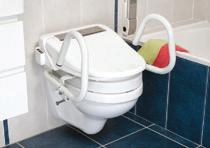
DIGNITY, INDEPENDENCE AND CONFIDENCE FOR EVERYONE
THRONE SPACER
THE ULTIMATE AND MOST VERSATILE TOILET SEAT RAISER
The Throne Spacer has been developed to add height without changing the appearance of a standard toilet and toilet seat, and offers comfort and safety.



The functions of the ‘Standard’, ‘Splayed’ and ‘Fold Down’ rails have been incorporated into the ‘3-in-1’, making it the most convenient toilet support system on the market.
The benefits of the Throne Accessories ‘3-in-1’ Rail System include:
This rail replaces the previous three models
Simplified ordering... etc
The new Throne Accessories ‘3-in-1’ Rail System will be of great advantage for:
Equipment loan departments in hospitals, schools, respite care and hospice facilities
Nursing homes and retirement villages
Hotels, motels, hostels, residential and other accommodation outlets
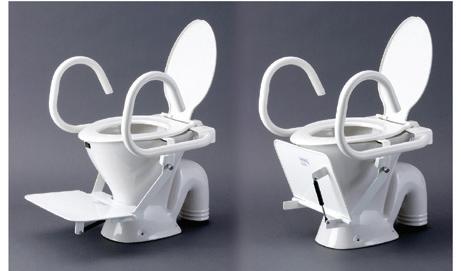
CHILDREN’S RAIL AND STEP
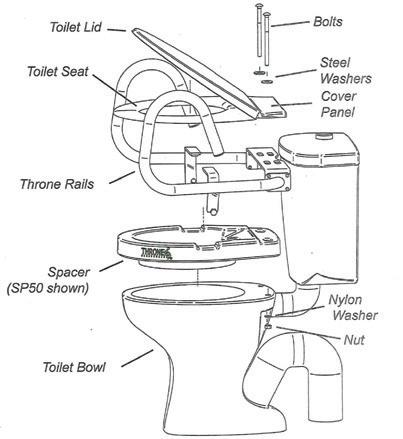
The children’s rails assist them with their safety and independence. The step attaches to the rail and in many cases the child is able to get off the toilet without any assistance. The step can fold up against the bowl when other people wish to use the toilet. Throne Accessories also produce a range of smaller rails to fit infant toilets used in pre-schools and kindergartens. The step is suitable for any of the Throne Support Rails.
Two sizes! 50mm & 80mm heights
The best option OT’s could hope for!
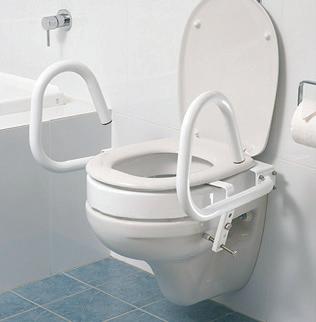
Use with or without Throne Rails
The Throne Spacer fits under the toilet seat
Unobtrusively integrates with the bathroom decor
Raises the height of toilet seats and electronic bidets Easily installed and conveniently transportable
Spacers and rails are available from reputable healthcare suppliers
BARIATRIC TOILET SUPPORT RAIL
This particular Bariatric Rail model meets the needs of the larger built person. The handgrips are supported by adjustable legs that are firmly positioned to the side of the toilet by rubber-capped feet to prevent tripping. The Bariatric model comes in polished stainless steel.
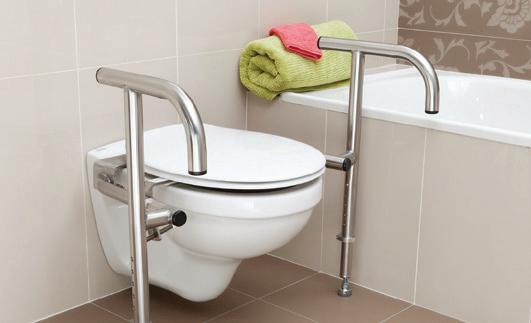
•
•
•
Standard
Sexual harassment legislation changes
What you need to know

Legislation against sexual harassment in the workplace has significantly changed in recent years – and it is incumbent upon employers to understand their obligations.
There are two key amendments you should know about:
■ A new ‘positive duty’ on employers and persons conducting a business or undertaking (PCBUs) to eliminate workplace sex discrimination and harassment commenced in December 2022.
■ The Australian Human Rights Commission (AHRC) was given the power to enforce compliance with the ‘positive duty’ requirement under the Sex Discrimination Act 1984 (Cth), effective from 12 December 2023.
The positive duty requirement is for all employers to take “reasonable and proportionate measures” to eliminate the following in a work context: sexual harassment, sex discrimination, sex-based harassment, conduct that creates a hostile workplace environment on the ground of sex; and victimisation of persons in certain circumstances.
The requirement to take “reasonable and proportionate measures” lifted the bar for compliance higher than it has been before. As a result, it is currently possible for an employer to be in breach of this legislation even if there is no reported incident of sexual harassment in their workplace.
Under the most recent changes, the AHRC gained the power to conduct enquiries and provide recommendations, issue compliance notices, apply to federal courts for an order to direct compliance with a compliance notice, and enter into an enforceable undertaking.
A complaint to the AHRC can lead to it becoming involved and exercising its new powers.
It is important for aged care providers to have a plan in place on how they are going to reach compliance (if they are not already at that point) and how they are going to maintain compliance over time.
As with many operational areas of aged care, compliance is something that has to be proactively managed to be maintained. The AHRC has issued Guidelines for Complying with the Positive Duty under the Sex Discrimination Act 1984 (Cth) which sets out four Guiding Principles and seven
Standards for how they expect employers to comply with the legislation.
This can be found on the AHRC website along with a number of other resources. It is recommended that aged care providers utilise this document when creating, implementing and maintaining a compliance plan. The Respect@Work website also has resources that can assist providers with compliance.
The risk assessment AHRC Standard when applied in aged care has its own particular dynamics. Aged care employees can work with residents and clients and interact with their friends and family while they work. Even though these individuals are not employees of the provider, their actions towards employees can result in a breach of the positive duty requirement on the provider as an employer.
Aged care employees can also be working in client’s homes and, as with other work health safety risks, the provider has less control over the risks that exist in their working environment. With these challenges it is especially important for providers to undertake effective risk assessments so that hazards can be identified and actions taken to prevent staff from being exposed to them.
To help our members to achieve compliance with the new legislation, the Aged & Community Care Providers Association (ACCPA) has partnered with the Australian Business Lawyers and Advisors (ABLA) to offer to ACCPA members the Managing Sexual Harassment ‘Positive duty’ Toolkit at a discounted price.
It features a ‘How-to Guide’ on managing sexual harassment and sex-based harassment ‘positive duty’ in the workplace; seven short instructional videos to guide you through the process; and 15 tools including checklists, templates, processes to follow, draft emails and a policy document to download and use.
The feedback so far from ACCPA members is that they have found the toolkit to be very useful and it has saved them significant time and research that would have been needed to prepare the documents from scratch.
What’s most important, is that providers stay informed, up-todate, and compliant with this new legislation.
Claire Bailey, Head of Workplace Relations, Aged & Community Care Providers Association www.accpa.asn.au/employment-relations
19



Facing up to corporate data security
New
workshop offers support to aged care leaders
In today’s world, everything is digital. Increasingly, information and systems are becoming an organisation’s greatest asset, as well as their greatest threat.
Organisations of all sizes have been the target of industrious criminals, exposing insufficient data management and security failures.
For some, this loss has been limited, but impactful and might include stolen social media accounts and compromised membership databases.
For others, there has been a more significant loss of client personal data and confidential commercial communications, which we know can result in devastating personal consequences for vulnerable individuals.
When a breach occurs, corporations must inform those affected, with advice that includes recommendations to take action to replace key identification – such as passports and driver’s licenses – and changing passwords for banking and superannuation accounts.
However, organisations have been reluctant to publicly disclose any cyber-attacks. This can be because of potential impact on their reputation, customer loyalty and financial stability.
Aged care providers have not been immune from cyber-attacks in recent years. With providers delivering a range of services, they are required to collect and document critical personal information including key safe codes and medical details, which may be accessed or on-sold in a cyber security breach.
According to the Australian Cyber Security Centre (ACSC), a major aged care provider was recently the victim of a ransomware attack with a partially successful attempt to encrypt and steal confidential data in order to seek ransom payment.
This underscores the importance of securing your client and business information, and ensuring you continue to upgrade your data security using the latest technologies available to you.
What you can be certain of, is that hackers will always be improving their methodologies, so you need to stay ahead of the game.
Perhaps addressing cyber security issues feels like a big task and you are unsure where to start, so that’s why it’s important to have a team of staff trained in this area, as well as the right systems and processes in place.
Providers need to be confident regarding responsibilities in relation to the information that your organisation holds, and your business capacity to both repel and respond to attacks – sometimes simultaneously and across numerous operating contexts.
Under the Australian Government Security of Critical Infrastructure Act 2018, health care including nursing care, is listed as a critical sector, and providers are advised to be aware of the cyber security obligations under this Act.
ACCPA in partnership with the Governance Institute of Australia, is offering ACCPA members a workshop on Cyber Security Risk, to support C-suite executives to understand the impact of this rapidly increasing threat to business continuity and potential personal liability.
Not to be missed, the online workshop will take place on 17 April 2024, and will be facilitated by leading cyber security expert Robbie Sinclair.
“Today, boards need to be aware of their responsibilities, noting that cybercrimes can result in financial, legal, regulatory, reputational, and customer impacts,” says Robbie.
“At its most devastating, a significant cyber security incident could mean the end of business operations.
“Community expectations have changed, and organisations can no longer afford to overlook cyber security risk.”
Tegan Roberts, Manager Learning & Professional Development, Aged & Community Care Providers Association www.accpa.asn.au/event/cyber-security-risk
21
Nutritionally balanced meals for healthy seniors.
With over 250 meals developed by dietitians and prepared by chefs, Lite n’ Easy offers a delicious, food-first approach to promoting independence, choice & health for older Australians.
Lite n’ Easy have also introduced a new range of meals called My Choice which have been designed to meet the specific nutritional needs of older people who may have a reduced appetite. My Choice meals provide the same energy and protein (an essential nutrient for seniors) as our standard dinners but in a smaller portion, making them easier to finish.
Lite n’ Easy partners with many Home Care Package providers across Australia, so that seniors can have access to even more affordable healthy, delicious meals. If eligible, HCP recipients could save 70% off the cost of their meals.
Lite n’ Easy’s service is flexible with no lock-in contracts or subscriptions, so customers are free to order week-to-week as needed.
In addition to supporting HCP providers and recipients, Lite n’ Easy is now also supporting the broader Aged Care sector by providing meals in bulk to respite centres, residential aged care facilities, hospitals and many other organisations looking for alternative healthy meal solutions for their employees and residents.
For an effective and affordable meal solution to suit your business needs, please email Lite n’ Easy at: agedcare@liteneasy.com.au
Visit www.liteneasy.com.au/my-choice or call 13 15 12 for more information.

“It’s given me back my independence. It’s given me back my health. It’s just wonderful.”

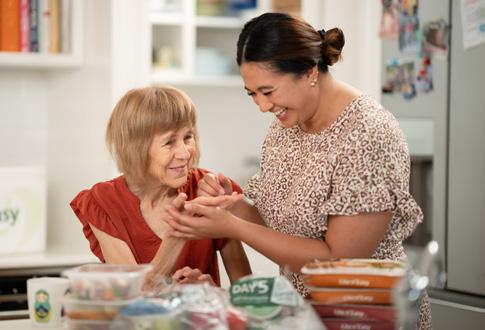
“The meals from Lite n’ Easy are a tremendous help for my health and independence - one of the best food delivery services I have tried.”
Independence | Choice | Happiness
Aunty Barb & her daughter/carer, Yoni Penny - QLD NDIS participant
Why aged care training is so important for nurses
A Q&A with a recent graduate
At the Aged & Community Care Providers Association (ACCPA), along with other training providers, we often espouse the value of learning programs, however what really offers the most insight, are the learners themselves.
No matter how good we tell you it is, learners who have experienced the benefits of upskilling, can say it better.
Sofia Prodromou, Graduate Registered Nurse at Fronditha Care in Thornbury Victoria, recently completed ACCPA’s Graduate Nurse Transition to Aged Care Program.
This innovative program, offered as either a 12-month or six-month course, is for graduate Registered Nurses or graduate Enrolled Nurses in their first year of practice, or transitioning Registered Nurses who are new to the sector.
Developed in partnership with clinicians, our three transition to practice programs are designed to support nurses to become confident, safe and competent in the aged and community care sector.
Rather than tell you any more, we asked Sofia to offer a nurse learner’s perspective.
Q: Do you think the training was important?
A: The Graduate Nurse Transition to Aged Care Program was essential for my knowledge and confidence.
Often, in aged care, the work pressure is so large, that we complete tasks not always knowing, or having the time to think about, the reasoning behind them.
This program helped me unpack those tasks and provided me with the knowledge to do so during my practice.
Q: Did the training provide enough flexibility?
A: What I loved about the program was the flexibility. Since COVID-19, we have been very short staffed at work and somehow, even though Tuesdays are my designated days off, I always found myself working on a Tuesday and missing most, if not all, the live sessions.
As all the sessions were posted online, I was able to listen to the lecture on my way to and from work. For me it worked best to listen to the lectures in the car. It would put me in the ‘nursing’ zone before work and I would be excited to work and think critically about the residents. Listening to the lectures on the way back, helped me reflect on my practice and come up with ideas of things to do on my next shift.
Q: What did you enjoy the most?
A: The program kept me engaged, enthusiastic and curious about nursing. I loved being able to go to work and get the real hands-on experience, and applying my learning. It made me want to learn even more, and I’ve now enrolled myself in a postgraduate certificate in aged care.
As a result of the training, I feel more confident in my skills and myself because I have a strong learning basis. I frequently find myself discussing clinical issues with the doctors and care coordinators, something I would not even think of doing before I started the program.
Q: What about the quality of resources?
A: The materials were always very relevant to our work, giving the smaller details that we often don’t talk about or learn in nursing school. For example, learning that soaking dentures is not always good, or that nutrition plays an important role in wound healing, or more about antimicrobial stewardship.
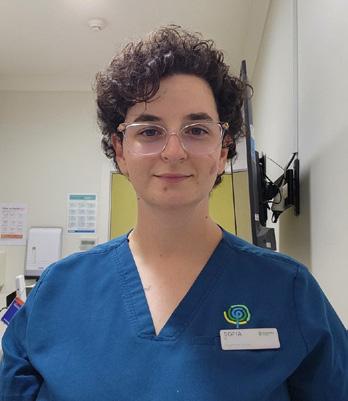
Another example, no nursing school will teach you about aged care funding or quality indicators. Having the knowledge and understanding of how aged care operates and gets funded helped me understand what my organisation expects of me. It helped me reclassify my priorities in order to provide better care to the residents.
Q. Has it made a difference to your work?
A. I now feel confident to plan care, implement strategies and provide excellent care for my residents. My clinical coordinators and managers have shown trust in me and appreciate my hard work, they slowly allowed me to take charge of shifts when no-one else, more senior, was available.
I did my first in-charge shift six months into the course. We had an unexpected death on that shift and I handled the situation very well. The manager approached me the next day to debrief and congratulate me.
A year after starting this course, I was frequently given in-charge shifts, attending doctor’s rounds, managing the working roster, planning care and dealing with complaints or concerns from families. I never thought I would do all this, let alone only one year after starting my nursing career.
Alexandra Harrison, Information Coordinator, and Linda Baraciolli, Aged Care Today Editor, Aged & Community Care Providers Association
www.accpa.asn.au/nursing
23 NATIONAL UPDATE
Registered Nurse Sofia Prodromou.


Retirement living accreditation
Your competitive advantage and value proposition
It has never been more important to become a fully compliant and registered retirement village under the Australian Retirement Village Accreditation Scheme (ARVAS).
As more Baby Boomers look for safe, active and engaging communities, there is a strong penchant for villages that are well run, have a good reputation and can demonstrate a continued commitment to quality improvement.
Increasingly, prospective buyers are becoming aware of the accreditation scheme and despite us not being a consumer organisation, we often get calls asking if a particular village is accredited.
For villages that have taken this step, there’s no doubt it offers a competitive market advantage. And if your village hasn’t yet signed up, here’s what you need to know.
Retirement Living Code of Conduct
The Retirement Living Code of Conduct developed and supported by the Aged & Community Care Providers Association (ACCPA) and the Retirement Living Council helps operators to provide a trustworthy and high-quality service for those living in, and considering moving to, a retirement community.
The Code is focused on the wellbeing of residents, fairness in marketing and sales practices, and maintaining good relationships with residents and stakeholders.
It includes mechanisms to improve the handling of complaints and disputes in a way that complements existing dispute resolution processes, as well
as guidelines on transparent processes when residents move out.
Signatories to the Code share a vision to promote and protect the independence, privacy, dignity, happiness, safety and security of older people through the provision of specialised, quality, fit-for-purpose housing, with tailored support services within a community environment.
Australian Retirement Village Accreditation Scheme
The Australian Retirement Village Accreditation Scheme (ARVAS) is the national accreditation scheme for the retirement living industry, developed by ACCPA and the Property Council of Australia (PCA), representing the owners and operators of retirement communities.
The ARVAS Standards Second Edition reflect the evolving service offerings within retirement communities across seven key quality areas:
■ Community Management
■ Human Resource Management
■ Resident Entry and Exit
■ Resident Engagement and Feedback
■ Environment, Services and Facilities
■ Safety and Security
■ Resident Care (when applicable)
The ARVAS Standards are designed to work directly with the Retirement Living Code of Conduct, which is the sector’s self-assessment tool.
As such, any organisation wishing to apply for accreditation under ARVAS must be an active subscriber to the Retirement Living Code of Conduct.
ACCPA, through its Safety & Quality Management System, has already
done the hard work for operators planning to become accredited through ARVAS, with a full suite of policies and procedures mapped directly to the Code and ARVAS now available for our subscribers.
These policies and procedures will support retirement living operators to comply with the both Code and ARVAS.
The ARVAS standards are supported by explanatory notes, which provide important information about how they should be interpreted and applied, including minimum requirements and general considerations that are intended to be aspirational and inform improvement.
For accreditation against the ARVAS Standards, there will be two ratings, ‘met’ and ‘not met’ for each Indicator.
ARVAS Audit Partner
Quality Innovation Performance Limited (QIP) is the authorised accreditation provider against the ARVAS Standards on behalf of ACCPA and the PCA, having accredited against the previous standards (IRCAS) since 2011.
QIP is Australia’s most comprehensive not-for-profit accreditation agency with expertise across the health and human services sector.
Their input has seen numerous retirement living providers improve their competitive advantage and value proposition, securing the edge needed in today’s market.
Paul Murphy, Member Advisor - Retirement Living and Seniors’ Housing, Aged & Community Care Providers Association www.accpa.asn.au/retirement-living
25
DualPak Ready Meal Trays
Made from pressed paperboard, the DualPak tray features natural insulation properties that will not crack, even when frozen. Perfect for preparing, displaying, storing and heating prepared meals in, the DualPak tray is the go -to choice for makers of good food. DualPak packaging options can be methods and the packaging needs of your healthcare facility. tailored specifically to your cooking

Request a Demo
A choice of cost effective tray sealing machiner y for DualPak trays is also available, from ergonomic and convenient benchtop sealers to inline automatic models.
Contact your Confoil representative today for a demonstration of our tray sealing machiner y options.


Tray Sealing Equipment Available from Confoil

1308 Sealing Machine

1808 Sealing Machine Automated system, trays per minute
Manually- operated, sealing 6-8 trays per minute
confoil.com.au | customerservice@confoil.com.au | +61 3 8720 1900
Leaders thinking, and going, outside the box
SAGE study tours highlight the value of networking and collaboration

Exemplary leadership is embodied by many people – from global leaders to the business world and beyond. For organisations, the value of good leadership is priceless.
In the aged services industry in Australia, we are fortunate to have many leaders with the foresight and courage to innovate and take aged care services to the next level.
Aged & Community Care Provider (ACCPA) member Dougherty Apartments’ CEO Kelvin Neave is one of them. Dougherty Apartments is setting a new standard in aged care, as one of Australia’s only inner city vertical developments that integrates residential aged care (including a dedicated memory support unit), retirement living and social housing.
Another outstanding leader is Sasha Andrews, CEO of ACCPA member Woolgoolga & District Retirement Village Ltd, a retirement village and residential aged care operator in regional New South Wales.
Both Kelvin and Sasha stepped outside the box to attend the Studying and Advancing Global Eldercare (SAGE) Study Tour in New Zealand in NovemberDecember 2023. For Kelvin, it was one of many tours he has attended. Here they share their lessons learned, and how these experiences directly influenced their leadership approach to further integration of their services.
Collaborative leadership
For Kelvin, the profound leadership insights he has gained from SAGE study tours have emphasised the critical role of collaborative leadership in shaping the culture of an organisation.
“The program reinforced the importance of fostering a collaborative and
inclusive environment for both staff and residents,” he said.
Collaboration is key, and both are leading the charge in creating a community that extends beyond the boundaries of the building, and brings in the outside community.
Building peer relationships
During the tour, delegates have the opportunity to build strong relationships with peers and experts in the sector.
These lasting connections are now proving invaluable for Kelvin and Sasha, fostering a local and national network that they can lean on for support and ideas.
One of the more prominent messages Kelvin shared was the impact of traveling with like-minded industry representatives and discussing insights from visits to other providers during the study tour.
“The recent trip to New Zealand included a delegation of representatives, mostly CEOs from small to medium sized organisations, and we’ve continued our networking long after returning home to Australia by swapping information, providing peer support and keeping in touch with ideas we have progressed at our own organisations since being part of the SAGE program,” said Kelvin.
Information sharing
Both Sasha and Kelvin have emphasised the power of information sharing.
For Sasha, the tour provided the time to step outside the box and consider the future.
“It gave me an opportunity to clearly see where I want to lead the organisation and what left turns I may now have to take to implement lessons garnered from the program, with confidence,” she said.
For Kelvin, the exchange of ideas and best-practice approaches among industry leaders has been instrumental
in enhancing the quality of service at Dougherty Apartments.
Kelvin’s learnings have directly influenced the planning of the Memory Support Unit and environmental design at Dougherty Apartments, which focus on creating spaces that enhance the wellbeing and comfort of older persons, aligning with the latest industry standards and best practices.
Join SAGE in France this July
ACCPA is working in association with SAGE to provide a SAGE Study Tour to France, discounted for ACCPA members, which will be held 21-27 July 2024.
France is at the forefront of the aged care industry, placing a strong emphasis on delivering high-quality care in both home care and ‘hospital in the home’ settings. We invite aged care providers to join this exclusive small group study tour, to delve deeper into France’s innovative approaches to ensuring and benchmarking quality in care delivery.
This immersive experience will provide valuable insights into the strategies and practices that have positioned France as a leader in the field of aged care.
The study tour guide will be Judy Martin, who has led SAGE programs for over 18 years and has escorted over 400 aged care leaders on these programs.
“I’m proud to look around the industry in Australia and witness developments in both the built environment and the services offered, which are often inspired by our tours.
“They provide an amazing opportunity for aged care leaders to expand their knowledge and their networks.”
Linda Baraciolli, Aged Care Today Editor and Communications Advisor, Aged & Community Care Providers Association www.sagetours.com
NATIONAL UPDATE
Data security and protection Integration with clinical software
Hands-on experience
More consumer choice, safely


It’s our jam.
Software.
Intergenerational play takes off
How
Recognising the outstanding individuals, teams and organisations who make the retirement living, aged and community care sectors shine.
“It also meant none of the children felt excluded from a special activity, and we could use our resources more effectively, without having to divide them between classrooms or have extra staff on-hand.”
in Queensland
a home care provider and early learning centre are making a difference
When home care provider Comlink Australia’s Regional Manager Leah Randle caught up with Edge Early Learning’s Area Manager Peta Rix, to talk about their ideas around intergenerational initiatives, they never imagined that 18 months later, they would be looking to expand it across the state of Queensland.
Co-designing a program with the Australian Institute of Intergenerational Practice, they initially ran a pilot at North Harbour Edge Early Learning centre in Brisbane, drawing from Comlink Australia clients and and preschool aged (about 4 years old) children enrolled at the centre.
Shortly afterwards, there was a tender for intergenerational play funding from Brisbane North Primary Health Network, and they were funded to continue the program at North Harbour as well as a new site, at Edge Early Learning Zillmere, from June 2023.
They also received funding from the Commonwealth Home Support Programme for another Edge Early Learning centre, at Brisbane’s Strathpine.
For each location, they recruited six older participants from the local area, men and women who were living at home and feeling alone and isolated from their community. They were selected according to need, based on the ‘Three-Item Loneliness Scale’.
The three separate locations allowed the program to be run in different ways, to assess its effectiveness.
In one, six adults were paired with six children, in the second, there were about two children for every adult, while in the third, the six adults joined the entire preschool classroom.
“We found the latter worked best,” said Leah. “Having more children meant relationships could happen more organically, with both adults and children gravitating to the activities and personalities that suited them.
Lizzy with preschooler Ava at Edge Early Learning North Harbour.
Calling it the Paper Planes Intergenerational Play Program, based on the joy witnessed at one centre when the adults taught the children how to make paper planes and then raced their planes against one another, the program has proven results.
“We had an Occupational Therapist assess the older adults before and after our program, so we know they are clear improvements in physical health,” said Leah.
“Some older people have done away with their walker, and we’ve had letters from GPs telling us they’re amazed at the program’s impact on their patients’ physical and mental wellbeing.
“We’ve seen real connections develop between participants, with invitations to catch up on weekends, and children who were nonverbal, begin to speak.
“We’ve also seen reduced absenteeism in staff, because they want to be involved in the program.”
The Paper Planes Intergenerational Play Program consists of a shared classroom experience once a week, for one-and-a-half hours. There is a song to welcome the older participants, and a song to say goodbye, but inbetween requires very little additional effort, with the old and the young accessing the activities that are already set up indoors and outdoors.
The program coordinator picks up the six older participants in a minivan, and afterwards they go out for lunch together.
“One of the most important aims of the program is to reduce ageism in our communities, as well as improve cross-generational understanding.
“A favourite story of mine is when one of our older clients, Lesley, was trying to climb a wall but couldn’t, and a preschooler told her not to worry, she would be able to do it when she got older.
“These moments are priceless.”
With the first cohort winding up in June this year, the team is now exploring ways to continue to engage the older participants in community life, beyond the program.
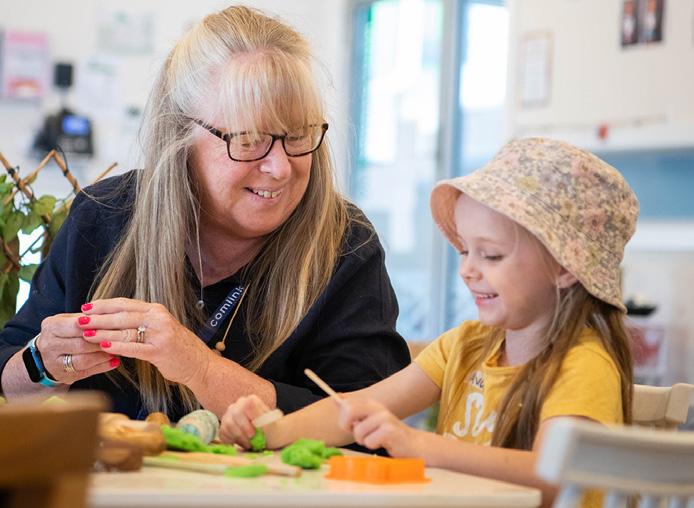
Due to its success, the program will continue to be funded at the three centres, as a 20-week program over two terms, while Brisbane South Primary Health Network has provided funding for another location at Edge Early Learning in Marsden. There are also talks about bringing it to Cairns.
“We’re fortunate because Edge Early Learning has a large footprint, which is similar to ours with home care, so we can easily expand across the state,” said Leah.
“That’s our aim.”
Linda Baraciolli, Aged Care Today Editor and Communications Advisor, Aged & Community Care Providers Association www.goc.com.au/index.php/en/hostel; www.accpa.asn.au/ace
29
NATIONAL UPDATE
For a long time, the Aged and Disability Care sector in Australia has been looking for their software providers to offer a fully integrated solution to drive efficiencies by scheduling services, maintain compliance and seamlessly manage payroll, billing, account management and general ledger.
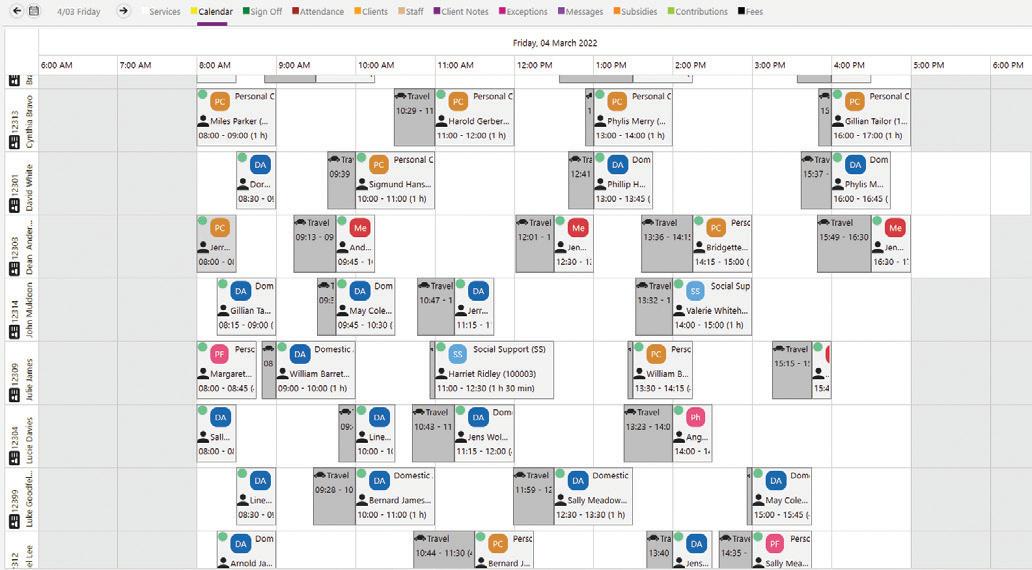
Care Systems ensures
■ Rostering and scheduling is managed efficiently.
■ Overstated KMS (both between and during service delivery) are eliminated.
■ Staff receive the information they need to be effective in their role of delivering quality care.
■ Employees are paid in line with the relevant EA or Award. On time – every time.
■ Clients receive accurate and compliant statements and invoices with no manual data transfer or need for 3rd party integrations.
■ Your organisation maintains compliance while delivering quality services to your clients.
■ Government reporting is generated without the need to import/export data.
Care Systems has listened to what its clients and the market are asking for, and are proud to deliver its suite of fully integrated and cloud-hosted applications that will create efficiency and support compliance for any organisation in the Aged and Disability Care sector.
Ensuring your compliance is maintained
From front-end home and residential client management and service rostering with the support worker mobility app, to resident billing, ACFI calculation, back-end payroll, billing, accounts and government reporting
Using the latest Care Systems cloud technology, payroll and client billing is simple and streamlined. Care Systems’ HomeCare and HomeCare Mobile modules seamlessly integrate to manage your rostering, filling empty shifts quickly and easily, while managing your KMS, worker skills and client preferences.
Once services are completed, real time mobile time and attendance data is matched to rostered shifts and services, enabling swift approval and processing of Payroll.
Want to maximise revenue and ensure effective and compliant Client and Resident Billing?
Care Systems supports providers to maximise their funding entitlements and ensure Clients and Residents are billed correctly. We can manage your Medicare payment statement reconciliation and analysis to ensure you don’t miss out on funding entitlements, payments and supplements.
As clients are billed directly from the system, end of month reconciliation and reporting occurs in parallel.
Have peace of mind knowing your residents are billed correctly, and your staff are paid accurately and on time.



Call David 0418 604 924 www.caresystems.com.au

• Registered Nurses
• Endorsed Enrolled Nurses
• Assistant in Nursing Cert 3 & 4
• Special Project Coordinators specialising in supporting facilities ready for accreditation
• COVID 19 Support Staff
LOOKING FOR SUPPORT
• Filling last minutes shifts
• Ongoing shifts
• Block bookings
• Contracts
• Part Services
• Permanent Recruitment
• Assessment Centre to cater for your bulk recruitment needs
• “Managed Service Arrangement” –Managing your agency usage
NNPLUS


32
CAN GIVE YOU THE
YOU NEED
WITH US TODAY FOR MORE INFORMATION www.nnplus.com.au or call 1300 158 440
STAFF
SPEAK
The value of exercise and on-site gyms
Why allied health in aged care is so important
The Royal Commission into Aged Care Quality and Safety highlighted the importance of active, quality, patient-centred care – which is bringing about important changes.
While the old funding model focused on passive pain management using massage and electrotherapy, the new funding tool, AN-ACC, puts the person receiving care at the centre, focusing on individual needs and allowing for therapist-directed care based on sound clinical reasoning.
When AN-ACC was introduced, the Australian Government Department of Health stated, “Providers are required under legislation to make available allied health services to residents who need them.”
Although this has not yet been widely implemented, many aged care homes are thriving in the health and wellness space, offering services for everyone, both residents and staff.
A great example of the inclusion of health and wellness as part of overall care is Riverview Lutheran Rest Home Inc, a not-for-profit 60-bed residential aged care facility in Loxton, South Australia.
Accommodation is comprised of 40 aged care beds, a purpose-built 20-bed specialised Memory Support Unit, as well as 12 Independent Living Units and 13 Serviced Apartments.
The CEO of Riverview, Nicolle Jachmann, has a wonderful vision for a holistic, total wellbeing model, that has carried through the previous refurbishment of the site, including the creation of an open multipurpose wellness space, which also offers a kitchen and a gym.
A lifestyle team is onsite daily to deliver a variety of activities that enhance the residents’ physical health, mental wellbeing and social engagement.
The ultimate goal for the team is to provide every resident with a sense of purpose, and something to look forward to. A large number of volunteers are also a big part of the Riverview family.
The latest addition to the wellness offerings is a fully fitted gym. Part of the Australian Government funded Sunbeam program, the safe and easy access HUR equipment set was a great choice for the site due to its accessibility, even for the frailest residents.
The equipment selection allows for the roll out of the Sunbeam protocol, which has proven results for falls prevention as well as improvements in overall health and mobility.
The site is also the first globally, for the installation of the Sunbeam balance training module in the HUR Smart Balance.
Balance exercises are an important part of falls prevention, but can be quite boring. Their inclusion in the form of ‘exercigaming’, makes them fun with more exercise variety.
The additional games designed together with Sunbeam’s lead researcher, Dr Jennie Hewitt, are based on the original research with the inclusion of static and dynamic balance exercise, but also include additional games with a cognitive challenge.
Riverview residents are supported by a variety of allied health staff in the delivery of exercise and wellness programs, including Physiotherapist Emily Redman from local business Loxton Physiotherapy, who visits the site weekly and creates individual programs for all residents.
The program delivery is then managed by allied health assistants and the lifestyle team, allowing for continuous and well supported service delivery as well as the creation of an active community.
That regular exercise supports health and wellbeing in aged care homes is

well understood and backed up by several studies, including one published in The Lancet Healthy Longevity in 2023, an article on the effects of physical exercise on physical function in older adults in residential care (vol 4, 6, E247-E256, 2023).
This literature review summarised that exercise interventions are effective in improving physical function outcomes in older adults in residential care, with the most consistent benefits gained with around three hours of exercise per week.
The authors finished the article by saying, “Exercise interventions should, therefore, be routinely promoted in long-term care facilities.”
However, allied health services are not always allocated accurately in our aged care system – and organisations like HUR Australia encourage all aged care homes to embrace the evidence-based active model that we know is beneficial to the health and wellbeing of every resident, supported by a strong and effective allied health team, as part of their services.
Dr Tuire Karaharju-Huisman, Physiotherapist, Accredited Exercise Physiologist and Research Lead, HUR Australia www.huraustralia.com.au; www.riverviewresthome.com.au
33 HEALTH & WELLBEING
Testing out the new gym equipment, with Emily Redman from Loxton Physiotherapy.
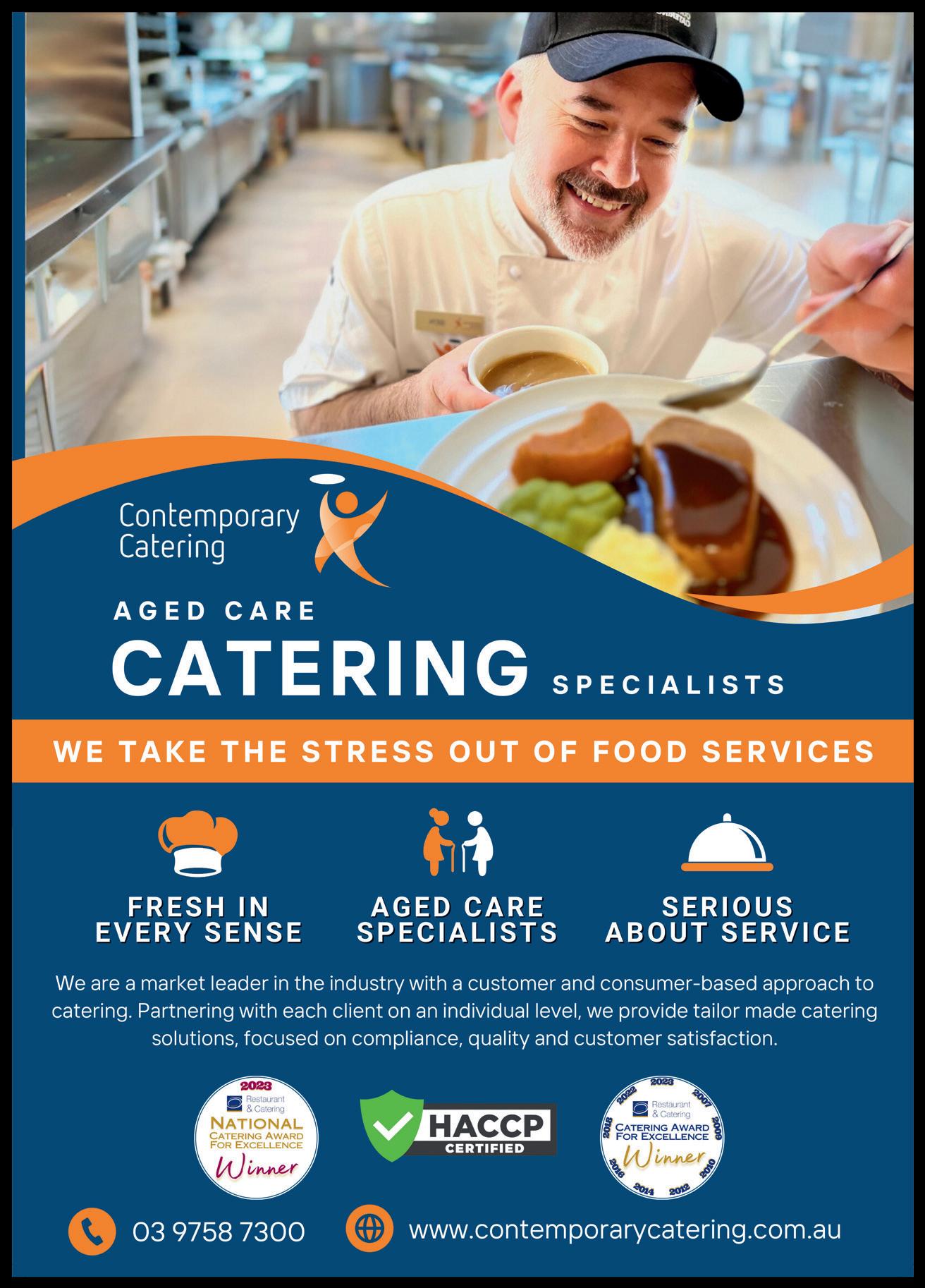

Award-winning menus
Benetas aged care residents play a major role in the food they eat
Benetas works closely with residents to deliver diverse, delicious and nutritious cuisine across its Victorian aged care homes.
More than two million meals are served at our 12 homes every year, with chefs and caterers prioritising fresh food and seasonal ingredients.
All food is made on site in a commercial kitchen, which ensures its freshness.
To ensure menus meet resident needs and expectations, Benetas works closely with residents and their families when it comes to cuisine planning, much of which takes place during monthly food focus meetings.
The meetings include discussions about resident preferences and dislikes as well as suggested alternatives and new meals for upcoming menus, which are changed seasonally to avoid repetition. A qualified dietician reviews and approves all menus prior to implementation.
Traditional and family recipes are often incorporated into menus to help residents feel more at home and to express themselves and their cultural background.
Specific dishes prompt conversations among residents about their origins and its personal significance to the resident or residents who have requested it.
And all of this makes a difference.
We know how impactful enjoying a favourite meal can be. Food is an important part of a resident’s day, a ritual ideally shared with other residents.
In response to the Royal Commission’s into Aged Care Quality and Safety, a new Standard, known as Food and Nutrition, is being introduced.
At Benetas, we are committed to implementing new changes in line with the Standard to ensure we are delivering great food options for our residents. For the food to meet nutritional requirements, all meals served at Benetas aged care homes are assessed against the aged care menu standards, using the Dietitians Australia Menu Review Audit tool.
Our focus on food was highlighted in November 2023 with the catering company providing food for Benetas’ Dalkeith Gardens residents (Contemporary Catering) winning a National Restaurant and Catering Award.
Contemporary Catering was awarded the 2023 National SiteIndustrial/Institutional Caterer award for the food and services provided to Dalkeith Gardens residents in Traralgon. The same caterer also took out a similar award for the food provided to Benetas St Paul’s Terrace in Frankston in mid 2022.
Both awards highlight Benetas’ commitment to providing residents with the highest quality food and ingredients that suit their needs and preferences.
Benetas cares for more than 1,100 residents living in homes in Camberwell, Clarinda, Frankston, Mornington Altona Meadows, Heidelberg, Glenroy, Brunswick West, Gisborne, Traralgon, California Gully and Kangaroo Flat.
We also operate four retirement living communities in Roxburgh Park, Mooroolbark, Traralgon and, later this year, in Bendigo’s California Gully, as well as community health and care and respite services across the state.
While we believe in the quality of food across all of the homes, when it is recognised by the sector, it validates the hard work of our chefs, caterers and aged care staff perform every single day. Verity Leith, General Manager Residential Services, Benetas www.benetas.com.au
35
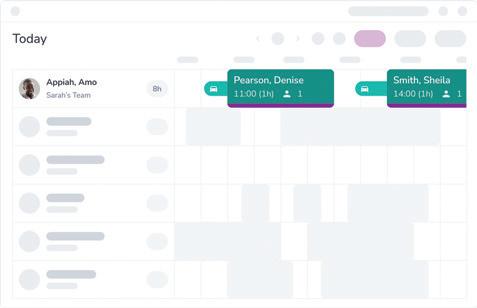
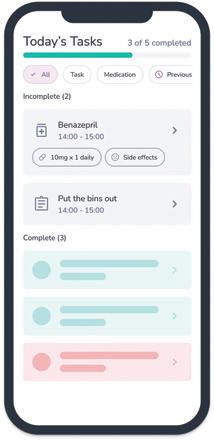
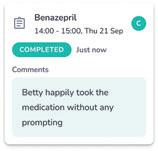
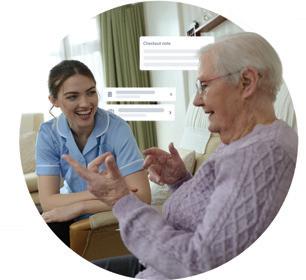
www.carelinelive.com.au


36
cost savings
increase efficiencies
business capacity
additional recruitment
functionality
Generate
and
Grow your
without
Easy scheduling with drag and drop
Make it easier for your carers to give outstanding care and enhance client outcomes
All the features and functions of the very best Australian legacy software but in a modern technology stack Best-in-class management software for the Australian home care sector
Add real time tasks for carers without having to call them
*T’s and C’s apply Book a demo and get 12 months for the price of 10 *
Good nutrition starts at home
Getting serious about malnutrition means shining a light on in-home aged care
The mealtime experience in residential aged care facilities has, quite rightly, attracted a great deal of attention from health professionals, advocacy groups and policymakers in the years following the Royal Commission into Aged Care Quality and Safety.
Dietitians Australia estimates that the prevalence of malnutrition in Australian residential aged care facilities could be as high as 50 per cent, and we still have a lot of work to do in turning that figure around.
However, malnutrition is not a problem that is exclusive to residential aged care facilities.
Malnutrition in the community
Health professionals and providers believe it is prevalent in the community, but we lack the data to conclusively quantify it, because community-dwelling older people are less likely to be screened for malnutrition than those in residential aged care.

■ implementing national nutrition and quality standards for meals that are government-funded
■ support for meal providers in meeting those standards.
This group is also unlikely to self-identify as being at risk of malnutrition. We’ve all got examples of elderly people who, for a variety of reasons, are unable to prepare adequate meals for themselves and instead rely on ‘tea and toast’.
As consultation continues for the Federal Government’s new Support at Home program, it is clear that people want to stay at home for as long as they can.
In facilitating this, we need to ensure we have appropriate systems in place to monitor and prevent malnutrition, or we run the risk of seeing greater numbers of older people with malnutrition – causing stress for themselves and their loved ones, and putting extra pressure on our healthcare system.
For the aged care system to work in an optimal way, we need people to be supported at every stage of their ageing journey.
If we want to get serious about preventing malnutrition in aged care, we need to stop it where it starts: at home, in the community.
This means keeping meals front of mind for in-home aged care providers, and referral to an Accredited Practising Dietitian at the first sign of declining intake or weight loss.
Best practice for preventing malnutrition in the community means:
■ regular screening for malnutrition
■ removing barriers to accessing nutritious meals
■ positioning meals as a requirement for clinical care, as well as daily activities
The burden of this change should not sit with providers alone.
Government support is also needed, and it is something we need to see in future iterations of the Support at Home program.
How to support your clients in meeting their nutrition needs
While we campaign for change, there are plenty of things providers can do right now to support their clients:
■ speak to them about their appetite and their food intake
■ check the fridge and freezer for what’s available and what’s in date
■ support them in placing orders for meals
■ explore their barriers to eating well – are there issues with medication, operating a microwave, chewing difficulties, swallowing difficulties, confusion?
■ early referral to an Accredited Practising Dietitian so we can focus on malnutrition prevention rather than treatment.
By working to identify and prevent malnutrition in the community, we can help older Australians achieve their goal of staying healthy at home for longer.
Ashleigh Jones, Accredited Practising Dietitian and Group Nutrition & Health Manager, Lite n’ Easy
www.liteneasy.com.au
37 HEALTH & WELLBEING
Betty enjoys the nutritious meals supplied by Lite n’ Easy.


This advertisement is directed exclusively to healthcare professionals. Valid for first-time customers only.
Always read the label and follow the directions for use.
Contains menthol & naturally derived active ingredients.

Developing behaviour support plans for people with dementia
An essential part of quality care
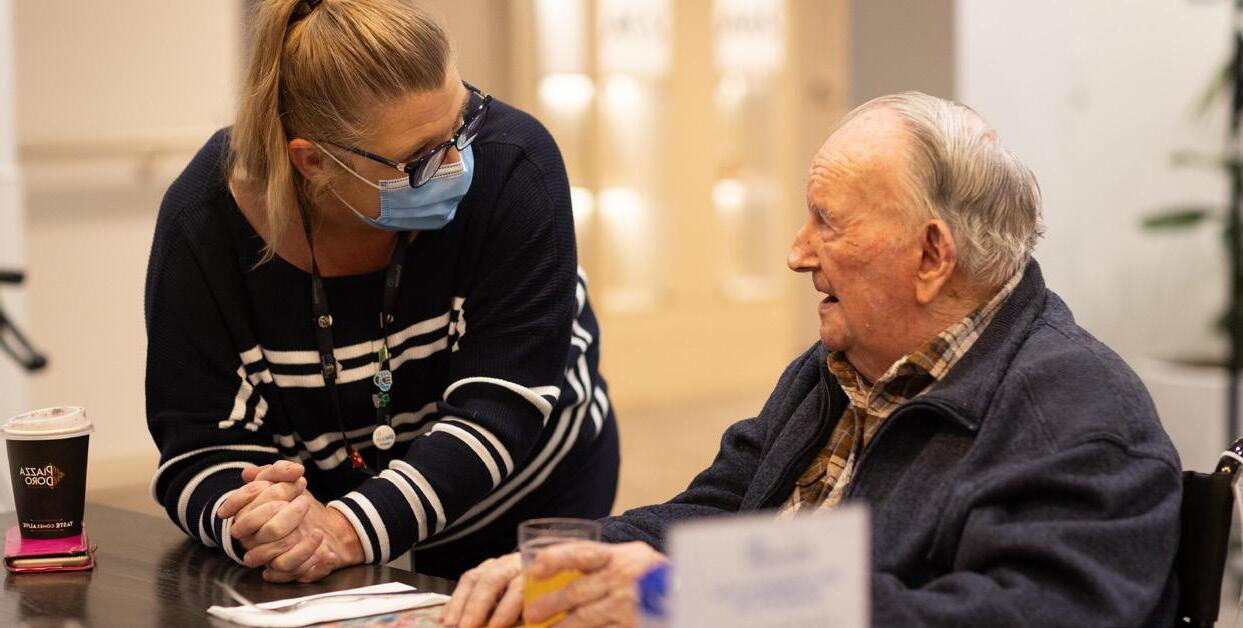
More than two-thirds (68.1 per cent) of aged care residents have moderate to severe cognitive impairment, with many impairments resulting in changed behaviours.
Since new regulations in 2021, under amendments from the Aged Care Act 1997 and the Quality of Care Principles 2014, residential aged care providers are required to have a behaviour support plan in place for each consumer who may require one.
Dementia affects everyone differently and changes in the behaviour or emotional state of a person living with dementia are common.
Specific behavioural changes displayed by people living with dementia can include increased confusion, aggression, overwhelming emotional reactions, hoarding or repetitive behaviour.
For an aged care worker, a behaviour support plan should help to understand the different things impacting a person’s behaviour, and provide specific guidance in response to these changes in behaviour.
To minimise harm and support people living with dementia, aged care workers need to have adequate information, resources and planning to ensure the highest quality of safe, proactive and dignified care.
Understanding changed behaviours Behaviour support starts with knowing the person you are providing care for.
When someone living with dementia feels ‘known’ by an aged care worker, the benefits are felt by many. This extends from the person living with dementia, to their family and the wider organisation at an aged care residence. To begin getting to know someone living with dementia, aged care workers should approach the situation like they are meeting a new acquaintance. Ask about the identity, likes, dislikes, routines, important relationships and life events that have shaped who that person is.
Many changes in behaviour are a signal that the person is stressed – or that they have an unmet need or unidentified discomfort or pain.
Through this proactive approach, aged care workers can ensure they are best resourced with a detailed understanding of the individual and create personcentred care strategies to approach the changed behaviours.
Implementing a behaviour support plan
To create a behaviour support plan, workers need to document information about the person, the changed behaviour, the care strategies used to address the changed behaviour along with consultation and consent from the person living with dementia and their carers.
This process enables providers to document and reference information about individuals, in order to understand possible previously unknown causes or triggers of changed behaviour.
Aged care workers can use resources like Dementia Support Australia templates to shape their planning.
Ask Annie modules on planning behaviour support
For aged care workers looking for further resources on developing behaviour support plans, Dementia Australia’s Ask Annie app is an effective way to learn on the go with self-paced microlearning.
Ask Annie is a free, interactive mobile education app developed for aged care professionals caring for people with dementia on a day-to-day basis, providing workers and industry leaders with a tool for behaviour support planning, to ensure professional development and best practice,
Recently upgraded, Ask Annie has a new module ‘Residential Aged Care – Plan Behaviour Support’, with four modules and 19 lessons. This module includes branched scenarios to provide workers with real world scenarios and decision-making opportunities to learn through trial and error.
For more information on Ask Annie or Dementia Australia’s Centre for Dementia Learning’s resources, educational tools and programs for healthcare professionals, please reach out to us.
Dr David Sykes, Director, Centre for Dementia Learning, Dementia Australia
www.dementialearning.org.au
39





See better care. The only digital care delivery platform built by care, for care. thelookoutway.com Lookout flows better than any other system I have ever used. — Todd at HCA Gold Coast Lookout identifies risk quicker, which is ultimately safer for the clients. — Jacqui at Coastal Home Care
Living well through the dementia journey at home
Tailored support is a must
When a person living with dementia reaches out for help, that first visit from a home care provider will likely be highly anticipated yet overwhelming, and in most cases, end with more questions than answers for the individuals seeking support and their families.
On the flip side, home care teams enter the meeting with sincere intentions to help. However, after navigating through the list of questions presented to them, they can only offer a few generic tips gleaned from dementia training, perhaps leave a couple of fact sheets and then warmly reassure that a referral to a specialist organisation will help, knowing there will be a significant delay.
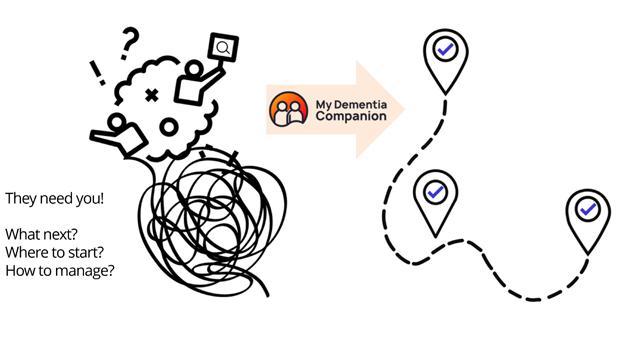
While this is better than nothing, my 20-plus years as a manager of home care services has shown me that more is required.
What our home care teams genuinely need is some structured guidance or tools to help them partner with their clients and carers to apply practical advice tailored for each individual circumstance – something that is especially important at the beginning of their dementia journey.
The strengthened Aged Care Quality Standards will place more emphasis on dementia care but as an industry we already struggle to provide limited support and advice, particularly because of the inherent complexity of dementia and the persistent training-to-practice gap.
To help fill the gap, we’ve created My Dementia Companion – a ‘passion project’ where a team of carers, health professionals and innovators volunteer their time to improve the way people with dementia are supported by their families, friends and care professionals.
The dementia journey
People can live well with dementia, but only if we help them to plan for what’s next, where to go, and how to manage challenges along their journey, and we need to help families unravel this complex path.
As an industry, we don’t do this well. It’s often a cookie cutter approach or no approach at all. The current trainingto-practice gap won’t get us there, and on-the-spot online searches are time consuming, overwhelming and full of quality risks.
Our team of passionate experts at My Dementia Companion has developed a dementia journey map to assist staff and families to live well with dementia at home.
The PRO – the first of its kind – is a practical app that helps carers shine a light on the unknown for families, creating individualised journeys, and addressing needs as they arise. It’s not one-size-fits-all, instead it responds to the unique input it is given, to help individuals live well and maintain independence for as long as possible.
Without a cure, the only way to provide quality dementia care in aged care is to empower people with the skills to prepare and manage challenges on their journey – including accepting the diagnosis, planning for the future, implementing simple care strategies at home, adapting their environment and communication, and preventing and managing changed behaviours.
Adopting quality dementia care for the sector
With around 70 per cent of people with dementia live at home, families and carers need better support.
We know home care faces many changes and challenges, but even with an abundance of free training available, the application of this knowledge in practice is still challenging.
My Dementia Companion is a practical tool, that carefully curates strategies along the dementia journey from a wealth of evidence-based, contemporary and practical resources, including tips from real carers.
The sharing and tracking features upskill your staff on-the-go, improve communication with families and demonstrate the great care you provide.
We can’t change the diagnosis, but we can change how we support our clients to live the best life they can.
Please feel free to adopt the journey or talk to us about how we can help you.
Deb Stephens, Head of Dementia Operations,
My Dementia Companion, www.mydementiacompanion.com.au
41 HEALTH & WELLBEING
People living with dementia need guidance to live well.




Commitment to positive ageing at Lifeview
From tattoos to 1950s parties
Increasingly, contemporary aged care must include a commitment to genuinely embracing the ideals of positive ageing.
The benefits of living well – by maintaining a positive attitude, feeling good about yourself, keeping fit and healthy, being active, maintaining connections to your community, and engaging fully in life as you age – have probably been underplayed.
Lifeview, a residential aged care provider in Melbourne’s south-east, however, has long believed in the power of positive ageing, taking an innovative approach to delivering personalised care for residents at its four homes.
“Aged care doesn’t mean it’s the end of your life, rather it’s a chance to do some of the things that you have never been able to do,” Lifeview CEO Samantha Jewell explains.
“Positive ageing is about living your best life on your own terms as you get older.”
An example of Lifeview’s approach was recently featured on 9News in Melbourne, telling the story of resident Gillian’s trip to a local tattoo parlour to get her first tattoo.
“One of my grandsons has got a tattoo, so I will go and see him and show him that grandma is just as good,” Gillian, 83, joked after getting a hedgehog tattoo on her arm, courtesy of Lifeview.
Gillian decided she wanted to do something ‘a little out there’ for the first time, so she mentioned she would love to get a tattoo. Social Support Coordinator Marc Zywaczewski sprung straight into action, researched local
tattoo artists, and made a booking on Gillian’s behalf. She was stoked.
“It’s important to tell these stories, because too often people have preexisting views about what they think aged care is when, in truth, aged care done well is enormously uplifting,” says Lifeview Executive Manager Marketing and Communications Cody Winnell.
“It’s on all of us in the industry to spread the word that quality, person-centred care positively impacts the lives of older people, and the prospect of living in residential aged care is not something for people to fear.”
Gillian’s tattoo was delivered as part of Lifeview’s unique Magic Moments program, which delivers residents surprise ‘bucket list’ experiences.
“The Magic Moments program is about bringing joy to the residents by surprising them with a personalised experience that is special to them,” said Samantha.
“We have had a resident taken for a motorbike ride, Batman visit one of the homes in his ‘Batmobile’, we took a resident to the local football for the day where he tossed the coin pre-match, then had some drinks with the members throughout the day, and recently, we had a resident lifted into the air in a cherry picker to replicate memories she had of climbing trees when she was a child.
“Staff are always listening and looking out for unique and fun opportunities to create Magic Moments for the residents. It’s a special program.”
Lifeview also hosts an annual Positive Ageing Celebration, which carries a different theme every year.

Last year’s event, held in October, saw the Springvale Town Hall decked out as ‘JJ’s Diner’, a 1950s themed event, with dance, music, sliders, fries, milkshakes, pecan pie, 50s fashion, a jukebox, roller skates, pink Cadillacs and lots more.
Over 240 people attended, with residents from all four Lifeview homes and their families enjoying the day.
Professional rock and roll dancers taught attendees, including residents, a variety of dance moves and a live entertainer had the room tapping and singing along to all the 1950s hits.
“Our annual Positive Ageing Celebration is such an amazing time of the year. It’s an event we all look forward to,” said Samantha.
“It brings an energy and warmth that highlights all that is positive about working in this extremely rewarding industry.”
Lifeview www.lifeview.com.au
43
TOP: Emerald Glades resident Brian on the dancefloor at Lifeview’s annual Positive Ageing Celebration in 2023.
ABOVE: Resident Gillian was interviewed by 9News about getting her first tattoo as part of Lifeview’s Magic Moments program.

Support for substitute decision-makers
State and Federal funding back Palliative Care Victoria to empower families in a collaborative approach to end-of-life decisions
Palliative Care Victoria, the state’s peak body for palliative and end-of-life care, has unveiled an innovative project ‘Dignified and Respectful Decisions’ to support families caring for older people, not just in Victoria, but across Australia.
This project aims to equip and educate family members about the importance of being a substitute decision-maker for someone living in residential aged care by providing practical information about the aged care environment and acknowledging the emotional toll people experience when making these decisions.
Pivotal within these messages is the advice for families about collaborating effectively with aged care teams to enhance the quality of life and death in residential aged care settings.
Jointly funded by the Commonwealth Department of Health and Ageing and the Victorian Government Department of Health, the Dignified and Respectful Decisions project marks a significant milestone in the realm of palliative and end-of-life care.
The online platform offers comprehensive resources designed to empower families and substitute decisionmakers to be able to advocate for their loved ones by recognising what their loved ones would choose if they
could speak for themselves, and to work alongside the aged care team to make treatment and care decisions in line with those wishes.
Violet Platt, CEO of Palliative Care Victoria, says it’s vital for the community and the aged services industry to work together.
“It’s important for us to foster collaboration across diverse sections of the community and the aged care sector to ensure dignified, individualised care for the elderly population in residential aged care homes,” she said.
“Respecting a person’s wishes not only honours their autonomy but also alleviates pressure on the aged care and health sectors, leading to more efficient resource allocation.”
In the National evaluation of the Comprehensive Palliative Care in Aged Care Measure – Mid-point Report published in September 2022, the Australian Department of Health and Aged Care identified the lack of established advance care plans as a significant barrier to older people receiving end-oflife care and dying in their preferred place.
The report emphasised the importance of fulfilling patients’ wishes and highlighted the challenges faced by healthcare professionals in navigating end-of-life decisions.
44
HEALTH & WELLBEING
The Dignified and Respectful Decisions project aims to address these challenges by providing comprehensive resources to guide families through various medical and endof-life decisions.
These resources include checklists to facilitate end-of-life discussions, information on collaborating with healthcare providers, practical and emotional preparation tips, and access to support organisations. Moreover, the project embraces cultural diversity by offering resources in multiple languages, including Greek, Italian and simplified Chinese, to cater to the diverse population of Victoria.
These discussions can often be challenging to navigate, due to the lack of information on how to best deal with end-of-life care and its sensitive nature.
Nola Horne understands first-hand the significance of such conversations, having been the primary caregiver for her husband Henry, who was living with dementia before his death.
Following a fulfilling career as a General Practitioner, often visiting his own patients living in residential aged care, Henry and Nola’s life took a profound turn when he received a dementia diagnosis.
As his condition progressed, Nola adjusted their daily life to meet his escalating needs while caring for him at home.
Initially managing reasonably well, the impact of dementia gradually permeated various facets of their existence.
Nola’s sleep suffered, exhaustion crept in, and even their social interactions became strained as she assumed the responsibility of speaking for both.
Nola recalls the emotional distress she experienced balancing caregiving duties with life’s other demands until it became overwhelming and she inevitably had no choice but to move Henry into an aged care home to receive the level of care he required.
While Nola’s story resonates with many families, she hopes that sharing her experience through the Dignified and Respectful Decisions project can help support others navigating similar challenges.
“Palliative Care Victoria’s initiative represents a significant step towards empowering families and enhancing end-of-life care practices,” said Violet.
“By fostering collaboration, promoting informed decisionmaking and embracing cultural diversity, this unique initiative takes a fresh approach to supporting compassionate and dignified care for seniors living in residential aged care.”
Palliative Care Victoria www.pallcarevic.asn.au/dard
Healthier meals, home delivered
You’ll just love the homemade taste
For over 27 years Tender Loving Cuisine has been serving the community with care, compassion and respect.
Australian Made and Owned, our health accredited, home delivered meals cater for dietary requirements with all meals developed and supported by independent review.
Our extensive menu also includes selections that are Dairy Free, Low Salt, Gluten Free, Heart and Diabetes Friendly. Our purpose is to assist clients to maintain their dignity and independence.
Assured nutrition, great taste, strict dietary controls and dedicated customer service is at the heart of what we do. With a trusted reputation and Industry Recognition, Tender Loving Cuisine sets the standard in quality and reliability.
We proudly provide meals in Aged Care Packages, NDIS, CHSP and the general community in areas of QLD, NSW, ACT and VIC.

Contact us for brochures or futher information, we’re here to help!
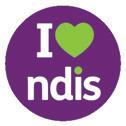
45 HEALTH & WELLBEING
Call 1800 801 200 or Visit tlcmeals.com.au TLC Meals deliver to over 3,200 suburbs across NSW, ACT, VIC and QLD
Be up to date with the 2024 AMH Book or Online


TIME SAVING
Concise and easy-to-use drug information for busy practitioners.
RELIABLE
Evidence-based content, providing healthcare professionals with a solid foundation for confident and informed decision-making.

INDEPENDENT AND AD-FREE
AMH operates independently, ensuring it remains free from industry advertisements and any external influence.

EDUCATIONAL
Educative tool with strong therapeutics foundation to support healthcare students.
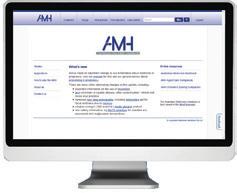

When they put their trust in you, it’s vital to have information you can trust. ) Available in book, online or desktop app Shop today at amh.net.au

















46
SCAN THE QR CODE TO FIND OUT MORE Healthcare Supplies Don’t hold your breath for too long. No filters. No waste. No maintenance. Cold-Plasma Technology Unique sanitizer
Identifying the early signs of Parkinson’s disease
The more informed you are, the better their outcomes
The world around us is rapidly changing and, in many ways, Parkinson’s disease is like ‘the canary in the coal mine’ – a warning sign of how these changes are affecting our health.
The number of people with Parkinson’s is growing rapidly, and this is thought to be related to environmental triggers like pollutants. In 1990, 2.5 million people had the disease; by 2016 there were 6.1 million; and the number is expected to hit 10 million by 2030.
A disease more likely to occur as we age, it is most common in people over 60 but is increasingly seen in younger people.
At The Florey we are studying the causes of Parkinson’s and how to slow or prevent symptoms from appearing –information that will be vital for anyone caring for older people.
Importantly, we are engaged with the Parkinson’s community to ensure that our research meets their need of improved quality of life.
What is Parkinson’s?
Parkinson’s causes progressive damage to a person’s brain and body. Symptoms vary, making it hard to diagnose. They can include:
■ abnormal movement
■ sleep disturbances
■ constipation
■ loss of the sense of smell
■ anxiety
■ depression
■ erectile dysfunction
■ changes to colour vision.
Some evidence suggests Parkinson’s can start in the gut and move to the
brain, but in other cases it starts in the brain and moves to the gut.
What causes Parkinson’s?
Only 10 to 15 per cent of Parkinson’s cases are caused by a heritable gene. The rest are ‘Idiopathic’, which means we can’t put our finger on a single cause.
Parkinson’s researchers believe a person’s genetic makeup alone doesn’t cause disease. It needs a trigger. Some people appear more susceptible to certain identified triggers, including:
■ air pollution
■ plastic contamination of our food and drink
■ industrial and farming chemicals
■ the flu and COVID-19.
People react differently to their environment based on their unique genetic makeup: a situation may cause Parkinson’s in an individual and not affect another.
However, with environmental triggers increasingly prevalent, we believe this is a key factor accounting for the global and dramatic rise in Parkinson’s cases.
How do we diagnose Parkinson’s?
Diagnosis typically starts when a person notices a change in the way they move. Their doctor refers them to a neurologist who performs detailed examinations and orders various tests; although there are promising developments in Parkinson’s diagnosis, there are still no definitive diagnostic tests or scans.
A significant problem is that it can take several years to diagnose the condition., which is stressful and causes anxiety for patients and their families. Sadly, while waiting for a diagnosis, the person will

Professor David Finkelstein says Parkinson’s is on the rise, and it needs our attention.
experience irreversible damage and loss of brain cells.
We’ve also recently learned that the disease is often present for up to 20 years before diagnosis. Trials around the world are investigating ways to prevent this early or ‘prodromal’ form of the disease becoming clinical Parkinson’s.
At The Florey, we’re also developing ways to detect Parkinson’s sooner than is currently possible. Our goal is to find ways to diagnose and treat patients in the early stages of the disease – before irreversible damage occurs.
Preventing Parkinson’s
Whatever the causes of Parkinson’s disease – genes, or genes coupled with exposure to viruses, industrial chemicals, or a polluted environment –there are steps we can take to lessen our risk of getting it. We can also reduce the risk to future generations.
Let’s start by limiting our exposure to known harmful substances, pollution and viruses. While this may take time, we have to start somewhere and, in this case, individual actions can make a difference, and protect the canary in the coal mine for generations to come.
In the meantime, scientists are working on new therapeutics to protect the brain to allow us to live longer happier lives.
Aged care providers can help too, by ensuring staff are trained in the signs of Parkinson’s – because early diagnosis is key to a better health outcome.
Professor David Finkelstein, Physiologist, Neurobiologist and Head of the Parkinson’s Disease Laboratory, The Florey Institute of Neuroscience and Mental Health www.florey.edu.au
47 HEALTH & WELLBEING

Double wave COVID-19 outbreak highlights need for vigilance
Make sure you’re ready for winter
According to the Department of Health and Aged Care’s national snapshot, as of 1 February 2024, there were 2,014 active COVID-19 cases in 287 active outbreaks in Australian residential aged care homes.
There have been 114 new outbreaks, 15 new resident deaths, and 1,543 combined new resident and staff cases reported since 25 January 2024. This underscores the need for continued vigilance, particularly as we approach the onset of winter.
Renew the push for vaccinations
“We know that older age is the biggest risk factor for severe COVID-19 disease, so it’s imperative all the protective tools are utilised to help reduce the risk of severe illness, hospitalisation and death,” says Daniel Seldon from Aussie Pharma Direct
“That includes staying up to date with vaccinations, the wearing of quality P2 face masks, undertaking a rapid antigen test when you feel unwell, and the regular use of hand sanitiser.”
As of 24 January 2024, only 30.4 per cent of aged care residents nationally had received a booster dose in the last six months, so a fresh push to vaccinate more people can help keep them safe.
Continue to support workers
Since the pandemic, we all have an enhanced appreciation of the amazing healthcare professionals who strive to keep everyone safe and healthy.
It’s interesting to note that there has been a cumulative national total of 181,697 COVID-19 resident cases in aged care homes, and 102,843 staff cases up to 1 February 2024.

“So, it’s not just the elderly who are impacted, but also the staff who care for them,” says Daniel.
“Continued focus on supporting them should be part of providers’ management plans.”
Continue protective measures
With the cost-of-living crisis hitting everyone, there’s a new affordable rapid antigen test called Sonictec which screens for COVID-19 as well as influenza A and B in the one test.
Costing around 50 per cent less than many other brands, it opens the door to a much wider market, yet still delivers very high accuracy and specificity results.
“In-home self-testing for influenza and COVID-19 is the best way to ensure you don’t infect your family and colleagues in the workplace as well as vulnerable members of the community. It also saves time and money by enabling you to stay at home rather than having to wait around in already overcrowded medical centres and doctors’ surgeries,” says Daniel.
“While it’s easy to dismiss COVID-19 as a simple cold or flu, and a minor inconvenience, it’s a bit of a Russian Roulette, and the more times you get it, the higher your chance of getting long COVID, which can be an extremely debilitating health condition.”
Another simple, yet effective protective measure for peace of mind is the ongoing use of face masks, like the Australian manufactured AMD P2 NanoTech that have been proven to filter out 99.66 per cent of airborne particles.
Featuring nano-fibre technology with superior four-layered protection, the lightweight material provides a
comfortable wearing experience and excellent breathability, which allows them to be worn for up to 24 hours.
Continued use of hand sanitiser, which has now become part of daily life for many of us, and room or vehicle sanitisers, complete our important toolkit of defence against disease.
Aussie Pharma Direct distributes the Australian-made ViroCLEAR, which is an alcohol-free, fragrance-free, nonirritating and non-drying alternative ideal for anyone with sensitive skin.
Review policies now
Prevention is always better than cure, so it’s best to step up the personal protection of residents and staff now and err on the side of safety to stop COVID-19, influenza and other diseases in their tracks before they can get a foothold.
This is particularly important to get in place before the onset of winter, when viruses are more prevalent and we spend more time indoors where the viruses circulate more easily.
“Now is the time to review infection control protocols and ensure procedures are in place, and the right products available, to manage any outbreaks of COVID-19 or other infection that may occur,” says Daniel.
“It’s essential we don’t get too complacent about COVID-19, as new variants continue to develop, and vaccination levels lag behind infection rates.
“As always, we stand ready to support providers with effective, efficient and tailor-made products for the Australian aged care industry.”
Aussie Pharma Direct www.aussiepharmadirect.com.au
49 HEALTH & WELLBEING
A new multi-virus rapid antigen test has hit the market.
The Aged Care Cybersecurity Crisis






50 Stories shared with Vasey Talk to us about our services today. Vasey RSL Care prioritises veterans and their families. Our organisation brings together people with a similar story. We support you to live life your way. vaseyrslcare.org.au 03 9810 5500 Vasey RSL Care - Aged Care Today - Autumn Issue - half page V1 12-03-24.indd 1 12/03/2024 11:45:09 AM
FREE REPORT For Aged Care Providers Download This FREE Report And Ensure You Are Fully Protected Against The Epic Level Of Current Cybersecurity Threats. Scan The QR Code Or Visit www.t4group.com.au/crisis Your business – large OR small – will be targeted and will be compromised UNLESS you act upon the information revealed in this shocking new executive report. Ph: 1300 765 014
Serving those who served
Vasey RSL Care’s supports those with an ADF connection
Vasey RSL Care is one of the smaller aged care providers with just four aged care homes, but what’s different about these homes is that the majority of residents are either veterans or war widows. And residential aged care is just one of the organisation’s roles.
It all began with Mrs Jessie Mary Vasey OBE CBE, the widow of Major General George Alan Vasey CB CBE DSO and Bar who was one of Australia’s most renowned World War II generals. He promised the men under his command that he would look after their wives if they didn’t make it out alive.
When his plane went down in March 1945, killing all on board, Mrs Vasey understood exactly what it was like to be a war widow herself. She made it her mission to help war widows both in practical ways and through advocacy on their behalf.
Mrs Vasey set up the War Widows Guild in every state to encourage widows to take up crafts to supplement their meagre pensions. At the same time, she lobbied government to increase the war widow pension, and she also set up Vasey Housing to provide rental homes for the young widows, adding aged care homes and home care services as widows aged.
In 2004, Vasey Housing (VIC) and RSL Care (VIC) merged to create the current organisation, which now manages around 250 home care packages and nearly 300 rental units solely for veterans (including those under 65) and their families, with 20 units in the planning stages, in addition to the four aged care homes.
“Our Australian Defence Forces are there to protect us, and right now, there are men and women all over the world who if needed, are ready to fight for our country and our freedom,” says Janna Voloshin, Chief Executive Officer, Vasey RSL Care.
“Our organisation has a long and proud history of serving those who served us: it is an honour to follow in the footsteps of Mrs Vasey and the RSL.”
The transition to civilian life
When veterans leave the service, the majority transfer their skills and expertise into the civilian workplace. However, some struggle with the transition and there are around 6,000 homeless veterans in Australia.
The rate of homelessness among veterans is 5.3 per cent compared to 1.9 per cent for the general population – nearly three times higher. Those who leave due to medical issues –mental or physical – are over-represented in this group.
The term ‘homeless’ covers all those who don’t have a permanent, safe home – in addition to rough sleeping, they may be ‘couch-surfing’, living in a car, caravan, tent
or bungalow, or living in short-term boarding house accommodation.
One of our residents told us, “On the day I planned to end my life, I received a call from [a Vasey RSL Care staff member] to say they had a unit for me. I’ve been living there ever since. Vasey saved my life.”

Experience indicates that many younger residents move on quite quickly, with the units giving them the chance to overcome challenges. However, there are some who have significant challenges which aren’t ‘fixed’ by simply providing a secure home.
The V Centre Veteran Empowerment Program
The V Centre is a new and unique initiative specifically for veterans. Program participants have safe accommodation combined with a personalised program of support. They set their own goals for their time at the V Centre and must demonstrate commitment to positive personal change.
“The V Centre Program is a ‘circuit breaker’,” says Chris Gray, General Manager Veteran Services at Vasey RSL Care. “Program participants are individually supported so they can take the steps they need to address whatever they are facing.”
“The intention is to stop the downward spiral before the veteran reaches a state of homelessness,” says Janna. “One homeless veteran is one too many.”
This ground-breaking initiative is being funded by Vasey RSL Care and has received $1.35 million from the Australian Government, plus some individual donations, but is still looking for significant funding to get through the first three years until it is self-supporting.
Veterans Home Care
The last piece of the Vasey RSL Care veteran support services is Veterans Home Care. Limited to low levels of care, it is funded by the federal Department of Veterans’ Affairs to provide essential home care services for the health, wellbeing and independence of eligible veterans and their families.
“We are extremely pleased to have been successful with our tender to be a provider of the Government’s Veterans Home Care,” says Janna. “This is perfectly aligned with our mission.”
“We are committed to responding to the changing needs of the veteran community with respect and dignity.”
Vasey RSL Care
www.vaseyrslcare.org.au
51 CULTURE & DIVERSITY
Mrs Jessie Mary Vasey OBE CBE helped establish support for veterans which has extended into aged care services as veterans and their widows have aged.
nursing SErvice

Because the world needs care
Home Care
Disability Support
Staffing Solutions
Personal Care Services
Specialized Accommodation
Experienced Professionals: Our team consists of experienced nurses and personal care attendants who are dedicated to delivering the highest standard of care.

Tailored Services: We understand that every individual has unique requirements. That's why we offer personalized services that cater to your specific needs, ensuring you receive the care that's right for you.
Comprehensive Coverage: We proudly serve multiple regions across Australia, bringing our exceptional care to your doorstep. No matter where you are, our team is ready to support you.
prodigyhealthsolutions.com.au 1 3 0 0 1 5 9 9 9 6
VMCH supporting marginalised older men
A sense of community and secure housing makes all the difference
VMCH is a non-profit provider of aged care services in Melbourne, with a big heart to support those who need it most, says Residential Services Manager Donela Perry.
“Over the past 47 years, our lifechanging mission has reached out to some of the most marginalised and vulnerable men in the Melbourne community,” she said.
“At the heart of our work, you’ll find the men who had the courage to make a fresh start, surrounded by community, kindness and friendship.”
Their residential aged care home Corpus Christi Community Greenvale (CCCG), situated around 20 kilometres north of the centre of Melbourne, provides accommodation and support for around 80 marginalised older men with a history of homelessness, complex health needs or addiction.
Originally founded in 1974 by Mother Teresa and her Missionaries of Charity, CCCG was established as a refuge for men facing personal hardships. In 1977, the Missionaries of Charity entrusted the care of the home to the Archdiocese of Melbourne.
In January this year, fellow Catholic, for-purpose aged and disability organisation VMCH officially merged with CCCG, securing the home’s longterm ability to support marginalised men for years to come.
The vital need for specialised homes like CCCG is clear, with one in seven people (16 per cent) aged 55 and over
experiencing homelessness (2021 Australian Census).
Studies have also shown the duration of substance use problems is often prolonged in the homeless population, because their social networks may perpetuate alcohol and other drug problems.
Donela says CCCG fills a gap in the system for this cohort of men.
“CCCG is a space to rest, recover and grow. To stop the turntable of services, hospitalisation and street living, that for many has been the norm,” Donela says.
“Mental health is a large reason for many of our residents’ inability to maintain housing and supports. Along with providing them with access to a range of medical professionals, we offer acceptance and understanding, building on their strengths and self-esteem.”
Barry, aged 67, struggled with alcohol abuse and homelessness before moving into CCCG almost eight years ago.
Along with a safe and comfortable roof over his head, access to support such as counselling, health services, rehabilitation, art and music therapy, shopping and budgeting education, social activities and community outings, have seen Barry thrive.
Barry enjoys helping run the home’s canteen and assisting with gardening. He describes CCCG as “life changing and life saving” and is thankful to the many lasting friendships he’s formed with fellow residents and staff.
Donela says friendships are key to men’s comfort and success at CCCG.
“They make friends they consider family more so than co-residents. If men are younger when they arrive and are successful in moving out independently, often they return when they are older or their health declines for the feeling of coming home.”
Resident Kenneth, 68, who moved to CCCG during the pandemic after a hip replacement, describes his experience as “extremely good” and credits the home with restoring his fitness and ending his severe depression.
VMCH Chairman Julien O’Connell AO said he was proud to officially welcome the CCCG community into the VMCH family, following extensive collaboration on the best way forward to help secure the future of the home.
“We share a common mission and values to deliver compassionate care for people in need, particularly the vulnerable and marginalised,” he said.
“VMCH’s fantastic reach and resources within the aged, disability and affordable housing and community services sectors will be an asset to CCCG residents. As Australia’s housing crisis continues to grow, it’s vital CCCG’s specialist work continues.”
For Barry, his wishes for the future are simple, and reflect the community nature of CCCG.
“I hope to be able to do what I’m doing now; helping others. I don’t want anything for myself but good health.”
 Cassie Zlonzak, Communications Manager, VMCH www.vmch.com.au
Cassie Zlonzak, Communications Manager, VMCH www.vmch.com.au
CULTURE & DIVERSITY
Residents of Corpus Christi Community Greenvale describe it as “life changing and life saving”. 53

We believe in doing one thing well. That’s why Inerva is the complete ERP software
Our clients trust us to stay on top of changing industry requirements such as AN-ACC and QFR.
Dynamic occupancy-based care minute targets? Quarterly Financial Report templates? We’ve got you covered.
Australian-based phone support? Secure cloud environment? We do that too. Call 1800 463 782 or email sales@inerva.com to find out more!
Finance Residential Clients Roster Payroll Home Care 1800 463 782 | inerva.com Aged Care. Simplified.
solution for Australian Aged Care.

More than words
Improved understanding of linguistic diversity is essential for quality care
Australia is home to people who identify with over 270 different ancestries and speak more than 400 languages.
Consistent with Australia’s migration patterns and general population ageing, more and more people receiving aged care services were born in a non-main English-speaking country and have a preferred language other than English.
Amid the myriad sector-specific challenges, how can service providers improve the ways they engage with and support the growing group of older Australians who speak different languages?

In policy and practice, services and support are expected to accommodate the cultural and linguistic diversity among aged care residents.
Yet despite clear recommendations and guidance – such as the final report of the Royal Commission and Australia’s Aged Care Diversity Framework – there are significant gaps in how residents with diverse needs and preferences are supported.
Recent work undertaken by the Australian Association of Gerontology (AAG) seeks to address this complex issue.
In a report titled Capturing cultural and linguistic diversity in Australia, released last year, AAG called for improvements in how cultural and linguistic diversity is captured in government data sources.
“Equity in planning, providing and accessing health, social and aged care services depends on accurate data,” says AAG Policy and Research Manager Dr Amber Mills.
This poses a real challenge, because there is little consistency in the way diversity data are collected and reported at government and service provider levels.
“Despite gaps in the data, our efforts to understand and improve service design, access and delivery must be evidence-based,” says Amber.
Adding to the evidence is a recent study on linguistic diversity among older Australians living in residential aged care, involving AAG’s Communications, Advocacy and Grants Manager Dr Meg Polacsek, in collaboration with the Centre for Cultural Diversity in Ageing, Monash University and service provider Benetas.
The 2023 study Who speaks my language? Linguistic diversity among people living in Australian residential aged care facilities found that permanent aged care residents
represented 185 different countries and 80 language preferences.
While these numbers highlight the importance of culturally competent aged care, the study team cautions against making assumptions about country of birth and language preference.
“We certainly shouldn’t make assumptions about diversity based on how a person looks or whether they have an accent,” says Meg.
“There are people who were born in a non-main Englishspeaking country who speak English as a first language, and others born in a main English-speaking country who may prefer to speak a language other than English.
“Still, we know that these older adults find it difficult to access and receive the support they need.”
Recognising the daily challenges faced by providers, and the significant investment and innovation needed to provide high quality culturally appropriate care, there are a few practical ways to bridge some of the gaps. These include:
■ collecting and using current information on the cultural and linguistic backgrounds of residents and staff to optimise communication, participation and care
■ recognising and better supporting families of non-English speaking residents
■ introducing residents to culturally and linguistically relevant community networks and making cross-facility connections with residents from similar backgrounds
■ building the capacity of aged care staff and leveraging their cultural and linguistic skills more effectively.
Australian Association of Gerontology www.aag.asn.au
55

We are looking for eligible professionals to join our dedicated team of locums
As a Rural LAP Aged Care locum, you’ll have the opportunity to travel, meet new people, develop new skills and work in some of the most beautiful places, from the countryside to outback Australia. Apply Now

Achieving great outcomes for NDIS participants in aged care Information for
providers and residents
After more than four years living in aged care, William was finally able to move into a specialist disability accommodation apartment with the help of the Aged Care to Home service. The move came four days before his 52nd birthday.
William had identified his housing goal but it took him some time to be able to achieve it.
“I am deaf and have cerebral palsy. I use sign language,” William says. “Nearly five years ago I was transferred from hospital to an aged care facility after an illness.
“The four years in aged care were extremely tough for me and it wasn’t helped by the COVID-19 pandemic.
But through the Housing Hub and my NDIS providers I was finally able to get a place in a specialist disability accommodation apartment.
“As a result everything seemed back to normal and the world is a more meaningful place.”
The Aged Care to Home service was developed by the Summer Foundation – an organisation created in 2006 to support young people with disability find accommodation outside aged care – in partnership with the Housing Hub, which helps people with disability find suitable housing.
The service works directly with young people living in aged care, and their supporters, to achieve their housing and support goals.
There is no charge for the Aged Care to Home service, which is philanthropically funded.
This service aligns with the Federal Government’s target to ensure all younger people transition out of aged care by 2025 (apart from in exceptional circumstances).
It can also provide support to aged care providers to ensure compliance with the new Age Care Act specified eligibility needs of those aged under 65.
Your younger residents may want to explore the option of living outside aged care but this can feel overwhelming. This is where our expertise comes in.
We specialise in supporting young people who are living in aged care to explore housing, funding and support options that are tailored to their needs and preferences.
The service also acknowledges that not all young people living in aged care want to move out and instead have goals around improving their quality of life while in aged care. We support these people to explore the NDIS supports they may be eligible for, such as therapies, equipment, personal care

and community participation supports, which are often not available through their aged care funding.
In its first 12 months of service delivery, the Aged Care to Home service has supported 13 people to move out of aged care and many others to improve their quality of life while remaining in aged care.
Some aged care providers may be in the process of transitioning away from being NDIS providers and will need to engage with supports that are person-centred, hold no conflict of interest and are experts in working with people with disability to explore housing options.
The Aged Care to Home service ticks all these boxes, and engagement with the service will uphold residents’ rights to ensure best practice.
The aged care sector has experienced much change over the past few years and there is still more to come, so we understand that it may be difficult to allocate time to supporting young people in your care to explore their housing options.
Our specialist team works directly with the person and their support team to achieve their housing and support goals, so your time investment will be minimal.
If you are an aged care provider with younger NDIS residents (under 65 years of age) and you want to connect with us please reach out to us.
Alicia Baltra-Ulloa,
Aged Care to Home Engagement Coordinator, Summer Foundation www.summerfoundation.org.au/i-work-with-people-withdisability/aged-care-to-home-program/
57 CULTURE & DIVERSITY
The Aged Care to Home service helped William transition out of aged care.
Fostering the wellbeing of older people and their pets with pet care support
How home care providers can help
Many studies demonstrate how pets offer a myriad of physical and mental health benefits for people, such as reducing stress, providing companionship and encouraging social interactions. This is true particularly for older adults who often face loneliness and isolation and rely on their companion animals to thrive.
“Sadly, there is a painful absence of government support for older people with pets in in-home care, resulting in not only putting people’s lives in danger but also their much-loved animals being surrendered to shelters across the country,” says Trish Ennis, CEO of national animal welfare charity Companion Animal Network Australia (Australia CAN or CANA).
Australia CAN’s Status of Pets in Aged Care report reveals 40 per cent of older adults who receive a Home Care Package (HCP) have pets, yet only 9 per cent of these pet owners receive pet care support, despite more than 60 per cent needing help with pet care such as walking their dog and taking their pet to the vet.
“We are calling Hon Mark Butler MP, Federal Minister for Health and Aged Care and Hon Anika Wells MP, Federal Minister for Aged Care to help our ageing population maintain a high quality of life and that includes finding ways to help older adults retain their pets,” says Trish.
“Australia CAN encourages more in-home aged care providers to offer pet care services, and this begins with recognising the benefits of pets for older adults and implementing policies and practices that accommodate their presence.
“It’s also an opportunity to expand your business offerings to those who are in need of these services. CANA is contacted on a daily basis with people requesting services for both pet friendly home care support and residential places that consider taking people and their pets.”
Strategies for home care providers
The following strategies can assist providers with fostering the wellbeing of older adults and their beloved animal companions:
■ Ensure a pet-inclusive assessment of a client’s needs when creating a care plan.
■ Develop and communicate to care givers clear policies regarding pets, including the types of pets allowed and any specific requirements to be aware of.
■ Include pet care assistance as part of the caregiving services, such as grooming, feeding, taking pets for walks or to the

vet. If the client is unable to care for their pet independently, provide support or arrange for pet care services.
■ Incorporate pets into client activities, such as pet therapy sessions, client outings to pet friendly cafes and parks and encourage caregivers to engage with the client and their pets during leisure time.
■ Make necessary home modifications to make the living space safe and comfortable for clients and their pets, such as creating designated pet areas or installing pet-friendly furniture.
■ Ensure the home is equipped with any necessary pet care items, such as non-slip food and water bowls and comfortable beds.
■ Provide education and training for caregivers on how to interact with pets and recognising signs of distress or health issues in pets.
■ Include provisions for pets when developing plans for emergencies, such has an evacuation, and ensure that caregivers can implement them if necessary.
■ Establish partnerships with local pet services, such as groomers, pet sitters and veterinarians to provide comprehensive support for clients and their pets.
58 CULTURE & DIVERSITY
Trish Ennis, pictured with her dog Buddy, says we need more specific home care support for pet owners.
“The health and wellbeing benefits of pet ownership are measurable and indisputable,” says Trish.
“The CHSP (Commonwealth Home Support Programme) and HCP can be extended to determine and secure the necessary assistance for a person to live independently with their pet by ensuring services are offered to support pet health and wellbeing.”
Australia CAN is urging aged care providers to show their support for older pet owners by writing to their local members and Ministers, and signing and sharing Australia CAN’s #PetFriendlyAgedCare petition calling for pet friendly aged care support in the aged care reform.
Be part of the pet friendly register
If you are a pet friendly in-home or residential aged care provider or are interested in being pet care inclusive, you can contact Australia CAN to be included on a database of residential aged care and home care support agencies. For more information, please email info@australiacan.org.au
Australia CAN www.australiacan.org.au
Sign the petition here: www.change.org/p/demand-for-theaustralian-government-to-support-older-pet-owners-in-home


59
CULTURE & DIVERSITY
Photography by Pietro Schellino.



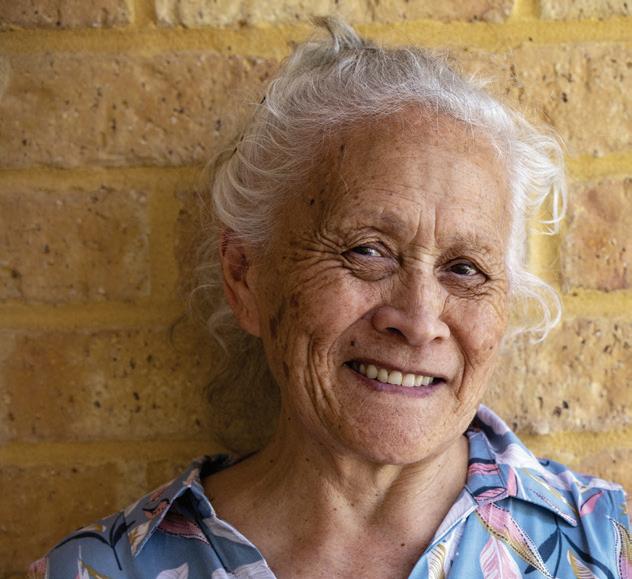




The Older Persons Advocacy Network (OPAN) provides face-toface information sessions for older people in residential aged care.
The Older Persons Advocacy Network (OPAN) provides face-toface information sessions for older people in residential aged care.
Our advocates cover topics such as: • rights and responsibilities
Our advocates cover topics such as:
• rights and responsibilities
• the role of advocacy
• the role of advocacy • and how to identify abuse.
• and how to identify abuse.
• By facilitating these information sessions, you can demonstrate you are meeting the Aged Care Quality Standards.
• By facilitating these information sessions, you can demonstrate you are meeting the Aged Care Quality Standards.
• Advocates’ visits generate valuable feedback, enabling you to tackle issues before they become complaints.
• Advocates’ visits generate valuable feedback, enabling you to tackle issues before they become complaints.




For further information: 1800 700 600 Free aged
care information sessions
Benefits to aged care providers:
Scan the QR code to book or call OPAN 1800 700 600 Book your session today ‘The best way to nip a complaint in
bud? Simple.
Supported by funding from the Australian Government For further information: 1800 700 600 opan.org.au Free aged
information sessions
the
- Margaret, advocate
care
Benefits to aged care providers:
Scan the QR code to book or call OPAN 1800 700 600 Book your session today
best way to nip a complaint in the bud?
‘The
Simple. Resolve it,’ - Margaret, advocate
The issues with substitute decision-making
OPAN’s free training can help
Older Persons Advocacy Network (OPAN) advocates provided almost 37,000 cases of information and support in the last financial year and delivered more than 4,300 education and information sessions to older people, their families and other representatives.
While a broad range of issues were canvassed, two key themes emerged across all types of aged care: poor communication and a lack of choice and control.
Older people, whether they were living at home or in residential aged care, frequently sought advocacy support because they did not feel heard by their aged care provider or felt their requests to address aged care concerns were dismissed or ignored.
For people receiving the Commonwealth Home Support Programme or Home Care Packages, issues around choice and control typically related to who delivered the services, when they delivered the services, and what type of service they delivered.
In residential aged care, concerns often involved providers making decisions on behalf of the older person or prioritising the decisions of family members or substitute decision-makers over the views and preferences of the older person.
OPAN’s most recent Presenting Issues Report – an annual analysis of the qualitative and quantitative data recorded by OPAN’s nine member organisations – identified the misuse of substitute decision-making powers as an area of significant concern.
“Individuals engaged as substitute decision-makers were often not aware
of the responsibilities associated with their role, with many making decisions based on their own interests, or what they considered to be the best interest of the older person,” the report noted.
“[Advocates] were involved in multiple incidents where family members or friends acting as substitute decisionmakers restricted an older person’s access to social outings, family visits and in some instances medical appointments.
“Many of these cases occurred within a residential aged care setting and ... aged care providers accepted the word of people claiming to be substitute-makers without sighting evidence that the relevant instruments were in effect.”
Karen Williams, Principal Solicitor at ADA Law, a division of OPAN member organisation ADA Australia, specialises in laws related to decision-making.
“People cut corners. It’s human nature,” she says.
“But one corner being cut leads to another corner being cut and before you know it, you are on a slippery slope, often to neglect, if not abuse.”
The supported decision-making principles that have been embedded into the exposure draft of the new Aged Care Act will go some way to addressing OPAN’s concerns, according to CEO Craig Gear.
“Under the supported decision-making model, people are provided with the support and information they need to actively make their own choices.
“People with cognitive conditions, such as dementia, might need more formalised assistance to support them in making daily decisions, but it’s rare for anyone to be incapable of making any decisions for themselves.
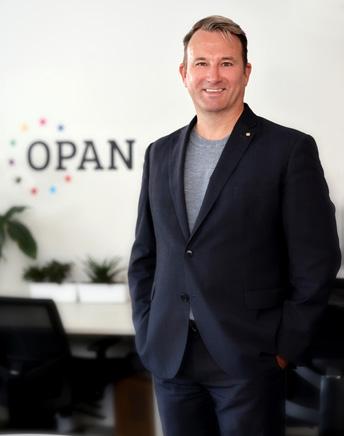
“While someone may not have the ability to understand the extent of, and manage, their assets, for example, they can still make decisions about where they want to live and who they wish to spend time with.”
At a recent OPAN webinar on the subject, Dr Sandra South, Research Director at Perspicacious, said supported decision-making was central to the ability for people to have power over their own lives.
“We all easily fall into a caring role where we try to do what we think is best for the other person. It can be really confronting and challenging to accept that they might not want what we think is best for them.
“It can also be really challenging to tell someone you love that their way of caring for you is not what you want or need.”
OPAN’s free information and education sessions in community and residential aged care, delivered by professional advocates, can also support providers by informing older people of their rights and friends, family and other representative of their responsibilities in relation to substitute and supported decision-making.
To book a session, or for information on supported decision-making including a fact sheet for providers, visit our website or call us on 1800 700 600.
Vicky Roach, Senior Media and Content Officer, Older Persons Advocacy Network www.opan.org.au
61 WORKFORCE & TRAINING
OPAN CEO Craig Gear says better understanding of supported decision-making is vital.
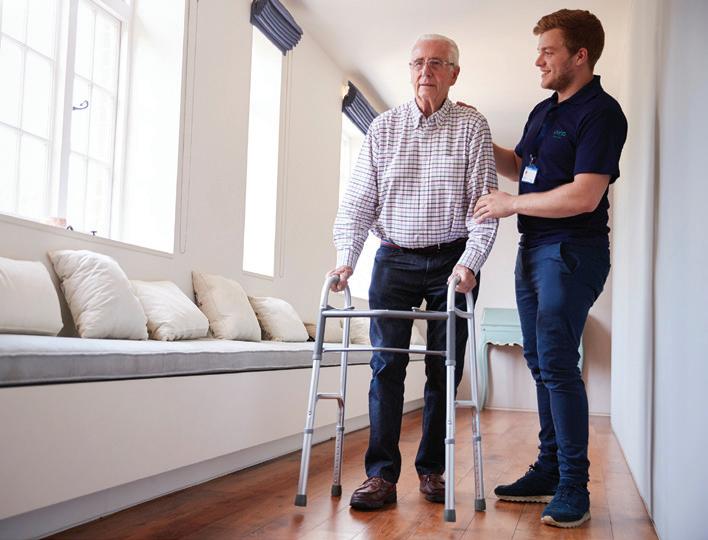
Essential training in aged care rights
The benefits go a long way

Older people have a right to receive safe, quality aged care, have their voices heard and be treated with respect.
In the Australian aged care sector, training and development of staff members plays a crucial role in ensuring high-quality care and support for older people.
While often training is around best-practice care or new clinical methods, the rights of the consumer don’t often get mentioned, yet it’s important for achieving better care.
In fact, training aged care staff in implementing the Charter of Aged Care Rights is essential for ensuring older people’s wellbeing, dignity and rights by increasing staff’s knowledge and understanding of these rights, and for promoting a compassionate and person-centred care culture.
An easy way to train your staff in aged care rights is to engage Elder Rights Advocacy, which offers free on-site and virtual staff training in relation to the Charter and supports staff in upholding these rights.
Established in 1991, Elder Rights Advocacy provides information and advocacy support to older people, their families and representatives in Victoria to address issues related to Commonwealth-funded aged care services. Our service is free, independent and confidential.
Empowering staff to uphold dignity and autonomy
Based on the Charter of Aged Care Rights, Elder Rights Advocacy training promotes person-centred care and listening to the older person’s voice in all interactions.
By recognising and respecting the older person’s rights, care staff create an environment for older people that fosters their independence, choice and a sense of control over their lives.
While all care staff should be aware of the Charter of Aged Care Rights, feedback from staff who have attended one of Elder Rights Advocacy’s training sessions shows that the training enhances their understanding of these rights.
Improved quality of care
Aged care staff with a strong understanding of aged care rights are more likely to deliver high-quality care.
Elder Rights Advocacy training covers how these rights relate to safety, privacy, dignity and freedom from abuse, supporting staff to consistently provide care that meets these standards.
Enhanced quality of care contributes to better health outcomes, improved emotional wellbeing, and an overall higher quality of life for older people.
Enhanced communication and engagement
Training staff in aged care rights promotes effective communication and engagement with older people.
Staff members are encouraged to listen actively to residents, respect individual preferences, and involve the older person in decision-making.
Elder Rights Advocacy trainers draw on real-life examples reflecting their advocacy experience, while the sessions are interactive, allowing time for open discussion on how to balance rights and risks.
Prevention of elder abuse and neglect
By educating aged care staff about aged care rights, training programs play a crucial role in preventing elder abuse and neglect.
In addition to advocacy and aged care rights training, Elder Rights Advocacy offers training in preventing and responding to elder abuse, which is also free.
This training assists staff to recognise signs of abuse, neglect or exploitation and to respond appropriately.
This can help identify potential issues early on, leading to timely interventions and protecting older people who may be vulnerable.
Compliance with regulatory standards
Aged care providers are subject to regulatory frameworks and standards that govern the rights and wellbeing of older adults.
Elder Rights Advocacy’s training in aged care rights supports compliance with these standards, reducing the risk of regulatory consequences.
Compliance safeguards older people’s interests and fosters trust and confidence among residents and their families.
Staff are encouraged to advocate for older people and refer residents to Elder Rights Advocacy for free, confidential and independent information and support.
Elder Rights Advocacy advocates live and work in communities across Victoria but deliver online training anywhere in the state. In other jurisdictions, OPAN members deliver this training.
Elder Rights Advocacy is the Victorian founding member of the national Older Persons Advocacy Network (OPAN), delivering the National Aged Care Advocacy Program (NACAP), an Australian Government-funded initiative.
Elder Rights Advocacy
www.elderrights.org.au/get-support/education-sessions/
63
WORKFORCE & TRAINING
Photography by Matheus Bertelli.
Hand-n-Hand Peer Support

Feeling burnt out? Stressed? Isolated? Or just wanting to talk to someone who really understands your professional challenges?
Hand-n-Hand Peer Support is a non for profit organization offering free and confidential peer support services for healthcare and aged care professionals including support workers.

Hand-n-Hand works by connecting participants with trained facilitators for the purposes of peer support. Simply put, peer support is a unique way of providing emotional and well being assistance where the facilitator and participant are equals from the same profession, level of experience and industry. This creates a safe environment based on trust, understanding and shared experience where people can talk about their professional challenges.
Interested in peer support, becoming a volunteer facilitator or receiving free peer support training?

REGISTER NOW lgbti-ageing-conference.org.au
Empower your workforce for the best dementia care
Access fee-free online education for aged care staff to help grow their dementia expertise
Dementia Australia recently announced a new partnership with the University of Tasmania and Wicking Dementia Research and Education Centre, which will credit eligible graduates for one unit

– Effective Communication for Dementia Care –within its Diploma of Dementia Care.
Aged care staff can enrol in a nationally recognised, 10993NAT Certificate IV in Dementia Practice – the firstever 12-month online government-funded program led by Dementia Australia’s Centre for Dementia Learning.
By encouraging your staff to continue to build their knowledge of dementia, you can promote best-practice care and demonstrate the importance you place, as an aged care provider, on employing a highly trained and educated workforce.
The program will enhance dementia practice, strengthening your staff’s capacity to be dementia practice leaders. Ultimately this is to improve the lives of people living with dementia, by workers improving their engagement with them, as well as with their families and carers.
Across 14 units of competency, participants acquire advanced, contemporary knowledge and skills to become leaders in implementing changes to practice.
Delivered completely online, the 10993NAT Certificate IV Dementia core units of competency are:
■ Reflect on and improve own professional practice (CHCPRP003)
■ Demonstrate leadership in the workplace (BSBLDR411)
■ Lead team effectiveness (BSBLDR414)
■ Apply concepts of dementia and contemporary practice (NAT10993001)
■ Work legally and ethically (CHCLEG001)
■ Contribute to dementia diagnosis through cognitive screening and assessment (NAT10993002)
■ Deliver dementia support using enablement strategies (NAT10993003)
■ Support independence and wellbeing (CHCCCS040)
■ Optimise communication for people living with dementia (NAT10993004)
■ Support changed behaviour associated with dementia (NAT10993005)
■ Work with diverse people (CHCDIV001)
■ Plan for and provide care services using a palliative approach (CHCPAL002)
■ Facilitate wellbeing of carers and self in dementia care (NAT10993006)
■ Develop and maintain dementia service networks (NAT10993007)
The course is one of four new government funded Leadership and Practice Change programs designed and delivered by Dementia Australia as part of Dementia Training Australia that will be delivered through Dementia Australia’s Centre for Dementia Learning.
This program is suitable for people working in aged care, health care and community services. Eligible participants must be working with people living with dementia in a professional capacity, with all work placement assessment requirements to be conducted in a suitable workplace.
Director of the Wicking Dementia Research and Education Centre at the University of Tasmania Professor James Vickers has welcomed the partnership with Dementia Australia.
“Our partnership recognising learning achieved through the Certificate IV qualification towards the Diploma of Dementia Care at the University of Tasmania will help build expertise in dementia further, providing a skilled workforce that will boost the quality of dementia care nationally,” he said.
Applicants are required to complete pre-enrolment screening as part of the enrolment process. This is to ensure all applicants will have the right support to complete this nationally recognised program.
As this is an online program, learning can happen from anywhere with an Internet connection, using a desktop PC, laptop or tablet device. Participants must also have a computer camera, to engage in webinar sessions.
Dementia Training Australia (DTA) is a consortium funded by the Australian Government to provide nationwide education on the support and care of people living with dementia. The nationally recognised training is delivered and assessed by Dementia Australia (RTO Code 2512).
The consortium is made up of Dementia Australia and five universities – the University of Wollongong, La Trobe University, Queensland University of Technology, University of Western Australia, and University of Tasmania Wicking Dementia Centre. All providers with eligible staff are encouraged to apply.
Wicking Dementia Research & Education Centre www.dementialearning.org.au/course/certificate-iv/
65
WORKFORCE & TRAINING



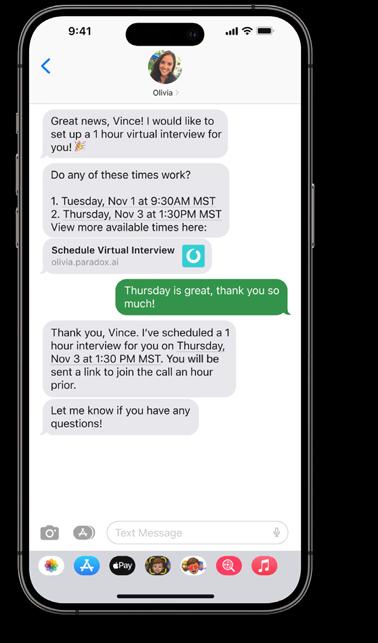






How BlueCare has accelerated high-touch hiring with AI
Getting the right candidates fast, has made all the difference
At BlueCare, making a difference usually looks pretty routine: going shopping, cleaning the house. Just your everyday to-do list for some, but for UnitingCare Queensland’s aged care division, it’s how caregivers help senior citizens live life to its fullest.
Yet even though the day-to-day sounds ordinary, being a caregiver requires a special kind of person. This busy position requires each caregiver to develop a working relationship built on trust with every customer, and be fully attentive to customers’ needs.
Finding people who are right for this role can be a challenge. And BlueCare needs to hire a high volume every month to keep up with growing demand in the aged care sector.
In order to meet that demand, Amanda Dyson, BlueCare’s Head of Talent Acquisition, identified a need to increase BlueCare’s hiring efficiency and lower recruitment costs.
And for an organisation built around human connections, she found help in an unlikely place: AI.
The before: slow processes with high drop-off
BlueCare’s ability to meet client needs is based on recruiting a team of selfless people ready to commit their time to helping others live life their way.
To do this, BlueCare’s recruiters employ an intensive screening process to ensure new candidates possess the knowledge and skills their customers depend on.
But their old approach created an inefficient recruiting pace. With candidate screening and interview scheduling taking days, candidates were accepting other offers before BlueCare could progress them through their recruitment process.
Having the recruiters screen for logistics was slowing the process down, and giving them less time to spend with a candidate in the one-on-one stage of their recruitment journey.
So they sought a way to increase speed and conversion, helping BlueCare get the right candidates hired sooner.
The solution: an AI assistant named Olive
Amanda understood that her recruiters were most valuable when they were getting to know the candidates on a personal level.
“Once I analysed the situation, it became clear that there was a way we could speed up our process,” said Amanda.
“By screening the qualified people as quickly as possible, and then allowing our highly skilled recruiters use their expertise
to determine the best fits, we could get better outcomes,” she said.
So the person-centred, communitydriven organisation turned to AI.
Amanda discovered what was taking her recruiters days, AI could automate in minutes.

That automation has come to life as Olive, a conversational AI assistant that sits directly atop BlueCare’s career site.
When candidates are interested in applying for a BlueCare position, they can text or scan a QR code to immediately start an application on their phone. Olive will immediately begin screening through a series of text messages.
“How many years of experience do you have?”
“Do you have any qualifications?”
If candidates are qualified, Olive moves them forward in the process. Recruiters then reach out to candidates to determine whether they possess the soft skills necessary to thrive as caregivers.
As recruiters are no longer stuck handling the initial stages of this process, they’re able to invest more time and care into these later stages.
“It’s so conversational. It’s a lovely experience,” said Amanda.
The results: happier candidates, faster hiring Candidates don’t always need to speak with someone directly – sometimes they’re happy when things are just fast and right – and Olive provides this opportunity.
So much so that application conversion has increased to 81 per cent since Olive’s introduction. And because of Olive’s 24/7 availability, BlueCare has been able to capture more candidates after hours as well.
She’s also accelerated BlueCare’s entire hiring process; candidates are now being scheduled in under two days. In total, BlueCare’s recruiters have been able to save a total of 3,300 hours annually.
Not to be lost in the numbers, though, is the real-world impact Olive has provided.
With BlueCare able to hire qualified caregivers faster, more seniors are able to receive the support that they deserve.
Paradox
www.paradox.ai/solutions/healthcare
67 WORKFORCE & TRAINING
An AI assistant named Olive is helping BlueCare streamline their recruitment processes.
Scheduling optimisation in home and community care
A vital strategy for balancing quality care and commercials
The home and community care sector in Australia plays a vital role in supporting individuals to remain independent and live fulfilling lives in their homes.
However, the sector faces an array of challenges, including the need to adapt to increased wages, workforce shortages and financial sustainability challenges for providers.
In this complex environment, scheduling optimisation emerges as a crucial strategy to ensure the sector’s continued success and the delivery of high-quality care.
Rising wages and workforce shortages
One of the most pressing issues confronting the home and community care sector is the demand for a well-compensated and motivated workforce.
In recent years, there has been a growing recognition of the invaluable work carried out by support workers, leading to calls for improved wages and conditions.
With increased wages comes added pressure on providers to manage their budgets effectively. This is particularly challenging given the shortage of qualified staff, which often necessitates the use of agency workers at a premium cost.
Scheduling optimisation offers a solution by helping providers make the most of their existing workforce while minimising the need for costly agency staff.
Financial sustainability challenges for providers
The financial sustainability of home and community care providers is another area of concern. As funding models evolve, providers are required to balance their budgets while continuing to offer a high standard of care.
Achieving this balance is no small feat, and scheduling optimisation can significantly contribute to the financial health of providers.
By optimising schedules, providers can reduce inefficiencies, ensure that staff are allocated to tasks that match their skills, and minimise travel time between client visits.
This not only improves the quality of care delivered but also reduces operational costs.
In an era of increasing financial scrutiny, every dollar saved through scheduling optimisation can be reinvested in improving the quality of care or ensuring the long-term viability of the organisation.
The role of scheduling optimisation
Scheduling optimisation in home and community care is about more than just saving money; it’s about ensuring that clients receive the best possible care when they need it.
Effective scheduling allows providers to match the right support worker with the right client, ensuring continuity of care and building trustful relationships.
Additionally, scheduling optimisation can improve the job satisfaction of support workers. By minimising travel time and ensuring that schedules are manageable and align with the worker’s preferred hours of work, providers can reduce the risk of staff burnout and turnover, thus creating a more stable and experienced workforce.
So what outcomes should you expect from a scheduling optimisation initiative?
A good scheduling optimisation suite equips schedulers with the tools they need to achieve the following objectives:
■ Meet minimum engagement rules. Identify and rectify instances where minimum engagements are not met, effectively reducing make-up pays associated with noncompliance.
■ Eliminate broken shifts. Detect broken shifts for part-time and casual staff, enabling schedulers to make adjustments that mitigate non-compliant allowances.
■ Ensure timely meal breaks. Position mandatory meal breaks within the roster to prevent overtime expenses resulting from missed breaks.
■ Balance work allocation. Identify staff who are underscheduled or over their minimum contracted hours, facilitating efficient workload reallocation.
■ Manage overtime. Detect schedules that will lead to overtime, both on a daily and fortnightly basis, allowing for proactive cost management.
■ Address client cancellations. Analyse and quantify the cost of client cancellations to optimise staff bookings and minimise financial impact.
■ Improve billable utilisation. Distinguish billable and nonbillable tasks, identify trends and improve overall billable utilisation for financial gains.
■ Ensure data accuracy. Uncover gaps and inconsistencies in staff information, job titles, certifications and award details to maintain data integrity.
■ Optimise broker bookings. Analyse third-party supplier bookings to reallocate tasks to internal staff, streamline invoicing and budget effectively.
WORKFORCE & TRAINING
68
It’s time to thrive
The challenges facing the home and community care sector in Australia are significant, but they also present an opportunity for innovation and improvement, with scheduling optimisation standing out as a vital strategy.
By investing in scheduling optimisation tools and strategies, home and community care providers can strike the delicate balance between financial responsibility and quality care provision.
This not only benefits the bottom line but also ensures that vulnerable individuals in the community continue to receive the support they need to live fulfilling lives in their own homes.
In the face of these challenges, scheduling optimisation is not just an option; it is a necessity for the home and community care sector to thrive and continue providing vital services to those who rely on them.
The Pontem team is experienced in designing and delivering effective scheduling optimisation initiatives, and we’d be only too happy to provide support to providers interested in finding out more.
Jane McDonald, Founder and CEO, and Tony Clifford, Chief Operations Officer, Pontem Pty Ltd www.pontem.com.au

AGED CARE SUPPORT SPECIALIST
National Care Solutions is ready to work with you to assist in achieving maximum outcomes for your residents and business through contemporary ethical methodologies.
We deliver Face to Face & Online Consultancy and training services to meet client specific needs.
National Care Solutions is a professional customer focused aged care specialist company focused on management assistance and training for residential and home care providers. We have been working successfully with providers for over 18 years to bring about positive outcomes.
NCS specialises in providing assistance for services of all sizes, including rural and regional standalone services.
Specialties include:
Accreditation/Registration and remediation issues
Policy, audit review and management
Zoom and face to face training
AN ACC Management and training
Application writing
Contact Lyn Turner, Director
P: 0418 733 786 E: lyn@nationalcaresolutions.com.au www.nationalcaresolutions.com.au
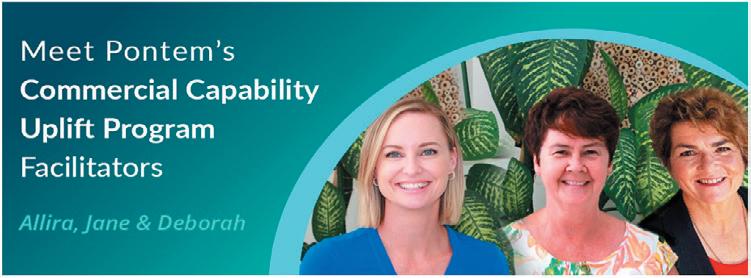
We understand that as a busy leader in the Community Care sector, you may not have had the time or resources to invest in understanding the bigger picture of what’s happening in the Community Care sector and/or building business management skills. Commercial capability is becoming increasingly important, as Government funding shifts to a more competitive and client-led environment. That’s why Pontem developed our Commercial Capability Uplift Program, specifically developed by leaders, for leaders in the Community Care sector. Including valuable tips and insights from Executive Coach, Deborah Johnston, our aim is to appropriately balance client care and commercial acumen, to ensure you and your organisation continue to grow sustainably – supporting thriving community care.
About Pontem’s Commercial Capability Uplift Program:
• Six modules (Aged Care Foundations, Finance Essentials, Future Planning, Budgeting/Forecasting, Reporting Excellence, Organisational Governance).
• Each module comprises a self-paced digital learning module and 90-minute group learning sessions
• Access a host of practical resources, tools and templates ready for you to apply in your organisation
• Three-month program
• Your individual Team Management Profile providing insights to your work preferences and style
• Expand your peer network in a supported environment
We also offer an exclusive tailored program for organisations that would like to develop groups of 12 or more leaders.
Enquire today to stay ahead of the pack!
Phone:
69 WORKFORCE & TRAINING
496 Email:
0427 148
hello@pontem.com.au Web: www.pontem.com.au/commercial-capability-uplift-program
Uncover the power of employee offboarding
The benefits are too good to miss
Shifting the spotlight onto offboarding isn’t just about goodbyes; it’s a strategic pivot towards staff retention, recognising that the last impression can be as crucial as the first.
As aged care workers bid adieu to their roles, the art of a compassionate farewell should take center stage. It’s not merely a departure; it’s a purposeful transition that reflects the heart of an organisation and shapes the legacy left behind.
When done well, offboarding – the systematic and formalised process which an oganisation follows when an employee leaves – can fortify the foundation of a committed team.
Your workforce, your most valuable asset, provides departing employees the opportunity to candidly express their perspectives on the positive and negative aspects of their employment, ultimately providing them with a sense of acknowledgement, and subsequently implementing deliberate measures that advance organisational excellence.
A nationwide study of personal care workers’ employment intentions and employee turnover conducted by Deakin University, is delving into the experiences of current and former personal care workers in residential aged care, with initial findings revealing a notable oversight in dedicated employee ‘offboarding’ process from the perspective of personal care workers.
Aged care operators and executives allocate significant resources, time and effort into recruitment and onboarding, but offboarding should demand the same level of energy because it returns valuable data to support other HR practices in the organisation, for continuous improvement strategies.
During the offboarding process, aged care operators undertake several tasks including:
■ conducting exit interviews to gather feedback
■ collecting equipment owned by the organisation provided to the employee in order to conduct their role (e.g. company phone or laptop)
■ transferring employee job responsibilities
■ deactivating access rights and passwords
■ finalising administrative tasks.
For aged care operators and executives who may not have an offboarding process, the first step involves scrutinising your existing HR processes and, if necessary, developing policies, procedures and templates to guide and support your offboarding process.

How effective onboarding can help
Organisational culture. The treatment of departing employees serves as a reflection of the overall culture of the organisation, exerting influence on employee morale and engagement. Remember other employees are watching, and listening and are affected by how their friends and colleagues are treated.
Knowledge retention. A systematically structured offboarding process ensures the seamless transfer of departing employees’ knowledge and expertise to remaining team members, safeguarding critical organisational knowledge.
Smooth transition. An organised offboarding process facilitates a smoother transition for both the departing employee and the team, minimising disruptions and enabling the seamless handover of responsibilities, enhancing operational continuity.
Positive reputation. Treating departing employees with respect and ensuring a positive offboarding experience contributes significantly to the organisation’s reputation. Former employees departing on good terms are more inclined to speak favorably about the organisation, enhancing its brand and attractiveness to potential talent.
Alumni network. Fostering positive relationships with former employees can lead to the establishment of an alumni network, wherein former employees become valuable assets.
Legal compliance. A structured offboarding process ensures aged care operators adhere to the legal obligations.
Cost savings. An effective offboarding process yields cost savings by minimising expenditure related to recruitment, onboarding, training and costs associated with employee turnover.
Succession planning. When executed strategically, offboarding contributes to an organisation’s succession planning efforts by identifying potential successors and preparing them for new responsibilities.
Continuity of care. A well-structured offboarding process ensures that care remains a top priority during periods of employee changes, ensuring the uninterrupted provision of care for residents and support for their families.
To find out more or to be involved in my nationwide study exploring the employment intentions of personal care workers as a PhD candidate or to seek assistance in reviewing your offboarding process, please get in touch.
Britt O’Keefe, Specialist Advisor and Deakin University PhD Candidate, Anchor Excellence. www.anchorexcellence.com
70 WORKFORCE & TRAINING

specialising in transformative solutions for the Aged Care industry. Their offerings, deeply integrated with advanced data management and ERP systems, enable aged care providers to streamline operations, ensure data security, and improve decision-making.
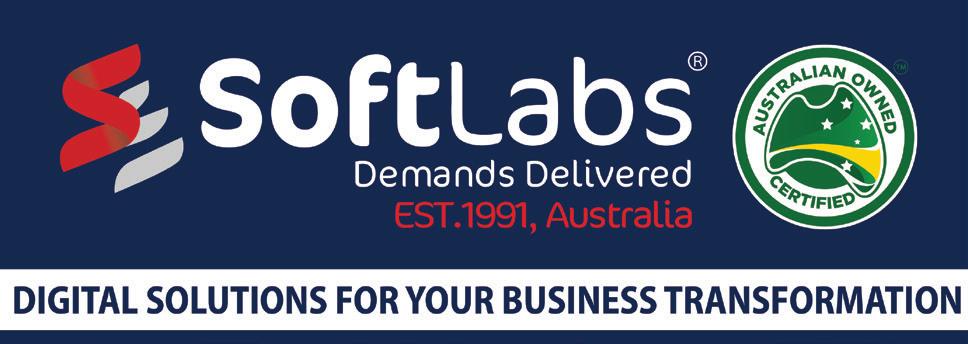
leader,
Aged Care
Contact us 1300 207 208 (Contact Rade Bogadanovic, Director-Products and Solutions) business@softlabs.com.au www.softlabs.com.au/erp-for-care/ Aged Care ERP that can help personalise services for clients Aged Care ERP that can centralise the organisation’s financials Aged Care ERP helps facilitates and improve Community and Residential care services Aged Care ERP helps streamline residential end-to-end management Aged Care ERP helps senior living facilities make better decisions
SoftLabs is an Australian enterprise software
Software Solution Provider



72 Awards 2024 Announcing the inaugural ACCPA Excellence Awards. Join us on Aged Care Employee Day, Wednesday 7 August 2024, to celebrate the awards finalists who will be selected from the strongest You are ACE! nominations. accpa.asn.au/ace
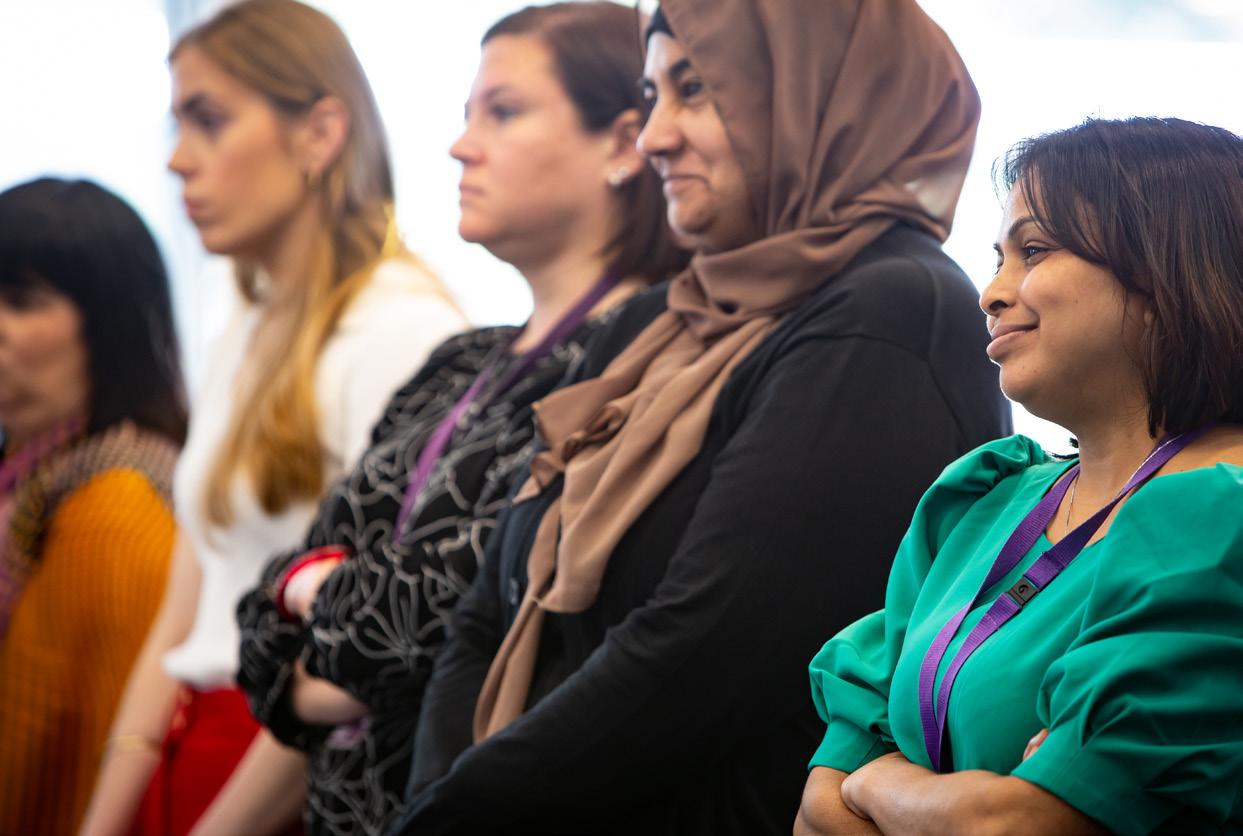
Shedding light on common cultural misunderstandings
New training program equips aged care workers with skills to support culturally diverse seniors
Is it always polite to say ‘please’ and ‘thank you’? Is avoiding eye contact with someone a sign of disrespect?
Depending on your cultural background, the answers to these questions could be vastly different. It’s something that I observe every single day working at Settlement Services International (SSI), where our team collectively speaks more than 100 languages. But rather than being a burdensome challenge, this diversity has become our greatest strength.
Understanding how to confidently and capably navigate cross-cultural nuances helps our organisation to reach 60,000 people from diverse cultural and social backgrounds each year, delivering effective programs that help individuals, families and children to achieve their potential in life.
Many organisations aren’t as fortunate to have this kind of diversity, including some in the aged care sector. Others do but haven’t yet been able to unlock their full potential.
With 518,000 additional new arrivals to Australia in the 2023 financial year, as well as a rapidly ageing multicultural population, understanding how to navigate cultural nuances will be a key challenge for the aged care sector in the coming years.
In fact, the feedback that we’ve received from aged care providers while delivering the government-funded Home Care Workforce Support Program is that there is an urgent need for practical training which directly addresses the real-world challenges faced by workers.
For this reason, SSI has launched a new online learning program to train aged care workers on culturally-responsive support for seniors from diverse backgrounds.
The importance of this new training can’t be understated. Culturally responsive care is a proven way to boost health outcomes and quality of life for seniors from diverse backgrounds, and providers are working increasingly hard to accommodate the unique characteristics and life experiences of individuals, which might include arriving in Australia as a migrant or refugee.
Our target is to train 14,600 aged care staff within 18 months, helping providers to unlock the proven benefits of this personcentred approach by significantly raising the skill level of direct care workers in interacting with culturally diverse seniors.
In doing so, we will reduce barriers for seniors accessing healthcare, increase customer satisfaction and business performance for aged care providers, and improve retention of direct care workers within the short-staffed industry.
Equally important is the fact that the learning program educates direct care workers about self-care. It’s vital that support workers, who often come from diverse cultural backgrounds themselves, also understand their rights to be respected and safe at work, and the options available to them should they experience racism.
This new training program is coming at a crucial time. The Australian government has identified that migrant workers will be key to filling worker shortages in the aged care sector, with a total of 110,000 additional home care support workers needed by 2030 to meet the unprecedented demand from Australia’s ageing population.
Furthermore, approximately 37 per cent of Australians aged 65 and over were born overseas, emphasising the need for all workers to learn about navigating cultural contexts and nuances to avoid cultural misunderstandings in a care setting.
The opportunity is huge for the sector, but if there’s one thing that I hope organisations in aged care understand, it’s that simply having a diverse team doesn’t mean that you automatically reap the benefits.
At SSI, we have carefully built our team’s cross-cultural capability over many years, which enables us to help others. If you are interested in learning more about SSI’s diversity training program for the aged care sector, interactive workshops, or customised training for your organisation, please reach out to us.
Janet Irvine, SSI Diversity Training Manager, Settlement Services International (SSI) www.diversity.ssi.org.au/aged-care-courses
73
Lifting leadership capacity for strategic change
A case study from Meals on Wheels in South Australia
In today’s world, many leadership teams struggle with implementing a strategic change, often falling short in delivering the transformational outcomes expected by the board.
One of the biggest challenges is dealing with the unprecedented volume of change we are seeing in the aged care sector. Leaders will often resort to ‘designing strategy and change in the back room’. It’s often done with the best intent, to protect their people’s capacity.
However, when change gets pushed out to already overloaded teams, your people just end up struggling to make sense of it.
It’s likely that the changes are not human-centred and the process makes it challenging for leaders to ‘get it’ and just start behaving differently the next day.
The early steps at Meals on Wheels SA
Meals on Wheels is South Australia’s largest community-based volunteer organisation, responsible for 80 branches, 7,000 volunteers and 60 staff delivering 4,000 daily meals and supporting 11,000 people annually.
The organisation had already embarked on a journey of significant transformational change before they engaged an external consultant.
They recognised the need to approach things differently and lift their leaders’ capacity to navigate transformational change.
Meals on Wheels SA CEO Sharyn Broer understood the importance of aligning with the organisation’s purpose and engaging the ‘head, hearts and hands’ of their people to help foster ownership for the upcoming changes.
Sharyn also recognised the need to avoid introducing additional complexity with another framework, and manage the capacity of leaders and their teams while maintaining business as usual.
Lifting leaders’ capability with ‘learning by doing’
To address these challenges, Sharyn collaborated with Fire up Solutions, a specialist in ‘human-centred’ change and innovation. Together, they tailored an approach that was fit for purpose for Meals on Wheels SA and proven to rapidly improve performance in leading change by over 50 per cent.
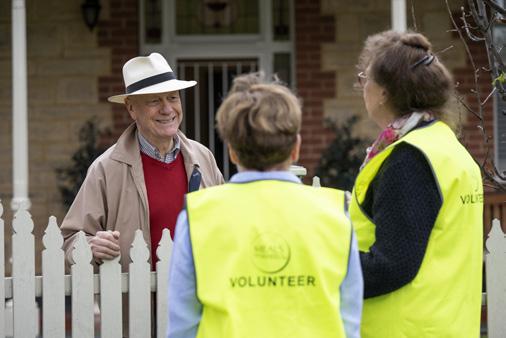
Working with Fireup Solutions, Meals on Wheels SA lifted the capability of their leaders to lead strategic change.
The approach draws on Fire up’s ‘learning by doing’ approach founded on global better practices in human-centred change and innovation (Stanford Centre of Social Impact and IDEO), Leading Adaptive Change (MIT) and Sharyn’s expertise in Leading Change and Organisational Renewal as well as Strategic Perspectives in Non-Profit Management from her study at Harvard Business School.
The ‘learning by doing’ approach puts less focus on ‘formal training’ and more focus on putting their learning into practice as they do real work. The steps tailored for MOWSA included:
■ Realigning the executive team on how to ‘lead through change’ and be more human-centred, rather than directing or ‘pushing out’ change to their teams
■ Introducing all leaders to the core skills needed to ‘lead through change’, challenging their thinking with ‘real world scenarios’
■ Rapidly helping leaders put their learning into practice as they do real work:
– Preparing them to run a simple series of ‘learning circles’ to introduce the skills to the remaining frontline leaders and start putting their own skills into practice
– Consolidating learning for all leaders and building ownership for changes, by bringing together a crosssection of leaders in collaborative forums to solve one of their biggest transformational challenges
– Reinforcing the learning supported by light touch guidance, tools and coaching.
The significant benefits
The benefits of this approach are significant.
What we have seen is that our approach enables leaders to rapidly build capacity with much less investment than a conventional leadership development program.
With our ‘learning by doing’ method, we can help manage the organisation’s capacity so everyone can continue to deliver business as usual.
Ultimately, we see leaders demonstrating a more ‘humancentred’ approach that involves their teams in implementing strategic changes and ensures your changes stick – which is the goal for every organisation.
Angela Frith, Co-founder, Fire up Solutions www.fireupsolutions.com
74 WORKFORCE & TRAINING


HESTA ABN 64 971 749 321 is issued by H.E.S.T. Australia Ltd ABN 66 006 818 695 AFSL 235249. Consider whether this product is appropriate for you by reading the PDS and Target Market Determination at hesta.com.au/pds. For more information on Super with impact, see hesta.com.au/impact. At HESTA, we invest time in your super, to help you invest in your future. Our online Future Planner tool, Retirement Income Stream, and Transition to Retirement Income Stream are just some of the many ways we’re supporting our members to retire with confidence. Learn more at hesta.com.au Face the future with confidence.

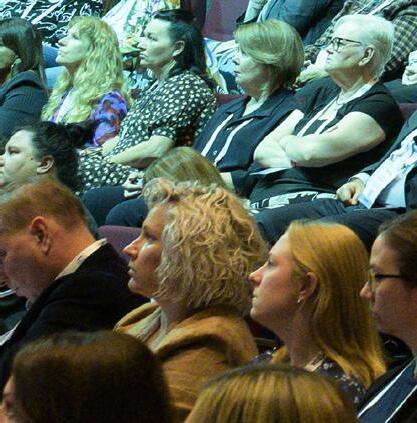
Conferences 2024 FROM VISION TO REALITY: AGED CARE’S JOURNEY FORWARD
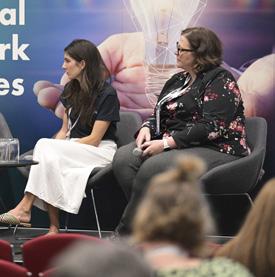
ACCPA is proud to unveil its dynamic conference agenda for the year ahead where leaders in aged care will have the opportunity to gain insights from expert speakers and presentations whilst networking with industry peers.
With the conferences’ theme of From Vision to Reality: Aged Care’s Journey Forward encapsulates the dynamic evolution of the aged care industry. This reflects the industry’s commitment to turning visionary ideas into tangible, impactful outcomes. It underscores the ongoing need for innovative strategies, cutting-edge technologies, and progressive management approaches in addressing the evolving challenges and opportunities within aged care. The theme inspires a forward-looking mindset, encouraging all stakeholders to navigate the complexities of the aged care landscape and transform visionary aspirations into concrete realities. It symbolises a continuous journey of adaptation, collaboration, and proactive engagement to meet the changing needs of an aging population and shape a positive future for aged care.
2024 Conference dates
29 April – 1 May 2024
Queensland Conference The Star, Gold Coast 27-29 May 2024
Western Australia Conference Crown, Perth 11-13 June 2024
Victorian Conference Pullman Albert Park, Melbourne 19-21 June 2024
New South Wales/ Australian Capital Territory Conference Hilton Sydney 23-25 October 2024
National Conference Adelaide Convention Centre, Adelaide
We look forward to seeing you at our next conference!
For further information, please visit www.conference.accpa.asn.au
Analysis of AN-ACC rate increase and industry trends
What does it mean for you?

Last year ended with a welcome surprise for providers. On 1 December, the Department of Health increased the AN-ACC starting price by 4.4 per cent to $253.82. This was on top of an increase from $216.80 to $243.10 on 1 July 2023.
So, why did the rate go up again and does that mean it’s time to celebrate? Although it is positive news, maybe it isn’t time to let our hair down just yet –let’s look at what this increase means for the industry.
What led to this decision?
In June 2023, the Fair Work Commission (FWC) released their decision on the Annual Wage Review (AWR). Regarding aged care, the primary outcome handed down by this investigation was that the minimum rates under the Nurses’ Award would increase by 5.75 per cent from 1 July 2023.
So, although we received a significant boost to the AN-ACC starting price on July 1, the FWC AWR decision had not been factored in. To fund the decision, in July 2023 the Independent Health and Aged Care Pricing Authority (IHACPA) recommended that the AN-ACC starting price increase from $243.10 to $249.34.
On 1 December, the Department responded by increasing the AN-ACC starting price to $253.82.
The decision to increase the starting price above the IHACPA’s recommended rate was to effectively ‘back pay’ providers to when the minimum award rate was mandated, as if the starting price increase had occurred on 1 July 2023.
It’s important to note that providers will not actually receive a lump sum back payment. Rather, this increased rate will make up the difference as if the starting price had been increased to $249.34
for the period between 1 July 2023 and the next scheduled rate change later this year.
On 15 March 2024 the FWC announced further wage increases between 3.2 per cent and 13.5 per cent in their Stage 3 decision. This may impact the future AN-ACC starting price above standard indexation.
What
are
the takeaways?
We have conducted a benchmarking analysis to provide some meaningful takeaways for the industry.
As of 31 December 2023, our MyVitals benchmark demonstrated that the average total AN-ACC daily funding was $269.92 per resident. Without the rate change, this would have otherwise been $258.52 per resident – an increase of $11.40 per day.
Taking a mid-sized 60-bed facility, the impact of this daily increase results in an additional $684.00 per day, or $249,660 of annual funding, on average.
Meanwhile, using the average costs of delivering this care, we estimate the 5.75 per cent increase to the Nurses Award adds $113,685.32 to employment costs each year.
Extrapolating this out for the 188,000 residents in residential aged care (per the Australian Institute of Health and Welfare 30 June 2022), this rate increase produces an additional $782 million for the industry.
What about ongoing reclassification?
Of course, parallel to this, regular workflow is ongoing to ensure that all residents’ care needs reflect their ANACC classifications.
Looking at the period October to December 2023, our benchmark demonstrates that the average reclassification outcome has dropped 4 per cent compared to the period July
to September, but this is still a 10 per cent increase compared to the period April to June.
The reclassification rates have maintained consistency between these quarters, which suggests that providers have not dropped off on submitting residents for reclassifications where their care needs change.
All of this indicates that the industry’s reclassification outcomes are stabilizing, and AN-ACC assessors and facilities appear to be working effectively in tandem to reach more consistent outcomes.
This will remain a key area to consider in 2024 and will be a crucial metric for determining the efficiency of your facility’s reclassification workflows through comparison to a stable benchmark.
So, is it time celebrate?
All things considered this is welcome news for the industry and it’s great to see that our carers and nurses are rewarded appropriately for all their hard work and ongoing effort to deliver quality care.
However, you may need to hold off on the champagne until you’ve considered how the increase impacts your organisation.
While many providers already pay above the award, it’s important to ensure you’re compliant with the new increase.
For assistance with analysing where your organisation stands in relation to AN-ACC and resident reclassifications, please reach out to Provider Assist. Our MyVitals analysis has been used by providers across Australia, with outstanding results.
Peter Morley, CEO & Co-owner, Provider Assist
www.providerassist.com.au
77 GOVERNANCE & FINANCE

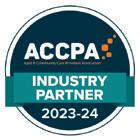
Working together to support and empower your frontline staff. The way consulting should be.
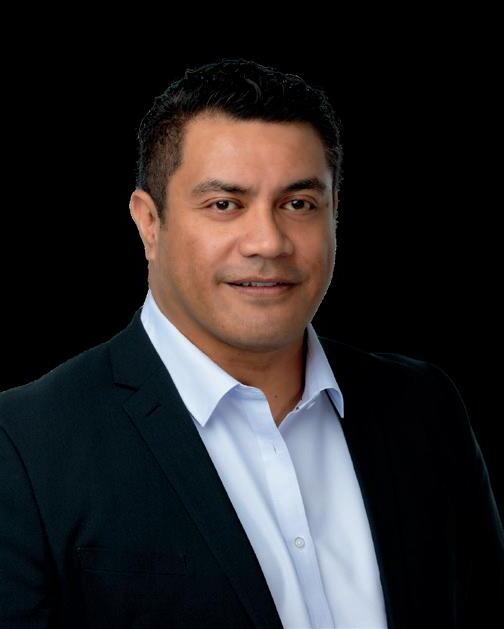


mailbox : info@ccadvisory.cc
Book a free consultation: 0410 523 412 Comprehensive audits with current systems and processes for all consumers and staffing roles for your accreditation needs. Audits & Accreditation Working with your staff to understand their roles in developing care plans, behaviour support plans, identifying clinical indicators. Assessment & Planning Working with your Senior Executives and management together with the Board of
to understand their governance responsibilities. Corporate Governance C O N N E C T C A R E A D V I S O R Y Connect Care Advisory can support your organisation with: Solutions for Aged & Home Care providers
website : www.ccadvisory.cc
Directors
Making regulatory change easier in 2024
Answering some simple questions can help you prepare for big changes
On 14 December 2023 the Exposure Draft Aged Care Bill 2023 was released for public consultation, with significant changes on the horizon.
Once approved, the aged services industry can expect a single go-live date of 1 July 2024, which includes commencement of:
■ new Aged Care Act
■ new regulatory model
■ strengthened Aged Care Quality Standards
■ single assessment system
■ new accommodation framework
■ national worker screening.
Rather than the current Aged Care Act 1997, which is structured around approved providers and how they are funded, the new Act will be rightsbased and person-centred, relying on international conventions such as the Convention on the Rights of Persons with Disabilities and the International Covenant on Economic, Social and Cultural Rights.
The Aged Care Quality and Safety Commission (the Commission) will oversee the performance of aged care providers through risk-based monitoring. Their new approach has already commenced with audits underway to ensure compliance with regulatory changes that are already in effect.
To do this, the Commission is relying on data and regulatory insights to identify potential risks and issues – with the aim to take a targeted approach in identifying risks prior to harm being caused to older people.
Where is the industry heading?
The structure and constitutional foundation of the new Act emphasises the need for positive culture changes across the sector, with a heightened focus on continuous improvement as well as preventing substandard care by clearly defining high quality care within the legislation.
The strengthened Aged Care Quality Standards and reportable requirements that will provide the framework and measure for compliance sector-wide.
Registered providers should already be working towards transitioning to the new regulatory model in preparation for the single go-live date.
What actions should providers be taking?
The Australian Government, Department of Health and Aged Care, and the Commission, have all remained resolutely committed to the July 2024 timeline.
Therefore with time running out before the new changes expected to come into effect, registered providers should be considering what resources, systems, data and risk management can be undertaken now, to avoid panic later.
We all know excellence in governance starts with understanding your organisation.
Here are some key questions to consider when undertaking reform transition activities:
1. With the focus shifting from provider to older people in the new legislation consider how your organisation is engaging with older people. Is the engagement meaningful? What can the organisation do better?
2. There are significant changes that relate to ‘responsible persons’ of registered providers within the new Act. Do all your ‘responsible persons’ understand their obligations and responsibilities along with the penalties and fines proposed in the Exposure Draft Aged Care Bill 2023?
3. The new legislation enhances the powers of the regulator and there is significant focus on risk management and continuous improvement. Has your organisation conducted a self-assessment and reviewed the Plan for Continuous Improvement to incorporate transition planning, identify and mitigate risks to older people?
4. As these reforms are changing the landscape of aged care, planning is key to compliance and a smooth transition. Does your organisation have a reforms strategy? Does the strategy involve older people?
5. Knowledge sharing among your workforce is necessary for optimal performance. Is your workforce across the regulatory changes? What education or training is planned prior to 1 July 2024 for everyone – from your governing body to frontline workers?
6. Alignment of systems, policies and procedures is crucial to ensuring effective governance. Have you completed an audit to determine if you have the right systems in place to support the organisation now and into the future? Do your policies and procedures align with the new legislation?
7. How confident are you in your ability to paint a picture of risk that aligns with the expectations of both the elderly residents and the Commission?
Do you need help to act?
With only months until the new regulations are implemented, now is the time to act.
Mirus Australia, through their Aged Care Reform Transition Support, has been helping providers ranging from single facilities to large-listed organisations to manage the complexities of the aged care reform agenda, demonstrating an understanding of the diverse operating models and structures across the spectrum.
To ensure a smooth and successful transition, providers should be reviewing their position and undertaking reform transition actions, as a matter of urgency.
Katie Airey, Manager Quality, Risk and Compliance, Mirus Australia
www.mirusaustralia.com
79 GOVERNANCE & FINANCE















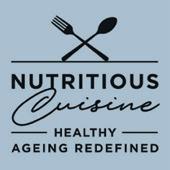
Aged care insurance outlook for 2024
Navigating the implications of upcoming negligence laws
In December 2023, the Commonwealth Department of Health unveiled a draft of new legislation that marks a significant revamp of the Aged Care Act 1997 (Cth) (referred to as the ‘Aged Care Act’). This legislative proposal is integral to the enhanced Aged Care Quality Standards.
Under proposed new aged care legislation, board members and individuals deemed to be ‘responsible persons’ of registered providers may soon face significantly increased penalties, including substantial fines and up to five years in prison, if found guilty of the most serious offences.
Despite many already taking diligent measures to improve the governance of their respective organisations, executives and board members appear to be set to face increasingly significant liability for failure to properly govern.
To minimise the risk of significantly heightened penalties, executives and board members of aged care providers should consider a number of measures to ensure they are properly protected, including consideration of insurance risk mitigation strategies.
Management Liability/Directors & Officers’ Liability (D&O) insurance, and Statutory Liability insurance are the two policies most likely to play a part in responding to such fines and penalties.
In this article, we outline the key considerations that executives and board members should take into account for these types of insurance.
Management Liability/D&O insurance
From an insurance perspective, a director’s governance risk is mainly addressed by D&O insurance, designed to help protect the personal assets of directors and officers of a private or public provider for claims arising from
alleged wrongful acts committed by directors and officers in their capacity as governors of the organisation.
Some Management Liability and D&O insurance policies can help provide cover for legal costs and fines due to breaches of laws.

It is worth checking to see how much cover is in place and if there are special exclusions related to pollution or environmental damage that a specialist Statutory Liability policy would be designed to cover.
Statutory Liability insurance
Statutory Liability insurance can be purchased by the organisation either as part of its Management Liability policy, or on a standalone basis alongside its D&O insurance.
Statutory Liability cover is a specialist type of insurance designed to help protect organisations from legal expenses if they were to breach an act of legislation. In addition to helping to provide cover for the insured in respect of a possible fine, these policies can help cover any reasonable legal and investigative fees that will also be likely to apply.
Cover will apply to both individual directors and officers, as well as the organisation itself.
However, Statutory Liability policies generally will not provide cover for taxes or workers’ compensation premium imposed by way of penalty, superannuation liability or penalties that are uninsurable at law.
Other typical examples of exclusions found in Statutory Liability policies include gross negligence or recklessness and deliberate or intentional acts.
To ensure appropriate cover, it is important to clearly define the individuals that require access to the cover, particularly if board members are
volunteers, or where the organisation is constituted under legislation other than the Corporations Act 2001 (Cth).
Work Health & Safety breaches
In New South Wales, Western Australia and Victoria, insurers are prohibited by law from offering coverage under an insurance policy for breaches of Work Health & Safety (WHS) legislation.
Other states and territories are also expected to pass similar amendments to their WHS laws.
However, it is worth noting that the prohibition of this type of insurance cover is only for the fines and/or penalties themselves. Cover is still available for costs of defending an investigation or prosecution.
Reducing the risk
To prepare for the possibility of heightened penalties being incorporated into the new aged care legislation, Lockton recommends that individuals holding positions as board members or executives conduct an immediate selfassessment of their existing risk exposure.
The extent of an individual’s risk will hinge on specific factors such as the type of organisation, the state of operation and the specific aspect of care delivery they provide.
Organisations are also advised to consult with a professional insurance advisor regarding Statutory Liability insurance to ensure that individual board members and executives within an aged care provider have appropriate cover in place.
Lyle Steffensen is Manager - Industry Strategy & Innovation, Health & Community Service, Lockton Australia. www.lockton.com
81
GOVERNANCE & FINANCE

Positioning for Support at Home program changes
Why a multi-service model makes sense
Without overdramatising, there is a small window of opportunity between now and the end of the first quarter of next year to ensure that the aged services industry represents itself in how it deals with the Support at Home (SaH) program amalgamation, scheduled to start from 1 July 2025.
The industry needs to collaborate as a mature, well-led voice, to ensure a business model that enables quality service delivery, encapsulated in a viable and sustainable financial framework.
This includes mapping out how to address the impending changes and how that impacts the Government’s plan for a ‘continuum of care model’ from the first point of contact with a client to the last point of service – a seamless delivery model that allows the history, care initiatives and preferences of clients to transition from service to service.
Significant structural changes need to be addressed in preparation for the next interim SaH program phase. These changes will have a direct impact on how providers deliver services going forward and sustain themselves as viable entities into the future.
Not all will survive, mainly due to lack of preparation and planning.
Reassess your business model
To successfully manage the changed delivery model under the SaH, current business models need to be reassessed. Providers should consider addressing the following:
■ What does viability and sustainability look like under the new model?
■ What mechanisms or levers do providers have to deliver quality services in a price fixed system?
■ Will SaH services be further expanded, given the greater emphasis on services being delivered in the community rather than residential care?
■ How will an expansion in home care impact on residential care providers, in particular occupancy rates?
■ Should providers broaden their service delivery model to cover multiple care options?
■ Will residential care providers need to consider including SaH and possibly NDIS servicing?
■ To offer multiple care options across the continuum, are partnerships a viable option, as opposed to expansion of service?
■ How can client data be moved with the client across the care continuum easily, to make care needs, history and preferences accessible, and to prevent loss of crucial information in the process?
The key consideration should be this: by promoting a multiservice care model, providers will unlock a wide range of synergies.
Expand your services
As part of the upcoming SaH amalgamation, providers in residential care should consider either forming business partnerships or expanding services laterally by directly taking up the delivery of other compatible care models.
SaH and NDIS providers may have trouble expanding into residential care, due to the barrier capital requirements imposed.
However, they could consider expanding into residential care through business partnerships or other mutual support arrangements.
82
GOVERNANCE & FINANCE
Photography by Freepik.
If a residential provider chooses to expand into communitybased services, it is far less significant in reverse, as existing infrastructure should easily allow for such expansion.
Competing across a range of sectors can lead to increased client numbers per provider, and activate the following benefits for the provider:
■ reduced overheads per client
■ infrastructure and service sharing
■ increased flexibility and more efficient service delivery models
■ lower individual client margins
■ a complete service offering model
■ more employment opportunities for staff
■ consistent policies and practices across the care spectrum
■ greater efficiencies when moving clients across the care spectrum, due to shared data and records.
Take action now
There is no doubt the environment will continue to change.
Unless individual providers take the initiative to get ahead of further change by adopting new models, negative impacts are more likely than not.
Providers should be seeking IT support now, so they can transition to the new arrangements ahead of time.
A phased-in transition, your software needs to be sufficiently flexible to accommodate continuation of existing clients using the current model, while simultaneously taking up new SaH clients in the new program.
Therefore, early planning and positioning with an IT organisation that can meet the new requirements in a cyber secure environment, should be the main focus of providers going forward.
e-Tools Software is a leading provider of module-based software applications to assist aged care providers, including those in community care (home care and home support) and NDIS (disability) sector plus residential care.
Celebrating our 20th year this year, e-Tools Software’s responsive and affordable software applications have stood the test of time to meet the needs of the industry.
Please visit our website for more information about how we can assist you.
David Powis, Managing Director, and Mae Chin, Marketing Manager, e-Tools Software www.e-tools.com.au
Now you can upskill your employees and help to progress their career while they’re working, with the Certificate III in Individual Support (Ageing) CHC33021 at TAFE NSW.
Delivered through a combination of classroom-based, online and workplace learning, learners can manage their study around work commitments.
Contact TAFE NSW today to discuss how our work-based learning options can support your workforce development needs.
Support their career agedcareproject@tafensw.edu.au

83 GOVERNANCE & FINANCE
RTO 90003 | CRICOS 00591E | HEP PRV12049
Sustainable finance in aged care
Key strategies for good financial planning
The aged care sector has navigated significant transformations amid dynamic changes and sweeping legislative shifts in recent years.
Marked by findings and recommendations of a Royal Commission, the sector has faced increased scrutiny, heightened regulation and complex financial challenges, exacerbated by the COVID-19 pandemic.
As COVID-19 becomes endemic, efforts to implement the Royal Commission’s recommendations have intensified, introducing challenges like increased governance, reporting and care requirements.
Aged care providers, in collaboration with bodies like the Aged & Community Care Providers Association (ACCPA), are working with the government to address these impacts.
However, rising inflation, workforce challenges and demographic shifts are further complicating adaptation.
Navigating this evolving landscape necessitates strategic financial planning in aged care, balancing viability with highquality care provision.
Anticipating future trends and adapting to emerging needs are crucial for long-term sustainability and preventing sector consolidation.
It allows aged care providers to not only improve their financial health, but also directly improve the quality of life for their residents.
Strategic finance is not just about balancing books; it’s about creating an environment where quality care and business sustainability go hand-in-hand.
The following key strategies are essential pillars of a robust financial planning approach for any aged care provider aiming to ensure sustainability, compliance and excellence in care.
Understanding government funding mechanisms
Navigating the intricacies of government funding, particularly AN-ACC, is crucial. It’s not just about the revenue coming in; it’s understanding the cost of providing high quality care for different resident needs.
A good approach is to calculate the daily costs for various resident classifications, factoring in the extra care minutes for higher-needs residents. This understanding allows organisations to optimise their funding strategies and improve financial performance.
Diversifying revenue streams
Expanding service offerings in line with resident expectations, preferences and requirements opens new avenues for revenue generation.
This can include rolling out additional services, implementing a day activities centre, or establishing a home care or independent living service.
Revenue diversification creates financial resilience by building a safety net that can support the organisation through economic ups and downs.
Continuous improvement as a financial strategy
Continuous improvement is a legislative requirement for aged care providers as a mechanism to improve their services against the aged care quality standards

Ariadne Magalhaes says strategic financial planning is a must for long-term sustainability.
However, this tool should be adopted as a systematic way to improve operational and financial performance.
Beyond addressing compliance and care issues, continuous improvement can be an important strategic enabler.
Leveraging technology for financial efficiency
Adopting technology as an enabler rather than the goal itself turns it into a powerful tool to support strategy, however, It is important to keep in mind that technology should fit into the strategy, not the other way around.
Rather than starting with identifying and assessing relevant systems, providers should instead start with reviewing their strategic goals and operational performance targets, and only then look at what systems are able drive these targets.
Workforce development
In the face of increasing workforce shortages – CEDA’s 2022 Aged Care report indicated an annual shortfall of 30,000 to 35,000 direct care workers – developing a compelling employee value proposition is more important than ever.
This strategy involves creating a work environment that improves staff satisfaction and performance and aligns with organisational goals.
Effective workforce development is essential to reduce turnover, increase staff satisfaction and ultimately driving better financial outcomes.
84 GOVERNANCE & FINANCE
Developing a financial management framework
Build a financial framework that is aligned with the organisation’s strategic priorities with the ultimate goal of creating strong financial health, keeping accurate and
transparent financial records, and operating with increased compliance and lower financial risk.
This allows providers to deliver quality care, use funds wisely and stay open to new, cost-effective alternatives to service delivery that also drive value to the business and its customers.

Having a framework can also support meeting the government’s increasing financial reporting requirements
Strategic risk management
Managing strategic risks, especially regarding financial risks, is essential to increase organisational resilience.
This involves identifying revenue and cost sources with increased exposure to uncertainty and formulating appropriate response strategies.
Implementing Key Risk Indicators (KRIs) enables organisations to proactively identify and respond to shifts that could impact their financial stability.
In the ever-changing world of aged care in Australia, developing a financial strategy is more than just a smart move – it’s an imperative.
Ari Magalhaes, Managing Director, OmniSrtategic www.omnistrategic.com.au

Services include:
Fortnightly payroll processing
Fringe benefits and superannuation payments
Pay reconciliation
Simplify payroll and focus on care – it pays to be with ACCPA
ACCPA has been delivering payroll services for Member organisations for over 20 years. Our team have a complete understanding of modern and older awards as well as the many varied enterprise agreements.
We offer professional, cost effective and accurate payroll processing and comprehensive reporting for each pay cycle, each month and at end-of-year.
222 721
Online rostering and time and attendance
Single touch payroll processing
All required activity and tax reporting
Compliance requirements monitoring
Automatic application of pay increases
Benefits of outsourcing
Peace of mind that pays are accurate
Free up finance staff for higher value tasks
Reduce internal administration and cost
Payroll Services
Accurate, timely and reliable.
85 GOVERNANCE & FINANCE
Image by Ari Magalhaes & DALL-E 3.
1300
payroll@accpa.asn.au accpa.asn.au/payroll-claims-billing

Investing in the future of aged care
Three steps for unlocking new capital
The Baby Boomer population is ageing and as a result, there is an urgent need for investment in the residential aged care sector to build new homes and renew existing ones.
By 2063, the share of the population aged 65 and over is projected to increase 6.1 to 23.4 per cent, according to the 2023 Intergenerational Report.
In recent years, the sector has been marked by financial losses and significant quality reforms, reducing its appeal for investors.
But as the Federal Government implements the bulk of its reforms in 2024 – and a new co-funding model is expected to be introduced – the time is ripe for investors to reevaluate the sector’s potential.
The Aged Care Financing Authority estimates that approximately 79,000 places in residential aged care will be needed by 2030, and a quarter of existing stock will require either refurbishment or total reconstruction.
The financial implications of this shift are significant: an estimated capital expenditure of $51 billion will be needed over the next decade, representing more than 2.5 times the sector’s total investment from 2010 to 2019. Providers equipped with strategic foresight stand to gain from this anticipated influx of new capital.
Given the length of time it takes for greenfield sites to be built, and the substantial new capital requirements, many residential aged care providers are preparing tailored strategies to attract capital over the next five years.
When seeking new capital investment, there are three steps providers must take to maximise their chances of success.
1. Build a comprehensive business plan
A compelling and comprehensive business plan is the bedrock upon which aged care providers can build investor confidence.
This plan should demonstrate the provider’s growth expectations, pointing to favourable macroeconomic conditions and their alignment with the provider’s objectives.
With the current political and economic environment in mind, the plan should illustrate how the organisation is poised to benefit from proposed funding model changes and aged care sector reforms.
Well-researched strategies for meeting anticipated future demand must be included, as well as an outline of how current facilities can potentially be adapted to meet these expectations.
The business plan must address regulatory compliance issues, risk and governance, as well as the overarching challenges facing the sector, clearly articulating how the provider addresses each of these areas.
A thorough market analysis within the business plan is also crucial, identifying target demographics, understanding market trends, and evaluating competitors.
Highlighting an aged care facility’s unique selling points and competitive advantage will allow providers to effectively market the business to potential investors.
2. Create a fit-for-purpose financial forecast
A detailed financial forecast model is an essential tool to showcase an organisation’s financial health, growth potential, and return on investment.
Comprehensive integrated income statements, balance sheets, and cash flow projections are usually included.
In our experience, the best financial forecasts extend over a realistic timeframe, which allows investors to better assess a provider’s long-term financial strategy.
Key financial metrics must be clearly shown, including occupancy rates, average revenue/EBITDA per resident and operating expenses.
86
GOVERNANCE & FINANCE
The model should also account for potential contingencies and risk mitigation strategies, demonstrating an organisation’s proactive approach to financial challenges.
Transparency is critical when communicating the use of proposed new capital. A model that clearly outlines how investment will be allocated – whether for facility upgrades, a new site or technology integration – will instil investor confidence regarding a provider’s strategic planning and commitment to growth.
Finally, any financial model should be thoroughly reviewed and vetted to ensure it is free of material errors.
3. Develop a digital maturity strategy
In an era where technology is a key differentiator, aged care providers must articulate their digital maturity strategies. Investors are drawn to providers who leverage technology to enhance quality of care, improve resident satisfaction, introduce operational efficiencies and minimise back-office processes.
Aged care facilities should have a clear digital maturity strategy in place, outlining how technology has been integrated across various operations and supporting staff training on these new technologies.
The NEW ACCPA Governance Portal
Are you an aged care provider in need of governance support?
ACCPA has partnered with Convene to develop the ACCPA Governance Portal – a private, secure online hub for managing your governing body and committee meetings. Contact
Among other things, a digital maturity strategy may include the implementation of electronic health records for streamlined healthcare and medicine management, the use of communication platforms for efficient resident-family engagement, and the adoption of smart technologies to improve safety.
A commitment to digital maturity and appropriate measures for securing sensitive health data will also enhance resident experiences.
Building investor confidence will be pivotal to overcoming the sector’s current challenges and capitalising on its projected expansion.
The future of aged care will depend on significant investment, strategic foresight, robust planning and most importantly, a willingness to embrace the transformative opportunities ahead.
Through a comprehensive business plan, detailed financial forecast, and a forward-thinking digital maturity strategy, aged care providers can position themselves as ready for this growth.
Selina
Gerner, Partner, McGrathNicol Advisory www.mcgrathnicol.com

aged care
Key features:
High-level encryption 24-hour support
Meeting scheduler with built-in conflict checker
Drag and drop files to create agendas
Publish meeting packs with auto-syncing of amendments
Review and annotate documents online and offline
Supports in-person or online meetings
Collaborate and share files with permission-based access
Voting support tools including e-signature and review rooms
Create minutes and actions with instant access and tracking
87 GOVERNANCE & FINANCE
more information
quality@accpa.asn.au for
and a free demonstration Supporting good governance in
The ACCPA Governance Portal is powered by Convene Pricing is based on number of users for an annual subscription and ACCPA members receive a 20% discount
Financial risk in home care reform
More clarity is needed, fast
One of the byproducts of the Support at Home reform program is the continuing uncertainty it creates for investment in the sector, with the Department of Health and Aged Care delaying the rollout of the new program until at least 2027.
While this delay means providers have more time to prepare, the lack of detail on the new funding system for the existing Home Care Package program increases the strategic risk for providers.
This has impacted the flow of investment into expansion activities, strategic investment in business operations and the financing of home care businesses.
While we are seeing some merger transactions among not-for-profit operators, these typically do not involve an outlay of funds.
However, where businesses wish to sell their home care operations as part of a restructure of their other business operations, or wish to exit the market entirely, completing transactions is proving to be challenging.
The central issue is in creating appropriate valuation models. There is a gap between the expectations of buyers and sellers.
Anecdotally, we are observing that vendors are using historical models while purchasers are using models that adjust for uncertainty.
Buyer valuations typically reflect no more than half of what businesses have achieved historically in a more stable market. On the positive side, this represents some improvement on where valuations were twelve months ago.
Business valuations are heavily dependent on the perceived future risk of achieving forecast cashflows.
This is particularly true where there are limited tangible assets as is the case in home care businesses, which impacts models in two ways.
First, the discount rate applied to these cashflows tends to be higher, and secondly, purchasers tend to be more conservative with their estimates of future revenue.
If we had more clarity on the reform outcomes, there would be more certainty of cash flow, and a purchaser would be willing to pay a higher price for those cash flows.
There are significant transactions that are overdue for closing at the time of writing this article.
The myHomecare business is the most notable and has had several false starts in recent years. It was built through a series of acquisitions in a more stable environment, and with the associated higher valuations.
The current uncertainty and associated lower valuation multiples are creating a significant challenge for the owners in exiting this business without losing money for their investors.
As these transactions close or fail, they are likely to provide insight into risk appetite across the industry.
If industry rumours at the time of writing prove to be accurate, strong valuations are not likely to be achieved.
A consequence of this is a slowing in consolidation, as providers hang on hoping for higher valuations as the reform pathway is clarified.
These valuation models also have a flow-on effect on other transactions. For example, raising senior debt is difficult
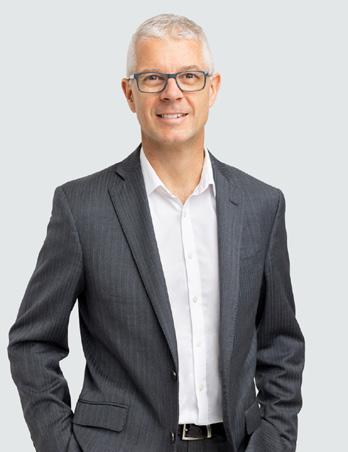
at the present time, and is likely to need to be secured against assets apart from future cashflows, such as property or personal assets.
There are also strategic challenges for organisations looking to invest funds in efficiency gains. Assistive and monitoring technologies are two examples of this. The uncertainty may also inhibit investment in human resources or customer-facing initiatives.
The business cases for these investments in these areas depend on the economic benefit that the investment is expected to deliver. Without clarity on funding, it is difficult to develop informed business cases for these investments.
All providers have an interest in reducing the financial and strategic risk the industry is facing. The continuing delay of fundamental reforms and current conditions have resulted in years of lost opportunity to meet the needs of consumers.
There is very little trust in the system at the moment on the part of investors, including banks, creating challenges for providers. Our fear is that the most recently announced delays mean this will continue.
I encourage all providers to get behind ACCPA advocacy initiatives to resolve this uncertainty so we can create a vibrant and competitive industry that benefits consumers.
Jason Howie, Partner, Pride Living www.prideliving.com.au
88 GOVERNANCE & FINANCE
Jason Howie says the lack of detail regarding home care reform is slowing investment into the sector.

The importance of finance governance in home care
Key principles for success
As the aged care reforms are implemented, there are critical issues that home care providers may face in terms of finance governance.
Adapting to the new funding model based on the needs and preferences of clients, rather than the availability of providers, may require providers to review their fixed and variable costs to come within new price caps and ensure transparency and accountability in their financial reporting.
Meeting the increased regulatory requirements and standards that will be enforced by the Aged Care Quality and Safety Commission may require providers to invest in improving their governance and risk management systems and processes, and to comply with the new reporting and attestation obligations.
Managing the financial sustainability and viability of their services in a competitive and dynamic market environment may require providers to diversify their revenue streams, optimise operational efficiency, and seek innovative solutions to reduce costs and enhance quality.
And responding to the changing needs and expectations of clients and the community, who will have more choice and control over their care and services, will undoubtedly require providers to deliver more personalised, flexible and responsive care and services, and to engage and partner with clients and their families or carers.
Ensuring a ‘whole of organisation’ approach to understanding the financial implications of these reforms will be a key to success.
Home care has moved and will continue to move from an ‘outcome-based’
funding model to one where providers are only funded for what is delivered (outputs). This means that billable hours are vital.
All members of the workforce need to shift their thinking so that organisations can continue to be providers of quality care and services, while ensuring their financial sustainability.
Key financial governance principles
Stewardship:
■ Use financial resources wisely and ethically, and only for the intended purposes of delivering care and services to clients.
■ Plan for financial needs and goals, secure adequate funding sources, manage potential financial risks, implement appropriate financial controls, use assets effectively and efficiently, and report on financial activities and outcomes regularly and accurately.
■ Provide high-quality care and services that are tailored to clients’ needs, goals and preferences, and meet the regulatory requirements and standards.
Accountability:
■ Account for the use of financial resources for valid and justifiable reasons.
■ Ensure staff follow the Code of Conduct and the approved support plans and budgets when using the financial resources, and that any funds to be committed or expended are authorised by the appropriate person or body in accordance with your Delegations Policy.
■ Show transparency and accountability to clients, staff and stakeholders to enhance your enhance reputation and credibility.
Transparency:
■ Keep clear, consistent and accurate records of financial resources, and document and record all financial transactions promptly and correctly.
■ Monitor and review financial performance and outcomes regularly and thoroughly, and provide accurate and timely financial information and reports to clients, staff and stakeholders.
■ Identify and address any issues or risks that may arise in financial management, and provide evidence and assurance of financial governance and performance.
Sustainability:
■ Ensure financial management decisions are sustainable and do not jeopardise long-term financial viability and stability.
■ Follow the key principles of simplifying operations, containing costs, and optimising revenue and returns on investments.
■ Ensure sufficient financial resources and infrastructure to support the delivery of quality care and services, and include the capital and revenue costs of maintaining safety and quality in financial planning.
■ Adapt to the changing needs and expectations of clients and the community, and to the rapidly evolving aged care landscape.
Compliance:
■ Demonstrate compliance and performance to clients, staff and stakeholders.
■ Fulfil financial commitments and obligations on time and in full.
■ Comply with the relevant financial legislation and regulations, such as the Aged Care Act 1997, the Aged Care Quality and Safety Commission Act 2018, and the strengthened Aged Care Quality Standards.
■ Comply with the new financial reporting and disclosure obligations that have been introduced by the Financial and Prudential Monitoring, Compliance and Intervention Framework.
Marisa Galiazzo, Senior Consultant, Lorraine Poulos and Associates www.lorrainepoulos.com.au
■ Keep financial policies, procedures and guidelines up to date and easily accessible, and follow them consistently and rigorously.
Preparing for the strengthened Aged Care
ACCPA services can help!

Are our policies and processes compliant?

ACCPA’s Safety & Quality Management System (SQMS) contains aged care specific policies, processes, forms and audits covering the regulatory and operational requirements of the sector. Work is underway to align these to the strengthened Standards and you will automatically receive updates saving time and effort in identifying the changes required. Subscription options include full access for all or key staff to utilise this material to guide practice or limited access to use the content and updates for reference only.



Can someone come to me for help with this?
I’d like an online self-assessment against the Standards.

ACCPA’s Consultancy Service can provide a personalised quality review and gap analysis of your service against the strengthened Standards to assist you prepare for their implementation as well as bespoke training to your governing body and/or leadership team on the Standards and broader reform agenda. The team offers a range of additional services from a detailed review of business operating models to providing continuous improvement advice that is centred around culture, leadership, governance, quality and risk management and building a capable workforce.
Contact consultancy@accpa.asn.au for more information or a quote.
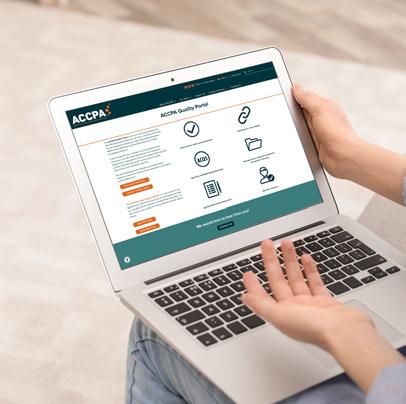
ACCPA Quality Portal contains assessments, guidelines, templates and resources to assist manage your compliance obligations. It includes a simple online assessment that takes you through all the Actions of the strengthened Standards. This will enable you to quickly become familiar with the requirements as well as identify what you’re doing well and where you may have some gaps.
Contact quality@accpa.asn.au for more information or a free trial.
Get in touch today!
1300 222 721
quality@accpa.asn.au
consultancy@accpa.asn.au
accpa.asn.au/consultancy
accpa.asn.au/quality-compliance/
Quality Standards?

The top five trends for aged care facility managers in 2024
Elevate your operations
If you’re looking to optimise the maintenance of your aged care facility, the experts at MDFM have identified five key trends set to improve the industry in 2024 and beyond.
How many of these is your facility using already, and what do you need to do differently this year?
1. The digitisation of aged care maintenance
Since the 2022 Retirement Village Industry Reforms, most (if not all) retirement villages in New South Wales have now captured the data for all their assets and created an Asset Management Plan (AMP).
For facilities really wanting to level up their efficiencies and safety, the next step is to automate the process of when and how all these assets are maintained, checked, serviced and managed.
By automating maintenance via a Computerised Maintenance Management System (CMMS), facility managers can check where their assets are in their life cycle, plan for audits, and pre-allocate repair budgets in a scheduled manner –all in the click of a button.
There are a few Australian companies that provide end-to-end asset maintenance and CMMS services, so you don’t have to organise an aged care CMMS on your own.
Don’t get left behind in 2024, investigate how to digitise your asset register and maintenance plan to save time and money.
2. Transparency between residents and management
In recent years, retirement living villages have improved their transparency with government and shareholders. Next, we will see this transparency extend to residents.
Some organisations are ahead of the curve and already involve their residents in important decisions –because they know that transparent communication is crucial for maintaining a positive retirement living environment.
A key place to start, is to include residents in maintenance planning and other issues related to their living environment. This can be easily done with an issue reporting app.
Using an app allows for a transparent flow of information between residents and management, ensuring that everyone is on the same page regarding maintenance activities. Facility managers can then address issues promptly, ensuring the safety and comfort of residents.
3. Outsourcing facility maintenance
Recently, many large operators have been saving on overheads and reducing human resources obligations by seeking an outsourced maintenance management solution.
One facility manager alone can’t stay on top of contracts, repairs, on-site issues and reporting to management, which is when outsourcing aged care maintenance can really pay off.
Outsourcing maintenance often improves efficiency, and creates accountability outside the aged care team – reducing the stress and workload felt by managers and board members.
Look for a company with a specialisation in aged care (so they understand 24-7 operations and frail residents), and one with experts in contract management as well as hands-on maintenance at all levels.
4. Re-letting service contracts
Just like a Spring clean out of your wardrobe, is it time you reassessed who you are paying to maintain your aged
care assets and exactly how much they are costing your organisation?
Contracts can often lapse, or renew with an automatic price increase – neither of which is a good outcome.
Do you need to renegotiate your maintenance contracts (for example heating, ventilation and air conditioning, fire safety or refrigeration) or at least get them in one digital place with automatic reminders?
That’s where an aged care management company can save the day, doing all the sorting and digitising of contracts for you.
Then all you need to do is make the final decision on who to go with and when you want alerts for each asset. Any process that saves aged care facilities money will never go out of style.
5. Improve your existing AMP
An AMP is not set-and-forget, and it’s never too late to make changes to your current plan. Many aged care providers who previously created an AMP to meet compliance admit that it could be better.
If it’s a few years old now or was created in a rush, chances are it could be improved and cost savings identified, so consider engaging an expert to review it.
There are companies who specialise in updating and optimising AMPs for retirement living villages and aged care homes.
MDFM is an Australian-owned aged care facility and management specialist, in the business for more than 40 years, and we would be only too happy to help you elevate your operations, with expert advice and tailor-made products for the aged services industry.
Jess Johnson, Client Services Director, MDFM www.MDFM.com.au
91

Why should I choose your agency?
The 3Cs art of positioning
In almost all areas of life, we’re spoilt for choice. From where we live, eat, shop, travel and buy furniture and accessories, there is no shortage of options. Such is the luxury of living in Australia today.
But sometimes, choice can be debilitating. We’re more time poor, we’re busier and our capacity to process choices has diminished.
As an aged care provider, your role is to make it easy for customers to choose you – but how?
There’s a simple three-step framework that you can use to help position your agency as the right choice in the mind of your customers – known as the 3 Cs of strategic marketing.
The first C – ‘Company’
What does your company actually deliver? What is it about your company that is important?
Make sure your messaging and advertising clearly articulate what you do better or differently to the competition and do this consistently, across all platforms, in order to establish your market position and build your ‘brand’.
When defining your position, make sure it’s something you can deliver, to build and maintain trust with your customers.
The second C – ‘Customer’
This sounds obvious but when you’re positioning your agency, it should align to what the customer wants.
This is where market research becomes very important, whether secondary research (research that has already been done by someone else) or primary research (research you undertake), it’s critical that you understand the attributes of a provider that are important to a customer when they are reviewing their options.
Is it safety, staff, cost, service inclusions, reputation, locality or something else? While all of these play a role, which ones really influence the customer’s decision the most?
It’s important to note that you can’t ‘own’ an attribute – for example, safety – but you can position your organisation strongly on that attribute relative to the competition.
So, in your marketing materials, emails, staff or any other customer-facing touchpoint, make sure you’re reinforcing the attribute (or attributes) that are most important to your customers.
The
third C – ‘Competition’
What does your organisation do that is better than the competition? This may come down to perception more than fact but being ‘known’ for something relative to the competition will help you stand out in a crowded market.
Aged care services is generally what all aged care providers offer, but each service has different nuances. Do you appeal to a particular culture or faith group? Are there services that you provide that are unique or different to what is available in your local area? Do you offer intergenerational programs?
Going back to the second C – Customer – what is an attribute that is important to them, that you can own more than the competition. Again, it may not be provable, but it’s something you can hang your hat on and your customers will know you for.
Ultimately, positioning your organisation in a competitive and growing market is critical to standing out and being chosen, growing your client base and increasing revenue and profit.
Use the 3 Cs to create your positioning statement by focusing on this question: “What attributes that are important to the customer, can we deliver as a company, better or more effectively, relative to the competition?”
Once you have clarified your positioning statement, take some time to review all your marketing collateral to ensure that they’re all clearly communicating your position.
You’d be surprised just how many websites and brochures look the same and say the same thing – no wonder customers have a hard time choosing!
If you’d like to discuss positioning or any other marketing topics, feel free to reach out to us.
Matt Dillon, Director, BOSS Projects www.bossprojects.com.au
GOVERNANCE & FINANCE 92

How to maximise supplier cost savings
Your three-step plan
For organisations looking to reduce costs, focusing attention on external suppliers is the logical place to start, with suppliers making up as much as 60 per cent of total costs.
However, many organisations make the mistake of jumping straight into a procurement project without necessarily considering the most fertile areas to prioritise and how best to obtain potential savings, let alone how to ensure any savings delivered stick over the long term.
At the risk of tempering organisation excitement, developing a clear plan, delivering systematically on that plan and closing the loop through post implementation optimisation activities leads to the deepest savings outcomes and optimal use of resources.
Step one: Conduct a supplier savings analysis
The initial stage involves conducting a supplier savings analysis through a deep dive analysis into your supplier cost base.
A supplier savings analysis contains four key, interrelated activities to identify savings opportunities across an organisation’s supplier spend:
■ conduct a spend analysis to visualise and categorise current spend
■ conduct a price analysis of targeted key suppliers
■ conduct a sourcing analysis of major spend categories
■ review opportunities to improve how products and services are utilised through improved purchase, storage and use.
Through these activities, savings opportunities can be identified and quantified to form the basis of the savings plan.
To formalise each savings opportunity requires details that allow each opportunity to be quantified, with the best plans also including a qualitative assessment to allow for more granular comparison.
Prioritise each project based on your most important outcomes, typically the level of savings, risk or implementation time.
Once formalised, the plan should be seen as a savings roadmap that organisations can refer back to for several years and used to guide allocation of resources, projected savings and project timing.
Step two: Undertake procurement projects
The second stage to maximise supplier cost savings is procurement project delivery, either through a tender (RFx) or supplier negotiation.
The RFx process typically takes three to six months per project and is a formal process inclusive of specifications, tender documents and supplier evaluation process.
Direct negotiations are an alternative option to provide quick wins, with less formality, documentation and timeframes.
Keep in mind that there is a trade-off between timeframes and cost savings, with direct negotiations typically delivering lower levels of savings due to the lack of competitive tension.
Step three: Implement contracts and identify further savings
The final stage is post-contract implementation to validate projected savings and identify opportunities for further savings and performance improvement.
There are numerous areas in which leakage can occur, leading to projected savings not being achieved or performance expectations not being met.
Examples include preferred suppliers not used consistently, agreed rates not applied correctly, rebates not obtained, and rate changes against contract terms.
Conducting a savings audit will ensure the projected savings have truly hit the profit & loss statement and identify further improvement opportunities.
Conversely, developing a strategic sourcing solution with preferred suppliers creates significant opportunities for further cost savings and performance improvement through cost optimisation activity.
These opportunities become available and are facilitated through consolidated spend files and group account management of your preferred suppliers.
Examples of additional savings opportunities include consolidation of products and services, specification standardisation, supply chain simplification, and elimination of unnecessary products and services.
Generating supplier cost savings is a strategic activity which benefits from a formalised structure and plan.
It’s vital to take the time to analyse available opportunities, have a clear methodology for delivering identified savings and continue to work with preferred suppliers after a sourcing strategy has been implemented.
This ensures savings are maximised, resources are optimised and projects are delivered effectively.
Justin Sulley, Owner & Founder, Spend Solutions www.spend-solutions.com.au
93
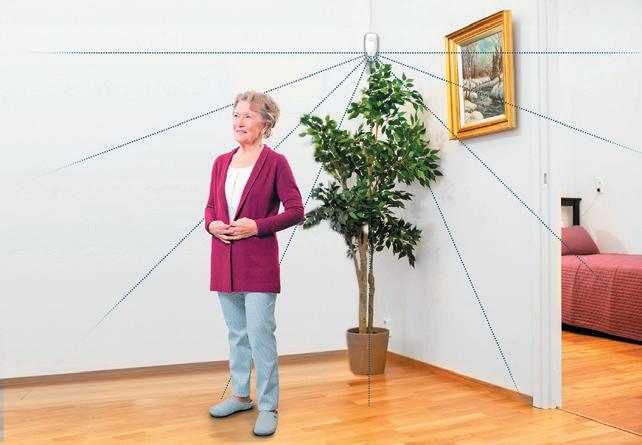
INTRODUCING Elma™ Smart Detection
Enhancing Resident Care in Aged Care Facilities with the Latest Fall Detection and Management Solution

Innovative Sensor Technology: Non-invasive sensor for fall prevention and detection, significantly reducing mortality associated with falls.

Analysis and Reporting:
Conduct thorough movement, bed behaviour, and motion detection analysis to streamline resident care plans and maximise staff efficiencies.

User-friendly Interface: Interface seamlessly with any quality nurse call system and receive real-time alerts for proactive care.


Crafted with precision, the Elma™ Smart Detection sensor is designed to elevate the safety and well-being of your residents. Strategically positioned in the upper corner of each room, it provides unparalleled peace of mind.
Elma™ offers a comprehensive solution to fall detection, prevention, and management, along with monitoring bed behaviour, motion detection, and more. It’s a non-invasive, all-in-one system delivering real-time insights.
Gain optimal visibility across expansive areas, including hallways, dining spaces, entry/exit points, and wet areas, ensuring every corner is monitored effectively, all without the use of cameras.
Installing Elma™ Smart Detection is effortless, thanks to its ‘plug and play’ functionality. Whether in existing buildings or new constructions, enjoy a hassle-free setup process, empowering your facility with advanced monitoring capabilities.

For more information, contact us on 1300 931 893 or visit at www.hlshealthcare.com.au

Technology and data for enhanced organisational governance
Six steps to success
In the ever-evolving aged care landscape and with the new Age Care Act and strengthened Quality Aged Care Standards due to commence in July 2024, the adoption and integration of technology together with the strategic use of data have become pivotal in steering organisations towards success and sustainability.
What providers need to know is that governance – the cornerstone of any thriving organisation – can be significantly enhanced by technology.
In fact, the adoption of technology and effective data utilisation are now instrumental in promoting good organisational governance in aged care.
1. Transparency and accountability
One of the fundamental aspects of good governance is transparency. Advanced data management systems and predicative data can enable organisations to record, store and analyse vast amounts of data with precision.
This data can inform operational processes, compliance and reporting, and support financial viability. By using technology and data, organisations can provide accurate and timely information to all stakeholders, enhancing transparency and accountability.
2. Improved decision-making
Data-driven decision-making is another critical aspect of good governance. Technologies, analytics and AI algorithms can provide insights that were previously paper-based, unreliable and often unattainable.
These insights empower aged care leaders to make informed decisions that are based on factual data rather than intuition or speculation, leading to more strategic and effective clinical governance.
3. Risk management and incident management
Identifying and managing risks is essential for good clinical governance. Using technology can enable organisations to foresee potential risks by analysing consumer patterns and trends from historical data.
This can be a light bulb moment and will help in proactively identifying threats, and implementing preventive measures in a timely manner.
4. Regulatory compliance
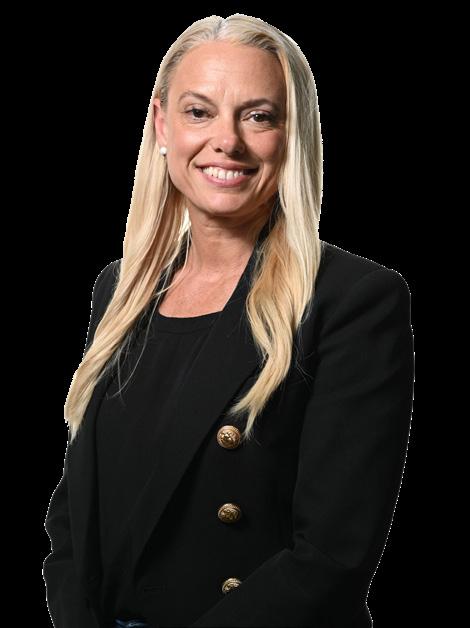
Staying compliant can be challenging in the aged services industry. Technology plays a crucial role in compliance by automating reporting processes and keeping track of consumer changes or deterioration.
Commission visits, self-assessments, Quality Indicator reporting, SIRS and incident management, and financial reporting – all part of the compliance landscape – are made easier with having information and data at your fingertips.
5. Enhanced communication
Good governance is also about effective communication.
Technology-enabled organisations can better facilitate communication with internal and external stakeholders, through the ability to disseminate information quickly and efficiently, ensuring that all parties are wellinformed and engaged.
This extends to the Clinical Governance Committee, Quality Care
Advisory Body and Consumers Advisory Body.
6. Efficiency and cost-effectiveness
Adopting technology can streamline operations, reducing manual labour and the potential for human error.
Automated processes are not only more efficient but also cost-effective in the long run. This operational efficiency ensures that resources are utilised optimally, a key aspect of good governance.
The adoption of technology and the strategic use of data are no longer just options but necessities for good organisational governance.
In an age where data is the new currency and technology the conduit, organisations that embrace these tools are poised to achieve not only compliance and efficiency but also a competitive edge.
As we look to the future, the integration of technology and data will continue
95 INNOVATION & TECHNOLOGY
HLS Healthcare CEO Melissa Stehr says the adoption of technology is now a must for good governance.
Join ACCPA - Australia’s national association for aged care.

to play a pivotal role in shaping effective, transparent, and accountable governance structures in aged care.
We have seen a significant and tangible shift across the sector, especially for those who’ve embraced and started incorporating new technology into their workplace.
The return on investment has proven highly favourable, not just from a business standpoint but notably from a human angle.
The response from employees, highlighting the improved efficiencies resulting from the integration of new technology, indicates a positive contribution to the organisation’s culture. While they feel supported, there’s a strong sense that their employer is genuinely invested in their wellbeing, as well as those in their care.
For more information on how HLS Healthcare can support your organisation’s governance and create a technology roadmap that makes operations seamless, saves you time, money and resources, and most importantly supports a model of care where consumers always come first, please reach out.
Melissa Stehr, Chief Executive Officer, HLS Healthcare www.hlshealthcare.com.au


96 INNOVATION & TECHNOLOGY
The Aged & Community Care Providers Association (ACCPA) is the national association for providers of residential aged care, home and community care, retirement living and related services. 1300 222 721 members@accpa.asn.au www.accpa.asn.au The Incontinence Management Micro-Credentialing Program e-Learning starts March 2024 (QLD only) 1300 222 721 elearning@accpa.asn. au
Tech priorities in 2024
Why it’s time to invest in the digital employee experience
For years there’s been a growing gap between the technology afforded to office-based workers and the technology afforded to their frontline (or ‘deskless’) peers.
Despite there being almost 2.7 billion deskless workers globally – more than double the number of officebased workers – Emergence Capital’s report The State of Technology for the Deskless Workforce (2020) shows that just one per cent of software venture funding goes towards technology serving deskless workers.
In a tight labour market, technology matters. According to the same report, 78 per cent of surveyed deskless workers said that technology is an important factor in choosing a job. For that reason alone, in 2024 more organisations will invest in the digital employee experience (DEX) for their frontline workforce.
While the employee experience (EX) encompasses all the touchpoints workers have with their organisation, from the work environment to the benefits on offer, the DEX covers what it’s like to use the company’s digital platforms and tools.
For aged care workers, that encompasses the tools used to log their time and attendance, their leave management system, and their rostering and scheduling system – to name just three. It’s about the user experience of the various systems in place and how seamlessly those systems are integrated.
Five elements
There are five key elements that contribute to a strong DEX. The technology needs to be:
■ Collaborative. It needs to be interactive and embedded into the tools employees are already using, so they can interact ‘in the moment’ and more efficiently access the information required to do their jobs.
■ Flexible. Aged care workers may be undertaking at work multiple locations, at different times. They may not have access to laptops. However, they do invariably have access to a mobile phone. That means they can access what they need from anywhere at any time, including checking work rosters, applying for leave and communicating with their team and manager. Selfservice functionality is essential, so that employees can easily update their own personal details and work preferences on-the-go.
■ Seamless. Employees want singlesign-on access to an integrated human capital management (HCM) solution like Humanforce, which can draw data from multiple departments without impacting the user experience. Such solutions may include onboarding, payroll, time and attendance, scheduling and rostering, benefits management, and more.
■ Intuitive. Work tech shouldn’t require a lengthy instruction manual. Intuitive solutions that rely on machine learning and artificial intelligence to constantly improve based on previous interactions with users is something that all technology providers, including Humanforce, are working on.
■ Personalised. It should take into account past history and current circumstances (i.e. current role) and potentially make recommendations for the future. This is similar to consumer retail and entertainment platforms like Amazon or Netflix. In the workplace, for example, a learning pathway can be created that considers the learner’s past and configures the way forward accordingly, perhaps even making suggested content recommendations that are most relevant to them.
First steps
The first step for HR and business leaders is to design digital-first experiences to support the ‘moments that matter’ for their deskless workforce.

It’s the pain points that take up time or frustrate workers – for example, having to use a desktop computer or laptop to apply for leave, or having to manually enter start and end times for shifts.
Once these moments are identified, HR can design a well-considered employee journey that delivers a unified, digitalfirst employee experience.
Investing in the DEX isn’t enough. It’s also important to provide training so that these tools will be used.
Microsoft’s Work Trend Index Report (2022) shows that the healthcare industry is among the worst in terms of offering training to employees prior to implementing technology.
Indeed, the same report indicated that 55 per cent of deskless workers said they’ve had to adapt to using digital tools on the fly, with no formal training.
For deskless workers, training might entail using a mix of webinars, live demonstrations, on-the-job practical training and eLearning – perhaps delivered in small chunks as microlearning via mobile devices.
Whatever you choose, investing in the DEX and supporting it with the right training, will be essential to boost your appeal in the ongoing war for talent.
Humanforce www.humanforce.com
97 INNOVATION & TECHNOLOGY

Unlocking organisational agility with the 7 Cs
Because the right software is a must
Agile organisations are those that take a creative, collaborative and people-centred approach towards achieving an organisation’s vision and mission.
In dynamic markets, such as the Australian aged care sector, agility is crucial for organisations that aspire to deliver the highest quality care to their community.
In 2024 and beyond, true agility requires the right aged care software, but how do you know what is right for you?
The answer lies in a considered assessment across key evaluation criteria specific to your organisation.
To help you develop your evaluation criteria, here are seven categories (7 Cs) that Australian aged care organisations should assess their software solutions against:
■ Client-centred
■ Compliant
■ Customised
■ Connected
■ Collaborative
■ Contextualised
■ Cyber-security
We unpack each category in Epicor’s latest eBook, The 2024 Guide to Agile Aged Care, but here’s an overview to get you started.
Client-centred
Despite the legislative requirements for adopting client-centric practices, in a competitive market, if clients don’t receive a quality of care that meets their expectations, they will likely transition to a provider that will.
Therefore, your client’s experience should be at the centre of everything your organisation does, which means
your software needs to be developed with a view to the entire care recipient journey.
Compliant
Maintaining compliance with a broad suite of obligations will put your organisation under pressure unless you receive support.
For the most part, software can facilitate this support, particularly when your vendor commits that their software will stay current with changes to the Australian legislative environment and meet the industry’s extensive governance requirements.
Customised
Dealing with a software vendor that doesn’t have a working understanding of the Australian aged care market is problematic.
Therefore, your software evaluation should also include assessing whether the vendor provides customer support and product development from a team of knowledgeable staff who deeply understand the gravity of your challenges and can provide prompt and truly helpful assistance.
Connected
Change occurs too rapidly in the aged services industry for organisations to operate with disconnected solutions.
Today, best-in-class aged care software applications can provide your business with a fully functioning, scalable, and end-to-end enterprise resource planning (ERP) software solution.
Such software should provide all the required functionality to manage your aged care organisation’s marketing, administration, client, procurement, document management and financial aspects.
Collaborative
The aged care organisations that achieve true agility will be those that align their team towards a future consistent with the organisation’s mission and culture, for a better tomorrow for all their stakeholders.
In such an approach, organisations look to free their team up to focus on delivering the highest possible standard of care for their clients by leveraging technology.
Contextualised
In business intelligence terms, context is crucial. Aged care providers need a 360-degree view of client profiles where all information lives in a truly integrated system, providing a single source of truth.
Moreover, as the market adapts to the transition from the Aged Care Approvals Round (ACAR), organisations won’t have the luxury of time to analyse large quantities of raw data.
Cyber-security
The financial cost of a cyber-attack for healthcare organisations is more than double the global industry average, highlighting the need for providers to take proactive measures to protect all stakeholders who would otherwise be affected by attacks on their data.
To adopt best-in-class security, aged care organisations need services including complex encryption, single sign-on (SSO), intrusion detection and redundancy.
If unlocking organisational agility through software is important to your organisation, our eBook will provide valuable insights to guide your decisionmaking. Download our eBook for free today.
Epicor www.epicor.com
98
INNOVATION & TECHNOLOGY

The digital revolution aged care has been waiting for
Digitalised clinical pathways are the next step to improving aged care services
In the rapidly evolving landscape of aged care, the need for innovative solutions has never been more pressing.
While residential and home care providers grapple with the intricate needs of our older population, it has become increasingly clear that embracing technology is not just an option but a necessity to deliver efficient, personalised care.
Embracing digital technologies enables providers to streamline tasks, improve communication among care teams, and automate time-consuming activities.
This shift empowers healthcare professionals to concentrate on proactive and personalised care strategies, leveraging real-time data for prompt interventions.
The digitalisation of clinical workflows is crucial in meeting the evolving demands of aged care, so that each care recipient receives timely and tailored support.
AI-Summarised Progress Notes
Communication lies at the heart of effective care provision, however, traditional free-text progress notes, while rich in insights, often pose challenges in extracting pertinent information promptly.
Here, an opportunity for digital innovation emerges – an AI-Summarised Progress Notes system that translates the intricacies of free text into actionable insights.
This not only expedites communication among healthcare teams and family members but also facilitates prompt decision-making.
Pressure injury prevention technologies
Another significant advancement is the integration of pressure injury prevention technologies.
The labour-intensive nature of manual pressure injury prevention has long been a concern for care providers.
In manual workflows, caregivers face challenges in coordinating repositioning activities and managing real-time data effectively.
Through digitalisation, Pressure Injury Sensors can automate these processes, ensuring timely repositioning and consolidating real-time data into accessible formats.
This shift from manual to automated not only minimises the risk of pressure injuries but also optimises the allocation of healthcare resources, allowing professionals to focus on preventive measures and personalised care.
Dementia and Alzheimer’s care
Dementia and Alzheimer’s care demand a compassionate touch combined with technological advancements, such as Wandering Sensors – a solution designed to automate tracking, providing real-time data and immediate alerts when care recipients deviate from safe zones.
By relieving caregivers of the burden of manual tracking, this technology enhances care recipient safety and reduces stress for both caregivers and care recipients.
By seamlessly integrating technology into dementia management, aged care providers can create environments that prioritise personalised care and support for those navigating the complexities of these conditions.
Gastrointestinal Health Management
The integration of Bowel Movement Sensors into digital clinical pathways offers a novel approach to gastrointestinal health management.
Traditionally, manual monitoring often led to fragmented data and delayed interventions.
Bowel Movement Sensors, when seamlessly integrated into your healthcare platform, provide realtime monitoring and automated data collection, ensuring continuous tracking of stool consistency and frequency.
Providers can benefit from a more proactive approach to gastrointestinal health that empowers timely interventions without disrupting the rhythm of established care practices.
Choosing the right healthcare software
In navigating this new era, choosing good healthcare software proves crucial in empowering your healthcare team and setting a new standard of excellence.
Skillfully integrating multiple systems, including hardware, with industryleading clinical pathways, the Humanetix ACE platform emerges as a top choice for providers seeking a smart and innovative healthcare system.
Whether choosing from our over 400 pre-defined best practices or tailoring them to your organisation’s unique needs, our dedication remains steadfast—ensuring exceptional outcomes for both your staff and care recipients.
By embracing the digitalisation of clinical pathways, not only will you meet the evolving demands of aged care, but surpass them.
Mitchell McBeath, Chief Customer Officer, Humanetix
www.humanetix.com.au
99
INNOVATION & TECHNOLOGY

The secret to effective hiring
It’s not just about the CV
There’s much more to hiring the right aged care staff than just skimming resumes, it’s critical that you find great people with both the right skills and the right temperament for the job.
Amid the current aged care skills shortage, it’s tempting to snap up anyone who seems qualified. The problem is that placing too much faith in CVs means you often fail to gain a true picture of the candidate.
For starters, 78 per cent of job seekers lie on CVs, according to reference-check firm Checkster. As you’d expect, the most common lie is claiming proficiency in skills they don’t really have.
Perhaps even worse, CVs can fail to highlight critical soft skills such as temperament, attitudes and communication skills. These are invaluable when it comes to working with people, particularly in aged care, says Graeme Croft, founder and director of aged care provider Signature Care.
Signature Care operates 14 aged care facilities employing more than 1400 staff across the country. Despite an acute labour shortage in the aged-care sector, Graeme says he simply can’t afford to make hiring mistakes.
“If you hire someone seemingly with the right qualifications, only to discover they’re a bad fit, it can have significant flowon effects across the business,” he says.
“You need to go through the arduous process of counselling and multiple warnings before dismissing someone, otherwise you can end up in industrial strife, which takes up a lot of time and is not fair on the employee or the business – so it’s best to get it right first time.”
The disruption created by keeping the wrong person in the job can have a significant wider impact on workplace culture, team dynamics and productivity.
The key to hiring the right people is placing less importance on CVs and focusing more on the right set of screening questions, letting you quickly establish whether a candidate is well-suited to the role.
Targeted screening questions quickly highlight which applicants are truly worth a closer look, says Croft.
“Rather than just firing off a copy of their CV, it forces applicants to really think about their answers and their suitability for the role,” says Graeme.
Taking advantage of screening questions can also significantly speed up the hiring process – potentially reducing it
from months to days. This can give employers a powerful advantage when demand for talent is fierce, says Carolyne Burns, co-founder and managing director of Australian predictive hiring software provider Expr3ss!
Whether there’s a flood of applicants or a drought, focusing too much on CVs can lead to poor hiring choices, says Carolyne.
“Remember, when you’re skimming through a CV you’re not seeing the real person, it’s more like an advertisement for that person,” she says. “Hiring people in aged care with the right temperament is critical, but a CV isn’t going to reveal whether someone is short-tempered and ill-suited to the job.”
“You can’t afford to fall for false advertising and make a hiring mistake, so you need to see past a CV and get real insight into that person.”
Using short surveys, Expr3ss! quickly and cost-effectively identifies applicants with the right skills, attitudes, temperament and cultural fit for the job. Employers can tailor surveys and include deal-breaker questions to ensure applicants unambiguously address the requirements of the role.
Along with reducing the time wasted on inappropriate candidates, the benefits of this approach include improved staff retention, raised productivity, enhanced employee engagement and increased employee satisfaction.
Expr3ss! doesn’t hand hiring decisions over to algorithms, Carolyne says, and people still make the final decision as to who gets the job.
“Even with the best of intentions, hirers can be influenced by unconscious bias which sees the wrong people favoured and great candidates cast aside because they seemingly don’t fit the mould,” she says.
“Rather than choosing who gets the job, technology can help you be more objective when deciding who makes it through to the interview stage, to ensure you’re really choosing from the best people who are the right fit.”
Expr3ss! is the leader in predictive hiring, which is at the heart of what makes the Expr3ss! platform unique.
From applicant attraction and screening to shortlisting to onboarding and board reporting, the Expr3ss! platform streamlines it all – so you can hire quality applicants who suit your roles, with the right personality traits, who suit your role, your team and your culture.
Expr3ss! Predictive Hiring Technology www.expr3ss.com
100
INNOVATION & TECHNOLOGY
SilVR Adventures transforming aged care
From sceptic to super user
In a conversation with Wellbeing Coordinator
Clare Lockhart and Residential Manager Cardinia Suzannah Stewart from Signature Care in Victoria, an Australian family-owned aged care business committed to a person-centred approach, we explored the transformative impact of SilVR Adventures’ virtual reality (VR) technology in their residence over the past three months.
Clare, a Gerontology Master’s degree holder, initially had doubts about VR’s effectiveness for individuals with moderate to severe dementia due to the invasive appearance of the headsets.
However, witnessing positive outcomes from residents and staff altered her perspective.
SilVR Adventures’ VR not only reduced feelings of isolation but also sparked meaningful connections.
One resident, previously non-verbal, became chatty and animated after a VR session, even recalling places from his past experiences.
Signature Care has gone beyond conventional VR implementation, creating immersive virtual communities with added sensory elements such as sounds and smells.
During VR trips, residents reported feeling sand under their feet, showcasing the technology’s ability to engage multiple senses.
One of the most amazing stories highlighting the immersive power of VR, was about a man called Joe who was so moved on his travels back to a cathedral in Italy that he brought the room to tears with his beautiful singing of a classical song.
Clare and Suzannah emphasised the emotional impact of residents engaging in meaningful conversations after VR experiences.
“Watching the residents engage in VR is special, because they are so immersed in the experience, they’re talking about what they’re seeing and then afterwards, when the headsets come off, they have full conversations, they’re so animated about what they’ve seen together,” said Suzannah.
“For people who have not had a cognisant conversation for a while, to have a meaningful conversation, that makes sense to them with others, to be understood, it is quite emotional.”
VR’s influence extends beyond emotional connections; during a ‘trip’ to Uluru, residents with cognitive impairments demonstrated enhanced focus on details, a phenomenon not typically associated with dementia.
Clare praised SilVR Adventures’ program as a game-changer, advocating for its use in every dementia care setting.
“One of the residents was in Uluru and kept asking about a bee, buzzing in her ear. You couldn’t really see the bumblebee, but she could hear it and she was so focused on it,” said Clare.
“With dementia, we understand that things are quite simple –like seeing the world in shapes and colours – whereas details get missed. But in VR, people with dementia notice details like bees or the sand, because the experience awakens other senses.
“For them to remember and feel sand on their feet, you have that memory from the last time you were on a beach, that’s incredibly powerful.”
Described as ‘super users’ due to their extensive program utilisation, Signature Care has harnessed the technology to create individual profiles for residents, tailoring VR experiences to improve their lives.
Clare highlighted the ability to recreate experiences, even facilitating virtual date nights for couples.
“It has been phenomenal. We are super users because Suzannah and her team have recognised the strengths,” said Clare.
“They have built a profile for every member of the community, it’s easily accessible and they can tailor VR experiences to truly improve the quality of residents’ lives and reconnect them with their loved ones.
“Any staff member can access their file, see where they grew up, and take them there. We are even able to bring back date nights. For instance, when it’s an anniversary, for that VR session, we invite the partner, and they are just back to being husband and wife again.”
The benefits of VR extend to workforce morale, as staff members are now expressing a desire to work in dementia care units, a role traditionally considered challenging.
SilVR Adventures’ VR technology has demonstrated the profound impact on residents, staff and the overall culture of dementia care units at Signature Care – and SilVR Adventures is in the process of rolling out the program to all Signature Care sites nationally.
This success story underscore the potential of VR to elevate aged care experiences, fostering meaningful connections and enhancing the wellbeing of residents and caregivers alike.
SilVR Adventures is a turnkey VR solution that provides everything required for care organisations to facilitate meaningful and shared VR experiences – and we can tailor our products as required. The options are limitless.
SilVR Adventures www.silvradventures.com.au
101 INNOVATION & TECHNOLOGY
Consumer attitudes to technology
New survey aims to determine technology preferences for ageing at home

Australians are increasingly expressing a desire to age at home – what technologies are they looking for?
With the Australian population over 65 rapidly increasing, and the demand for aged care services expected to grow, could sensor technology be a key to keeping our ageing population at home longer?
This is the question we are hoping to answer through a collaborative project involving the NSW Smart Sensing Network, NSW universities, healthcare providers and local health districts.
The NSW Smart Sensing Network is a consortium of nine leading universities across NSW and the ACT. It is a not-for-profit innovation network that brings together universities, industry and government to translate world-class research into innovative smart sensing solutions that create value for NSW and beyond.
For the first time, older Australians, carers, families and healthcare professionals will be surveyed about their attitudes to the use of technology that can support their increasing preference to age at home.
The UTS Institute of Sustainable Futures is leading the project in collaboration with the NSW Smart Sensing Network and the University of Newcastle’s FASTLab.
With more than 1.3 million people using aged care services in Australian in 2019/20 and an increasing preference
for people to stay in their homes, we believe sensor technology could play a considerable role in helping older Australians to stay at home rather than go to an aged care facility.
Both wearable and non-wearable sensor technology can collect data on lifestyle and biometric data such as activity data, heart rate, blood pressure and other health readings.
This data can be collected without the use of cameras.
Once the data is collected by the sensors it can then be analysed, with the use of AI and health experts, to detect patterns that may be able to predict the onset of illness, predict and prevent falls, and provide valuable and accurate information to care providers to help them deliver care.
This information can be sent to family, carers and telehealth operators so that action can be taken to support the ageing person in their home, instead of going to a hospital or aged care facility.
The project hopes to gauge ageing consumers’ attitudes to the technology to inform the deployment of sensor and AI technology to augment in-person care.
It is hoped that this augmenting technology will help address critical staffing shortages in healthcare and social assistance for Australia’s ageing population.
Approximately 764,000 workers provide healthcare and social assistance to our ageing population and staff shortages are an industry-wide issue with Australia’s burgeoning ageing population.
There is a wealth of sensor technologies that could be used by our older Australians.
But we don’t know if consumers would use them, pay for them, or seek government assistance to pay for them.
This is the purpose of our survey.
Some reasons why people may reject technology include problems with the design of the technology, ease of use, concerns over the collection of personal information and potential for data breaches and hacking.
The project is part of a wider initiative called Healthy@Home, which is testing the idea that technology can help older people retain a positive sense of identity and independence in their own homes and significantly increase their quality of life.
By using the data collected form the project surveys, we hope to inform industry and government about how to roll out these devices so that our ageing population can stay at home longer.
Catherine Oates Smith, MedTech Theme Leader, NSW Smart Sensing Network www.nssn.org.au
102 INNOVATION & TECHNOLOGY
Excellence in joinery and custom furniture
Shaping the future of Australian aged care
In the dynamic world of aged care, the role of governance and finance is pivotal, and this is closely entwined with the living environment –what it looks like, how safe it is, how it makes people feel.
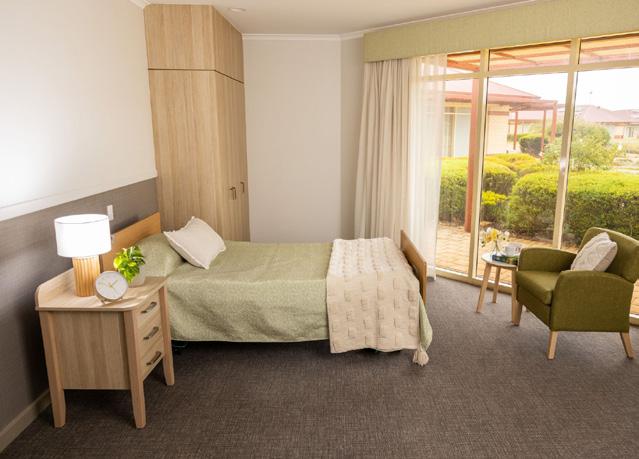
Workspace Commercial Furniture, renowned for its excellence in joinery and custom furniture design, is redefining standards in the Australian aged care sector.
A pillar of quality and safety Governance in aged care encompasses a comprehensive framework that ensures top-notch care and efficient resource management.
It is about setting and maintaining high standards in all aspects of care, including the physical environment created by furniture and fittings.
The a new era of standards
The year 2023 marked significant legislative changes in Australian aged care. These changes aimed to elevate the quality of care, increase accountability, and ensure a higher level of safety for residents.
They also emphasised the importance of appropriate and quality furnishings in aged care environments.
Custom joinery in aged care should seamlessly integrate functionality and design, combining ergonomic features with a modern aesthetic to enhance the daily experience of residents.
Today’s thoughtful design caters to comfort and practicality, setting a new standard in aged care living spaces.
Tailor-made living environments
Workspace Commercial Furniture stands out with its specialised joinery capabilities and custom furniture designs, tailored precisely for aged care facilities. This specialisation allows the company to:
■ Create custom solutions. Understanding the unique needs of each aged care facility, Workspace designs and manufactures furniture that addresses specific requirements, from resident comfort to space optimisation.
■ Ensure durability and safety. The joinery techniques used guarantee durability and safety, essential in aged care settings where furniture is used intensively and needs to meet strict health and safety standards.
■ Enhance aesthetic appeal. Custom furniture solutions also mean that each piece can contribute to a warm, welcoming and homely environment, crucial for the wellbeing of residents.
A wise investment
Aged care funding in Australia comes from multiple sources, including government subsidies, resident fees and supplementary income like donations.
By investing in cost-effective yet high-quality furniture solutions, facilities can make every dollar go further, so it’s important to take the time to properly investigate – and invest in – the right furniture solutions for your needs.
A leader in aged care innovation
The combination of legislative changes, diverse funding sources, and the unique contributions of companies like Workspace Commercial Furniture is setting a new standard in the Australian aged care sector.
As Workspace continues to push the boundaries with its custom joinery and furniture designs, it plays a crucial role in shaping environments that are not only safe and functional but also aesthetically pleasing and comforting.
This commitment to excellence in furniture design and manufacturing makes Workspace a leader in enhancing the aged care experience in Australia.
With its focus on custom joinery and furniture, Workspace is not just a furniture manufacturer but a vital part of the aged care community’s ongoing evolution.
Workspace Commercial Furniture www.workspace.com.au
103 BUILT ENVIRONMENT & DESIGN
This resident room, outfitted with custom joinery and furniture by Workspace Commercial Furniture, epitomises the harmonious blend of form and function, Estia Burton SA.
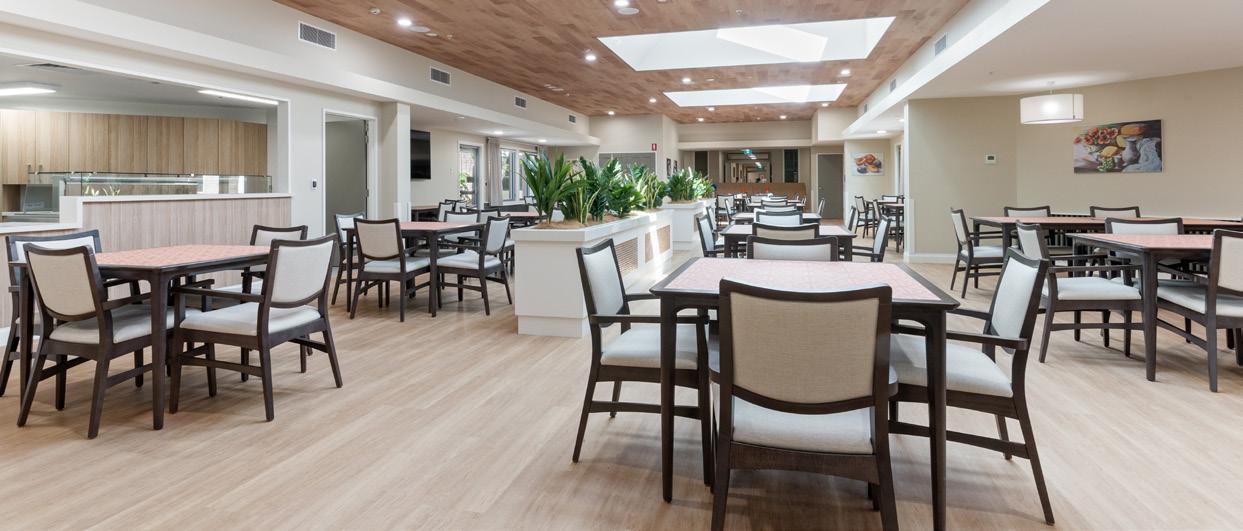
Creating exceptional living environments
Dellacourt Facility Redevelopment nears completion
Lutheran Aged Care Albury provides a range of high-quality aged care services and residential communities throughout the Albury and Wodonga region.
Established in 1960, today Lutheran Aged Care supports more than 200 people across three residential facilities and provides in-home care for over 280 people through private and packaged support services.
In 2019, Lutheran Aged Care engaged Census Advisory, a specialist property and advisory firm, to act as Development and Project Manager, and to lead the planning, design, procurement and redevelopment of the Dellacourt Campus in Albury, New South Wales.
As leaders in regional aged care, Lutheran Aged Care’s vision for the Dellacourt Campus redevelopment was to create an exceptional living environment that aligns with their values of ensuring dignity, respect, service and choice to its existing and future residents.
Consolidation of the back-of-house and other operations to improve business efficiencies alongside the working environment for staff was also fundamental to their vision and their facility redevelopment objectives.
Due to the nature of the project, with Dellacourt Campus being an operational facility housing 122 residents, careful planning and design was imperative to the successful delivery of the project.
Notably, a key objective of Lutheran Aged Care was to ensure that there would be minimal loss of beds throughout the duration of the project.
Accordingly, the design team at Census Advisory alongside leading aged care architectural practice Calder Flower Architects, Construction Services and Infrastructure (CSI), Northrop, Core Engineering and Blackett Maguire & Goldsmith, prepared and established the design, construction staging plans and development application, which was subsequently approved by authorities.
The scheme included construction and integration of 40 new resident rooms to the Dellacourt and Alkira wings, in addition to a new front-of-house including a community hub and facilities such as a chapel and multi-purpose hall, allied health space, visitor and respite short-stay accommodation, café, hair salon, chaplain, activities and library area, and administration functional space.
Census Advisory managed the detailed design, obtaining the Construction Certificates, and brokered an eight-stage, threeyear construction contract between Lutheran Aged Care and tier-one contractor Hansen Yuncken, and have since been acting as Lutheran Aged Care’s client representative, and contract administrator.
From the outset, the project has been unique, due to the process of delivering a customer-designed product, the involvement of diverse stakeholders and the timeframe for construction (three years being atypical).
Fast forward to today, the Hansen Yuncken team is nearing completion of the complex refurbishment within the existing Dellacourt Campus, with the facility and its stakeholders now benefitting from the consolidation of the back-of-house, including a new commercial kitchen and laundry, as well as a new state-of-the-art dining room, serveries, several new and refurbished resident rooms, living spaces and other indoor and outdoor amenities.
While Hansen Yuncken have successfully delivered multiple stages of works, with the final two construction stages now underway, the last one to two years have been challenging, with management of stringent infection control – particularly in the context of the project construction zones and aged care facility interface (namely due to the COVID-19 pandemic) being paramount to the safety of the Dellacourt Campus’ residents, staff and visitors, as well as Hansen Yuncken’s team and subcontractors.
Despite the pandemic, as well as nationwide construction industry challenges including supply chain issues and inflation, and aged care nationwide industry challenges including labour scarcity, Lutheran Aged Care, Hansen Yuncken and Census Advisory have upheld a collaborative partnership approach to service delivery and have identified and implemented opportunities along the way to adjust the complex staging of works, in turn reducing the construction program.
The success of the project is a result of the unwavering commitment from the teams at Lutheran Aged Care, Census Advisory and Hansen Yuncken. The project is due for completion in early 2025, and the project is on target to bring Lutheran Aged Care’s vision to create exceptional living environments, into a reality.
Sophie Milward, Development Manager, Census Advisory
www.censusadvisory.com.au; www.calderflower.com.au
104
BUILT ENVIRONMENT & DESIGN
The science of dementiafriendly design
Key principles at the core of resident
wellbeing

A dementia village is a customised living environment for individuals with dementia who require residential care.
Foremost among them is De Hogeweyk, established by visionaries Yvonne van Amerongen and Jannette Spiering in The Netherlands. The genesis of this concept dates to 1992, and since then it has been expanded worldwide.
Substantial research into the impacts of De Hogeweyk have resulted in a greater understanding of the factors that have contributed to its success – including architectural considerations for residential environments catering to individuals with dementia, whether in dedicated dementia villages or within aged care homes.
Prosthetic environment
In seniors living settings a ‘prosthetic environment’ refers to the array of amenities and physical surroundings designed to assist residents and their carers to compensate for the loss of cognitive abilities associated with dementia. The building design may contain sensory and distinctive lifestyle features familiar to individuals coping with dementia.
A prosthetic environment is represented by the 1998 film, The Truman Show. The story depicts the protagonist, Truman Burbank, growing up and living in a picturesque neighbourhood with idyllic residents, yet he was unaware that his entire environment was an elaborate television film set.
The amenities incorporated into a dementia village or within a residential aged care facility may include retail, entertainment, hospitality and simulated workspaces.
At Australian Unity’s recently opened Walmsley Residential Aged Care Facility in Kilsyth, Melbourne, Foreground Architecture created a simulated train carriage within the memory support (dementia wing) of the facility. The shared space included seating and integrated LED screens built into walls to emulate a train carriage. A variety of rolling landscapes are played on a video loop to simulate the view out from a train carriage (see image at top of page).
While to some this may seem insensitive, such an environment can offer immense support for the physical and mental wellbeing of residents living with dementia.
Cognitive mapping
Cognitive mapping involves the mental process of creating internal representations of physical spaces, aiding navigation and understanding of environments, which is particularly significant for individuals with dementia.
The design of an aged care residence can adeptly respond to cognitive mapping through deliberate design interventions thus allowing residents to form coherent mental maps of their surroundings.
Visual cues inform this mapping, such as a retail strip differing from a residential street; wider roads suggesting main streets in contrast to narrower side streets; spacious lobbies in contrast to intimate corridors; hierarchy of signage; lighting; and much more.
When appropriately incorporated into aged care residences, such visual cues are known to reduce anxiety and significantly assist with way finding among residents living with dementia.
Salutogenesis
Initially explored by medical sociologist Aaron Antonovsky, originating from his study of Holocaust survivors and prisoners of war probing their remarkable capacities for survival and health preservation, ‘salutogenesis’ applies to dementia design by introducing a sense of purpose.
By sensibly tailoring the built environment, one can amplify the salutogenic influence. Introducing spaces for ‘meaningful’ activities – the simplest of which may accommodate video gaming or tinkering – regardless of its outcome.
In more elaborate settings, these may include limited interaction or integration with surrounding communities.
This sense of purpose has demonstrated an increase in life expectancy among residents with dementia.
Surveillance
Achieving a delicate balance between safeguarding personal safety and preserving autonomy is another important consideration.
Designing for passive surveillance is key. Through considered spatial layout that orchestrates optimal, unobtrusive visual connectivity between caregivers and residents, the reliance on intrusive electronic monitoring can be curtailed thus supporting dignity and privacy while ensuring attentive care.
Design of facilities to prioritise dignity, wellbeing and autonomy for those navigating the complex landscape of dementia should be considered fundamental to every future residential aged care home.
Riordan Gough, Director, and Patrick Ong, Principal - Seniors Living, Foreground Architecture www.foregroundarchitecture.com.au
105
BUILT ENVIRONMENT & DESIGN


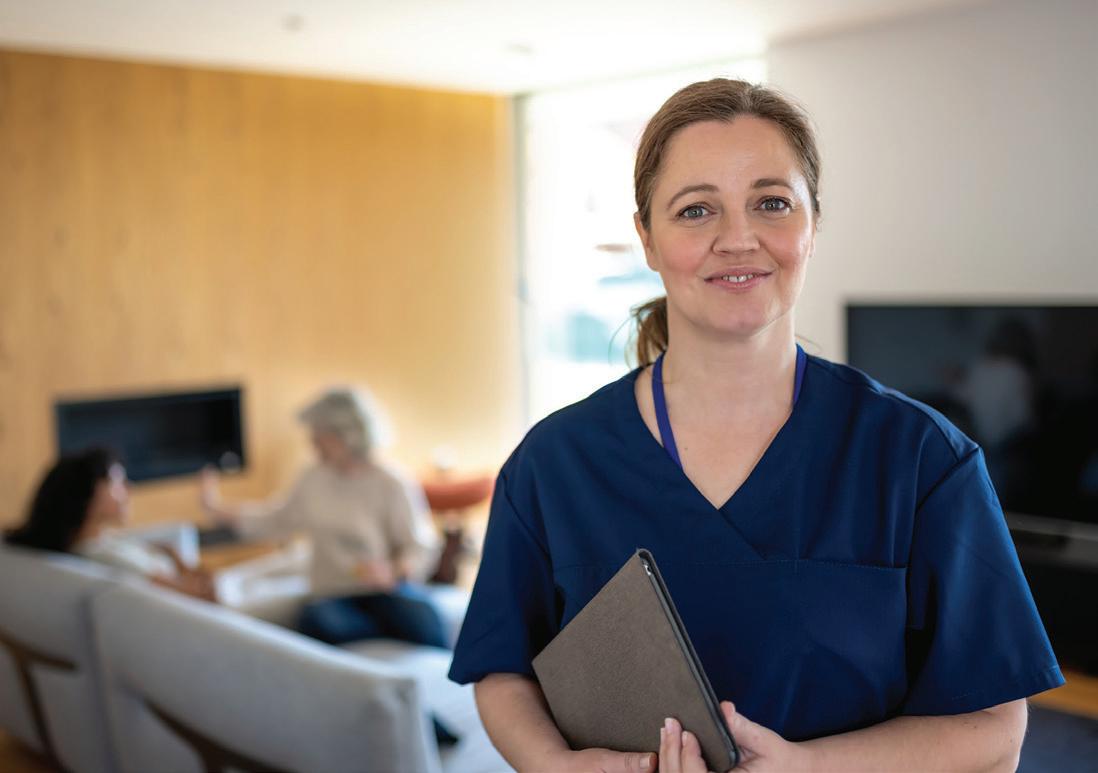

Aged Care is the Place to Be ACCPA is working with eligible Aged & Community Care providers in Queensland to attract, recruit and upskill people aged 15 – 24. Find out more employment.agedservicesworkforce.com.au/acptb This project is proudly funded by the Queensland Government through its Growing Workforce Participation Fund. QIP is your go-to accreditation partner for the Australian Retirement Village Accreditation Scheme (ARVAS) Standards and works with you to ensure your retirement village excels in safety, quality, and resident outcomes. Advancing safety & quality through ARVAS accreditation Key benefits of ARVAS Accreditation Meet national Code of Conduct Standards Your value proposition & competitive advantage To discover the full list of benefits of accreditation with QIP Promote safety & quality through education Commit to a continuous cycle of improvement SCAN HERE 1300 888 329 info@qip.com.au www.qip.com.au Retirement Living

Investing in tomorrow
The imperative of renewable technologies
In the midst of a rumoured recession, aged care facilities confront a critical decision: to cut costs or to invest strategically in future-proofing their operations.
The rationale is not rooted in idealism but in pragmatic, long-term financial and operational sustainability.
With shrinking budgets, the immediate response might be to slash expenditure on new technologies.
However, this perspective overlooks the substantial, enduring benefits of renewable technologies: reducing energy costs to ensure a more sustainable and resilient infrastructure.
What is required is a forward-looking approach that equips these facilities to deliver high-quality care in an economically and environmentally sustainable manner, even in the face of fiscal adversity.
Solar is not a question of ‘if’, but ‘when’
The decision for solar is gaining popularity, given the ever-evolving energy landscape and the clear financial benefits of renewable technology.
A reduction in energy bills is the immediate impact of solar. Leveraging the sun to generate power reduces your reliance on electricity from the grid, which translates into direct savings and hedges against volatile energy prices – vital considerations for facilities on tight budgets.
However, the implementation of solar technology is site-specific and requires careful planning. Facilities should assess their financial capacity and determine whether to maximise their investment immediately for larger benefits or to start small and scale up.
For facilities wanting to benefit from solar but preferring to consider a smaller level of investment, a phased approach could be beneficial.
Starting with a modest installation provides immediate cost savings, which can be reinvested into expanding the solar capacity over time. This strategy aligns with a facility’s financial awareness and gradually increases your energy self-sufficiency.
Savings at Trinity Aged Care
Take Trinity Aged Care for example. In 2020, they engaged Energis to design, supply and install a 98.24kW solar PV
system for their Greensborough site, with expected savings of $1,143,000 over the system’s lifetime – an approximate payback period of three to four years.
George Narikuzhy, Director at Trinity Manor says the new system has exceeded their expectations.
“Since the first installation at Greensborough, we have experienced a substantial reduction in our operational energy costs, with the return on investment surpassing our expectations,” he said.
“Such success prompted our decision in 2023 to further enhance our sustainability efforts. We expanded the solar capacity at the Greensborough site by adding 75.44 kW, incorporating a battery system for added resilience, and simultaneously introduced a new 53.12 kW solar system at our Balwyn site.”
The case for batteries
Batteries can significantly enhance the benefits of solar. However, the financial viability of installing a battery depends on the operational cost savings involved and the specific needs of a facility.
107
BUILT ENVIRONMENT & DESIGN
Solar Installation at Trinity Manor Aged Care, Greensborough.
There are several ways a battery can contribute to operational cost savings.
1. Energy load shifting. Generating energy during the day and storing it for use at night or during peak hours when electricity rates are at their highest, avoids peak tariffs and reduces overall energy costs.
2. More energy independence. Becoming less reliant on grid electricity, especially during outages or periods of high energy demand, ensures consistent power supply for critical medical equipment and the comfort of your residents.
3. Demand response programs: Selling stored energy back to the grid at a higher rate during peak demand periods creates an additional revenue stream.
So, when does investing in batteries make financial sense?
1. Energy usage patterns. A facility with high energy usage during peak hours or at night will benefit more from energy storage, due to the increased potential for load shifting.
2. Size and scale of solar installations. Larger solar setups generate more excess energy during the day, justifying a battery to store and use surplus energy is easier.
3. Local energy costs and incentives. High electricity rates and favourable government incentives can make the investment more attractive and financially viable.
4. Facility’s financial capacity. Facilities with the financial resources to invest, or those that can leverage financing options or incentives, are better positioned to adopt battery storage.
In a time of economic uncertainty, the choice for solar is inevitable, but the



timing and the scale is unique to your facility.
Switching to renewable technologies is a business investment with opportunities extending from significant operational cost savings and beyond.
Aged care facilities that haven’t already, should look to transition from outdated energy models to a solution that’s tailored to their needs.
Reach out to an expert like Energis for guidance in navigating this vital transition. Our focus on crafting renewable energy solutions best suited to businesses ensures that your investment is economically and financially viable, helping you realise operational cost savings sooner.
Energis www.energis.com.au



108 BUILT ENVIRONMENT & DESIGN
www.smithtracey.com.au
3. St Vincent’s Care Services Kew 4. Australian Aged Care Group’s Mt Eliza 5. BASScare Morgan Glen Iris 1. 2. 3. 4. 5. 5. This year, smith+tracey architects celebrate 75 years of practice. During this period we have developed a major presence and awareness within the seniors living, aged care, community and education sectors. We welcome the opportunity to continue our contribution in achieving better designed outcomes for senior living environments.
1. Homestyle Tarneit 2. Chirnside Views Aged
Care
Now is the time for age-friendly communities Design makes
a difference
An age-friendly community is a place that enables people to age well and live a good later life It is a place where people can remain in their homes, participate in the activities they value, and contribute to their communities, for as long as possible.
The age-friendly community concept was developed by the World Health Organization (WHO) in 2007 in consultation with older people around the world.
It comprises both the built and social environments to break down barriers to ageing well, including housing, outdoor spaces, transport, community support and health services, communication and information, participation in civic duties and employment, social activities and respect.
The impact of a new Aged Care Act on design
With the impending draft changes to the Aged Care Act redefining the terminology of a residential care home, it is likely this new definition will lead to the potential repositioning of aged care and retirement living properties.
It could lead to additional controls for retirement living based on the services they provide, so it will be more important than ever to ensure that both active and passive activities are encouraged.
These activities support the residents to interact and connect, contributing to enhanced feelings of belonging, wellbeing and health.
As Daniel Gannon from the Property Council of Australia, Retirement Living Council (RLC) said, “Age-friendly housing can reduce interactions between older Australians, GPs and hospitals, which releases capacity back into health systems for those who need it most when they need it most.”
The RLC national report Better Housing for Better Health (2023) found that retirement living residents are 15 per cent more physically active, 41 per cent happier, five times more socially active, and twice as likely to catch up with family or friends than their residential aged care counterparts.
Fostering a sense of belonging
Wellbeing is now considered a determinant and an outcome of good health. It encompasses subjective elements and reflects many aspects of life including the physical, mental as well as emotional, social, financial, occupational, intellectual and spiritual elements.
But an age-friendly community is more than just having likeminded people residing in one location. It is about the active
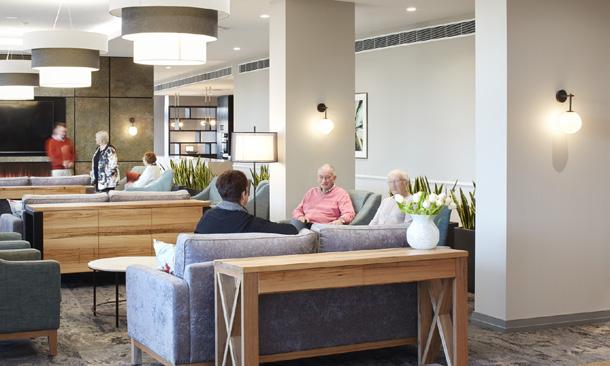
Spaces at Strathalan are designed to facilitate conversation.
participation of those residents coming together in the built environment in activities that interest them most.
The buildings must enable these activities and as such must be designed for easy navigation and inclusivity. The environment both indoors and out should be designed for residents to linger and inhabit the spaces that in turn foster social exchange, and encourage social interaction and gatherings to occur.
Spaces should vary in size, layout and design, and be apparent for their intended purpose while adjacent to highquality outdoor spaces.
The urban layout should include varying points of interest and destinations such as pocket parks, a community centre, a communal garden or dedicated activity zones. The outdoors must be walkable and pedestrian-friendly to encourage gentle exercise and connectivity.
Baptcare’s Strathalan
Baptcare’s Strathalan Integrated Community redevelopment in Melbourne’s Macleod demonstrates the importance of understanding the context, infrastructure and building stock, in relation to constructing an age-friendly community.
To compensate for the steep terrain, Billard Leece Partnership created pathways with rest stops and points of visual interest to encourage exploration and social interaction. We designed a mix of buildings with varying uses that further contribute to the nature of a vibrant community.
A combination of physical design and social infrastructure was vital, in order to support a range of activities.
The structured activities afforded to the residents at Strathalan are second to none, but it is also the other activities the residents organise for themselves that significantly impact their health and wellbeing.
Weekly exercise classes, music appreciation, knitting circles, movie nights, card groups and walking groups occur within the community, making use of the café, wintergarden, gym, lounge bar, library, private dining areas or outside.
Developing contemporary, sustainable, more appropriate age-friendly communities like Strathalan will be essential for supporting the health and wellbeing of residents and our nation, promoting social connections and reducing isolation, into the future.
Emily Gilfillan, Principle I Communities Lead, Billard Leece Partnership www.blp.com.au
109
BUILT ENVIRONMENT & DESIGN
CareLineLive launches in Australia with award-winning home care management software
CareLineLive is one of the leading home care management software providers in the UK where they have over 600 clients. They have now officially launched in Australia with the features of the very best legacy software, such as Procura, but in a modern technology stack.
The company already supports several Australian home care providers including Home Care Nurses Australia, Healthy Life Community Services, Community Nurses Australia and More Than Care.
The software is easy-to-use with onboarding and training included in the price. Implementation is straight forward even if you are moving from another software product.
It is a genuinely all-in-one solution with rostering, care planning, reporting and more. Everything is fully integrated with unified reports and consistent terminology for efficient business operation.
The price is all-in-one as well. There are no set up or training fees for contracts spending at least $200 + GST per month. No additional charges for the carer app and no onerous contracts either. The typical contract length is a standard low-risk 12-month contract. Great price with amazing service for a best-in-class product.
Book a demo today and get 12 months for the price of 10. carelinelive.com.au/10-months


Goldman Plumbing is celebrating sixty remarkable years of dedicated service nationwide!
�oldman �lum�ing is cele��a�ng si�t� �ema��a�le �ea�s o� dedicated se�vice na�on�ide�
�lum�ing is cele��a�ng si�t� �ema��a�le �ea�s o� dedicated se�vice na�on�ide�
serving QLD, NSW, VIC and SA Goldman Plumbing is an industry leader �er plumbing solu�ons throughout the �ealth and Aged Care sectors�
Proudly serving QLD, NSW, VIC and SA Goldman Plumbing is an industry leader providing top tier plumbing solutions throughout the Health and Aged Care sectors.
Proudly serving QLD, NSW, VIC and SA Goldman Plumbing is an industry leader providing top �er plumbing solu�ons throughout the �ealth and Aged Care sectors�
Whilst our expertise spans all sectors, our unparalleled knowledge of hot and warm water systems, water quality management and legionella bacteria control is why we are at the forefront in providing safe and reliable plumbing systems to Aged Care Facilities across Australia.
e�per�se spans all sectors, our unparalleled �nowledge of hot and warm systems, water quality management and legionella bacteria control is why we forefront in providing safe and reliable plumbing systems to Aged Care across Australia
Whilst our e�per�se spans all sectors, our unparalleled �nowledge of hot and warm water systems, water quality management and legionella bacteria control is why we are at the forefront in providing safe and reliable plumbing systems to Aged Care �acili�es across Australia
From design to installation and ongoing maintenance, Goldman Plumbing leads the way in hydraulic services, with over five hundred Health and Aged Care facilities currently benefiting from our services. We test, service and maintain in excess of five thousand Thermostatic Mixing Valves and Backflow Prevention Devices annually.
to installa�on and ongoing maintenance, Goldman Plumbing leads the way services, with over �ve hundred �ealth and Aged Care facili�es currently from our services� We test, service and maintain in e�cess of �ve thousand �i�ing Valves and �ac��ow Preven�on Devices annually�
�rom design to installa�on and ongoing maintenance, Goldman Plumbing leads the way in hydraulic services, with over �ve hundred �ealth and Aged Care facili�es currently bene��ng from our services� We test, service and maintain in e�cess of �ve thousand �hermosta�c �i�ing Valves and �ac��ow Preven�on Devices annually�
Is your workforce stressed, overwhelmed or just need to talk to people who understand their professional challenges? Have you considered peer support?

Contact Goldman Plumbing today to discover how our �� years of �nowledge and e�perience can bene�t your organisa�on�
Goldman Plumbing today to discover how our �� years of �nowledge and e�perience can bene�t your organisa�on�
Contact Goldman Plumbing today to discover how our 60 years of knowledge and experience can benefit your organisation. (02) 8850 6300 - Head Office: 1/10 Anella Avenue, Castle Hill NSW 2154 - goldman.com.au
Hand-n-Hand is a free, confidential and national peer support network for health and aged care workers. Hand-n-Hand links participants with trained facilitators from within the same profession.
(02) 8850 6300 - Head Office: 1/10 Anella Avenue, Castle Hill NSW 2154 - goldman.com.au
Is your workforce stressed, overwhelmed or just need to talk to people who understand their professional challenges? Have you considered peer support?
Is your workforce stressed, overwhelmed or just need to talk to people who understand their professional challenges? Have you considered peer support?

Peer support fosters a supportive environment where workers can share experiences, receive emotional assistance, and exchange practical advice in a trust-based environment.
Hand-n-Hand is a free, confidential and national peer support network for health and aged care workers. Hand-n-Hand links participants with trained facilitators from within the same profession.
Hand-n-Hand is a free, confidential and national peer support network for health and aged care workers. Hand-n-Hand links participants with trained facilitators from within the same profession.
Peer support fosters a supportive environment where workers can share experiences, receive emotional assistance, and exchange practical advice in a trust-based environment.
Through peer support, participants may gain new perspectives and coping strategies, enabling them to handle professional challenges with greater empathy and patience. Ultimately, we believe peer support can help cultivate resilience, professional growth, understanding and help maintain a supportive working environment
Peer support fosters a supportive environment where workers can share experiences, receive emotional assistance, and exchange practical advice in a trust-based environment.
Through peer support, participants may gain new perspectives and coping strategies, enabling them to handle professional challenges with greater empathy and patience. Ultimately, we believe peer support can help cultivate resilience, professional growth, understanding and help maintain a supportive working environment If you think peer support may benefit your organization please visit: www.handnhang.org.au
If you think peer support may benefit your organization please visit: www.handnhang.org.au
Through peer support, participants may gain new perspectives and coping strategies, enabling them to handle professional challenges with greater empathy and patience. Ultimately, we believe peer support can help cultivate resilience, professional growth, understanding and help maintain a supportive working environment

110 WHAT’S NEW
Aura by Livewell is a retirement resort in Findon, South Australia.
Livewell communities want to inspire healthier and safer communities by creating retirement resorts that connect all the residents.
With health and wellness as a high priority, this resort includes a pool and a gymnasium fitted with HUR Smart touch strength training equipment, a wide range cardio equipment, as well as a dedicated platform for balance and cognitive training. The residents are supported by an in-house exercise physiologist who is onsite three days per week.
Active Ageing culture is seen in the gym user numbers. In the last six months, the number of users has tripled, with almost 50% of the residents currently actively exercising. Even bigger growth has been seen in the number of gym visits that have quadrupled, when comparing visits in June 2023 and January 2024. The gym will be even busier once the residents return from holidays. www.huraustralia.com.au/
Supporting Thriving Community Care
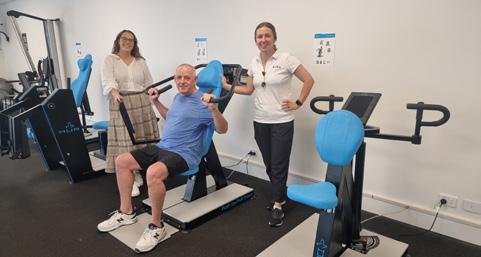
Pontem is a social enterprise devoted to supporting thriving Community Care. We work with Community Care businesses of all sizes to understand their business challenges and offer targeted solutions that improve financial outcomes, compliance and client focus. Our online learning courses support leaders build solid business management skills and comprise of digital learning modules as well as facilitated sessions to help grow your support network.
Our consultancy services include business health checks, governance reviews, facilitated strategic planning sessions, ICT reviews (infrastructure and applications), scheduling optimisation and systems implementation support. Focused on delivering real outcomes, we strive to enhance business value. Contact us today to discuss how we can support your business. www.pontem.com.au
Soodox™ Soothe & Protect Barrier Cream


Maintaining healthy skin is crucial for overall health and well-being. Soodox™ Soothe & Protect Barrier Cream is an excellent preventive measure against skin irritation caused by occupational exposure to irritants. This is where barrier creams are effective, now available is Soodox™ Soothe & Protect Barrier Cream which is Australian made, 100% natural, paraffin and fragrance free. It is gentle enough to use on the most sensitive areas - incontinence rash, skin folds, under breasts, bedsores, and chafing. This cream is highly recommended for use before and during work, as it forms a lubricating film on the skin, preventing water depletion in the skin’s outermost layer.
This protective effect may help prevent irritant contact dermatitis and allergic contact dermatitis, which are common conditions that often result from moisture depletion. It is essential to choose a product that is suitable for your skin type and needs, Soodox™ Soothe & Protect Barrier Cream is the perfect choice!
www.aussiepharmadirect.com.au
“Saying

Sorry” when things go wrong is one of the most important actions an organisation can take.
It humanises an event. It puts the person at the centre of your response. It often leads to a sense of satisfaction and trust that it won’t happen again.
However, it is often met with fear of litigation, or the “insurer doesn’t support it” or is conducted in a way that worsens the issue.
To find out more visit https://www.ansvar.com.au
Ansvar has brought together experts to guide your organisation through “Open Disclosure”.
It is a practical approach to take action and to share important information between your board, management and staff to support your approach; because getting it right and doing it well is so important in so many ways.
111 WHAT’S NEW
The Aged Care sector’s preferred Salary Packaging partner
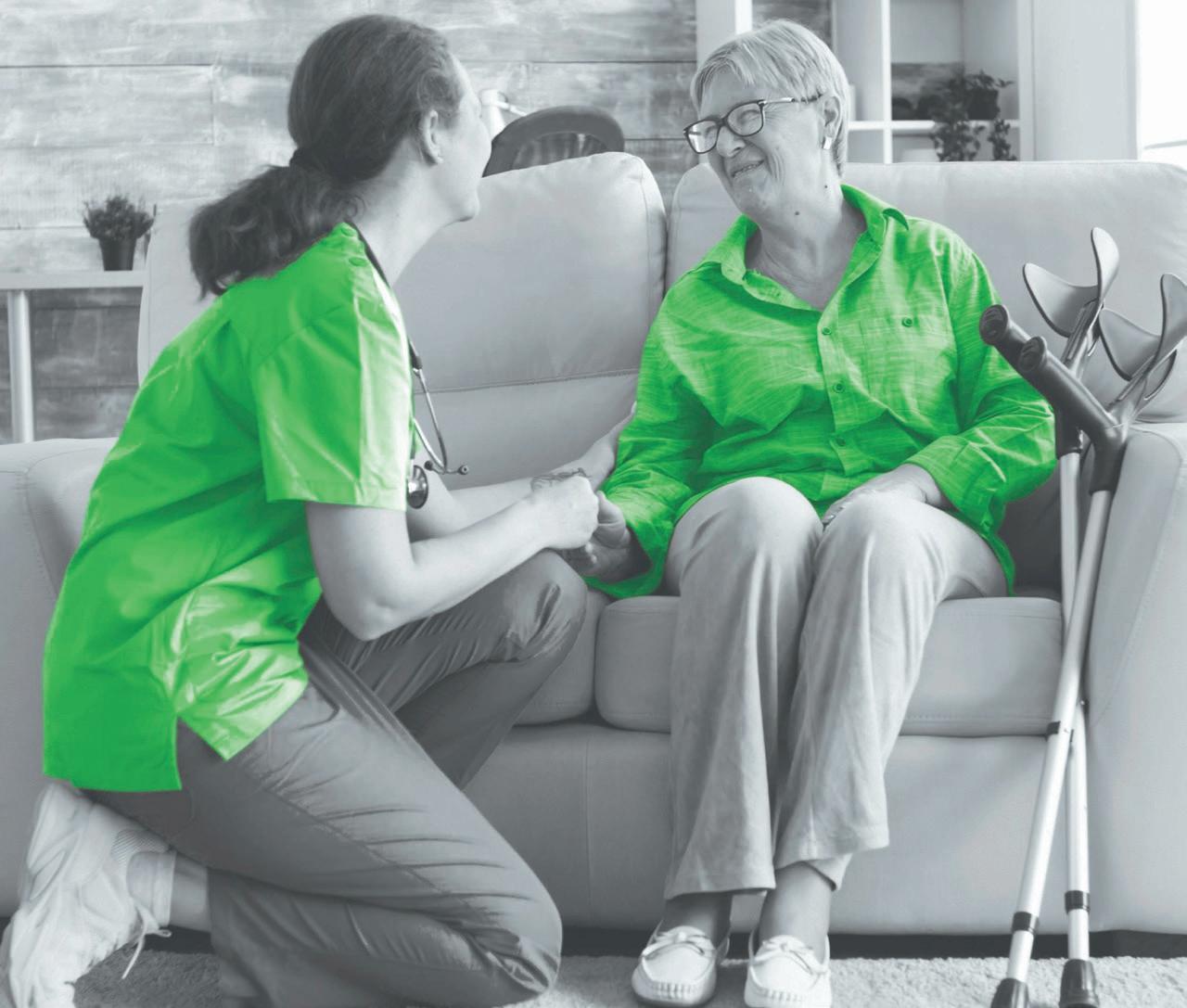

Personalised service for the care giving industry SALARY PACKAGING



































































































































 Cassie Zlonzak, Communications Manager, VMCH www.vmch.com.au
Cassie Zlonzak, Communications Manager, VMCH www.vmch.com.au






























































































































